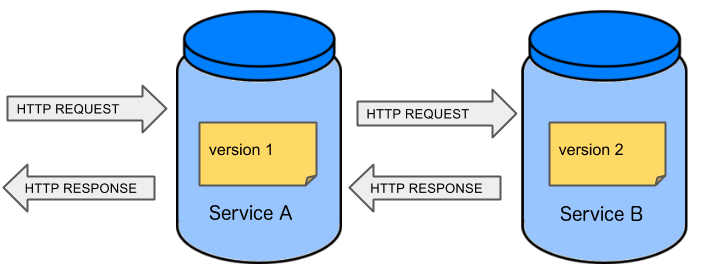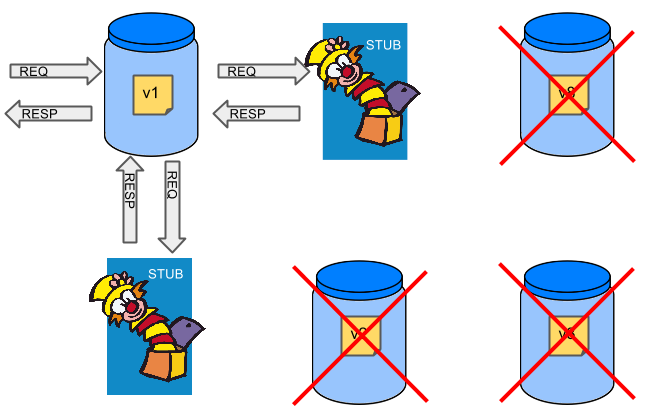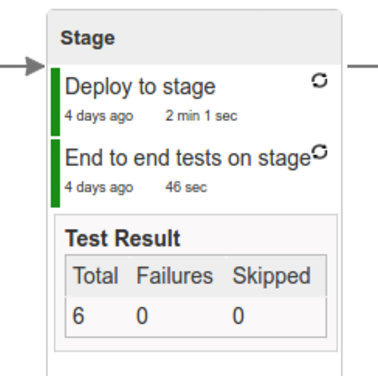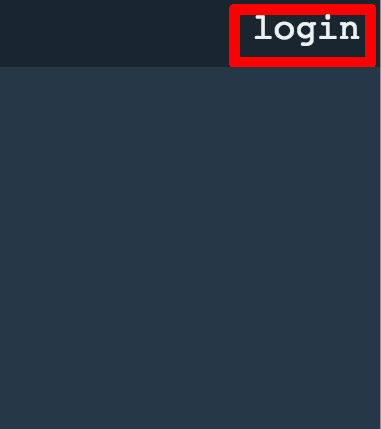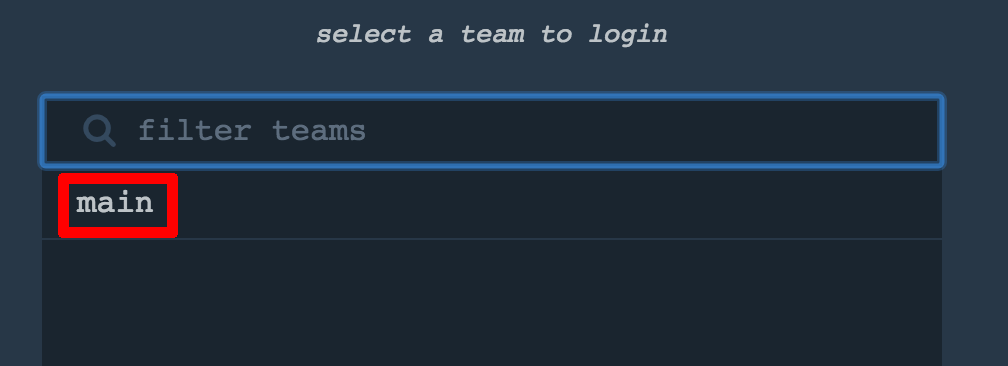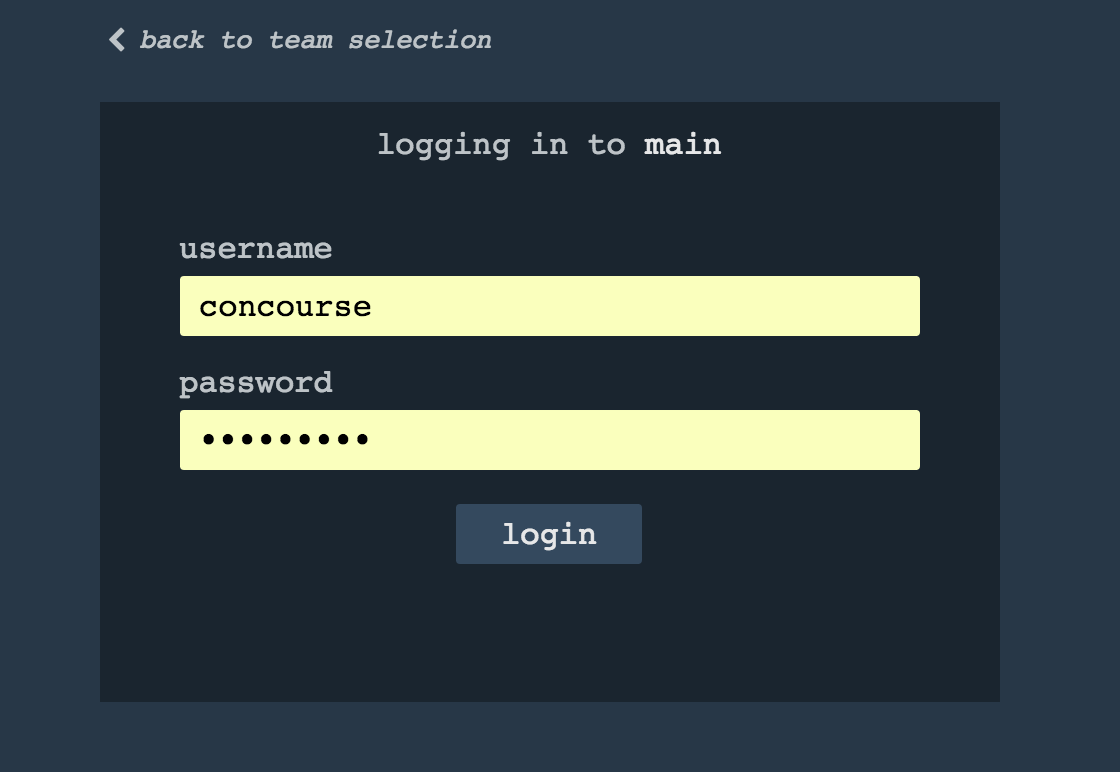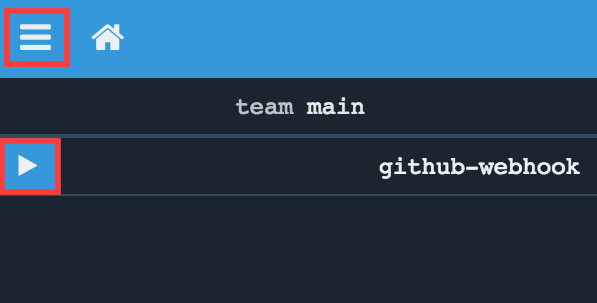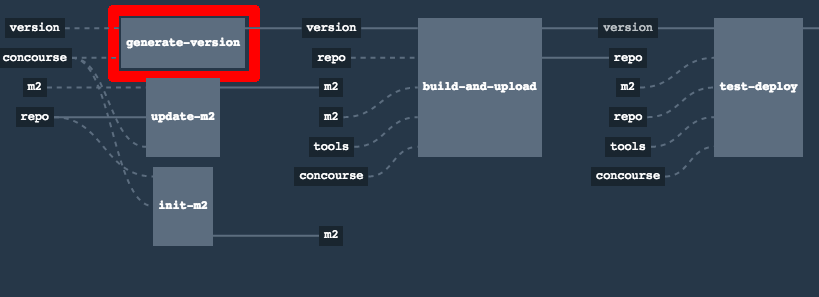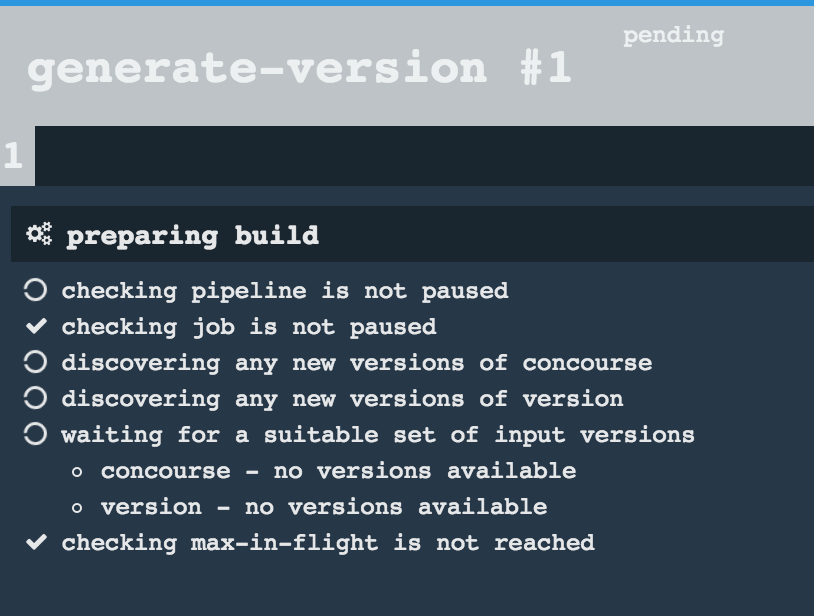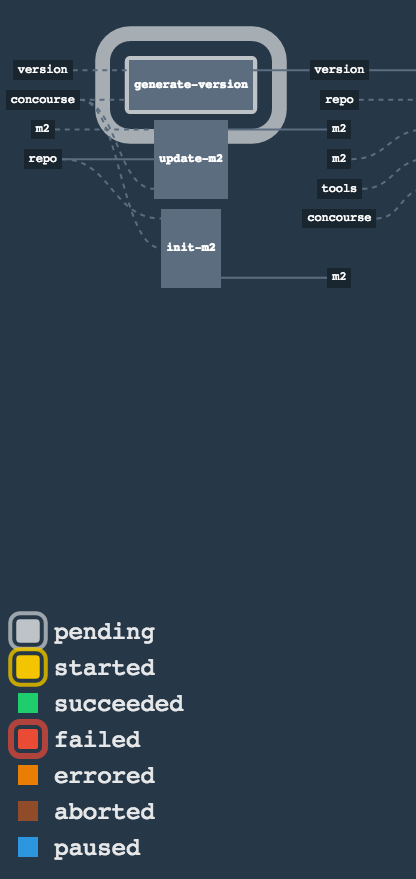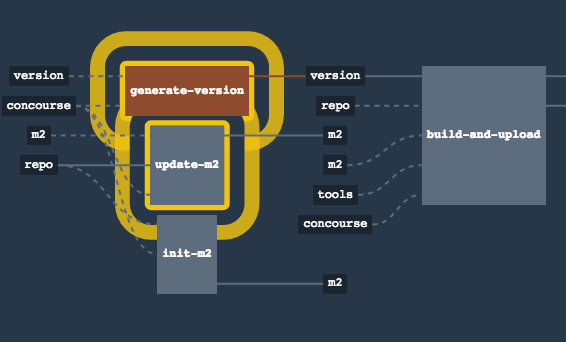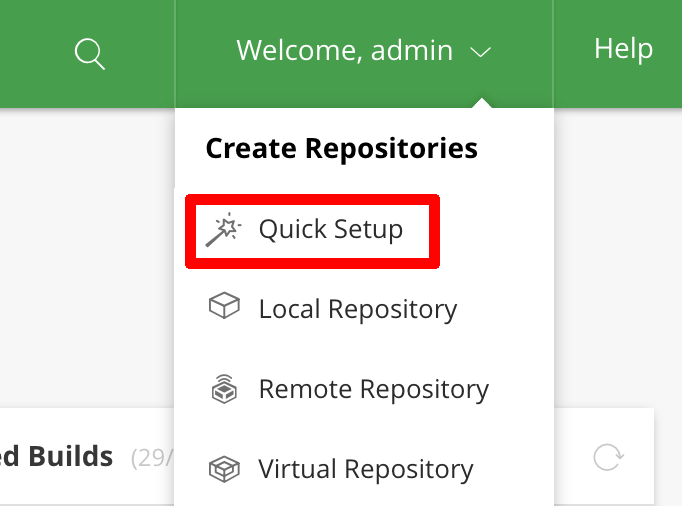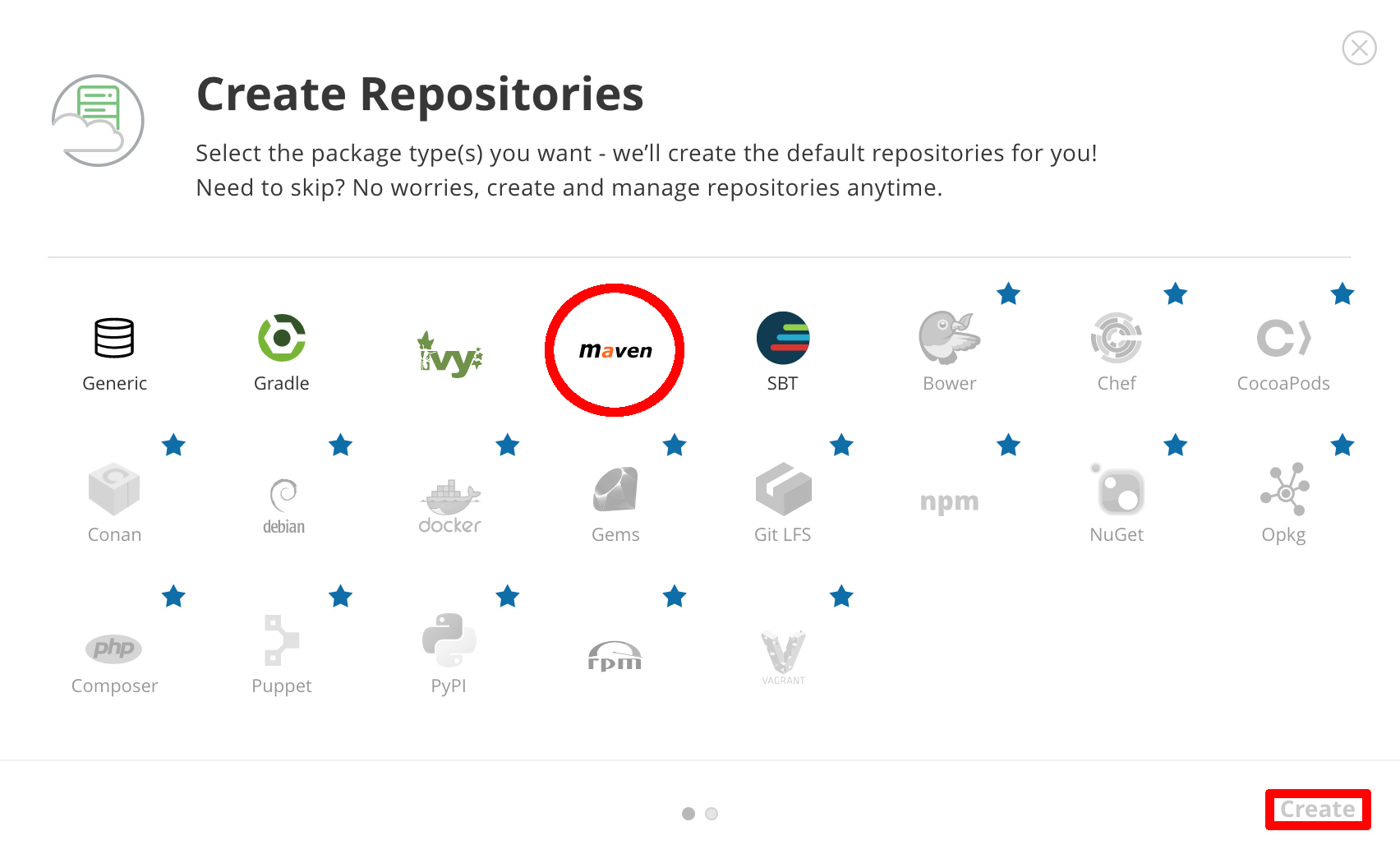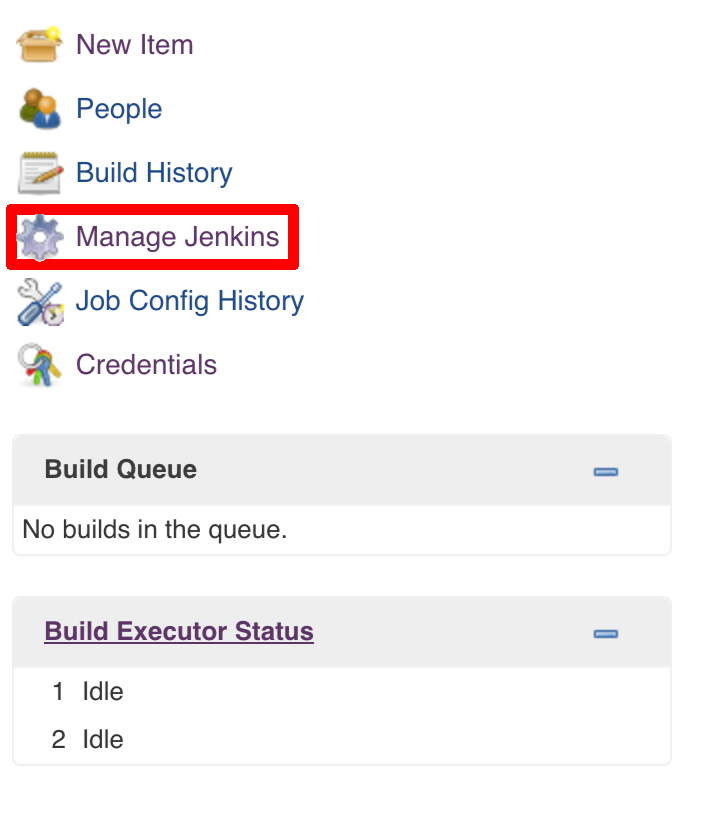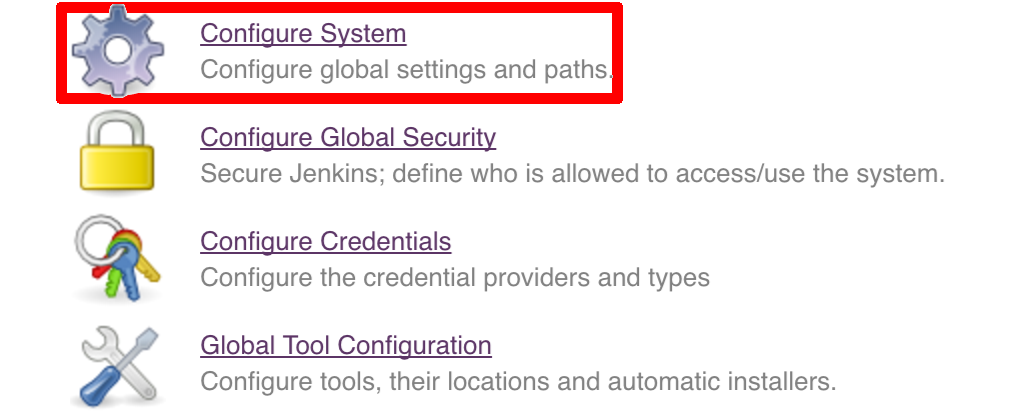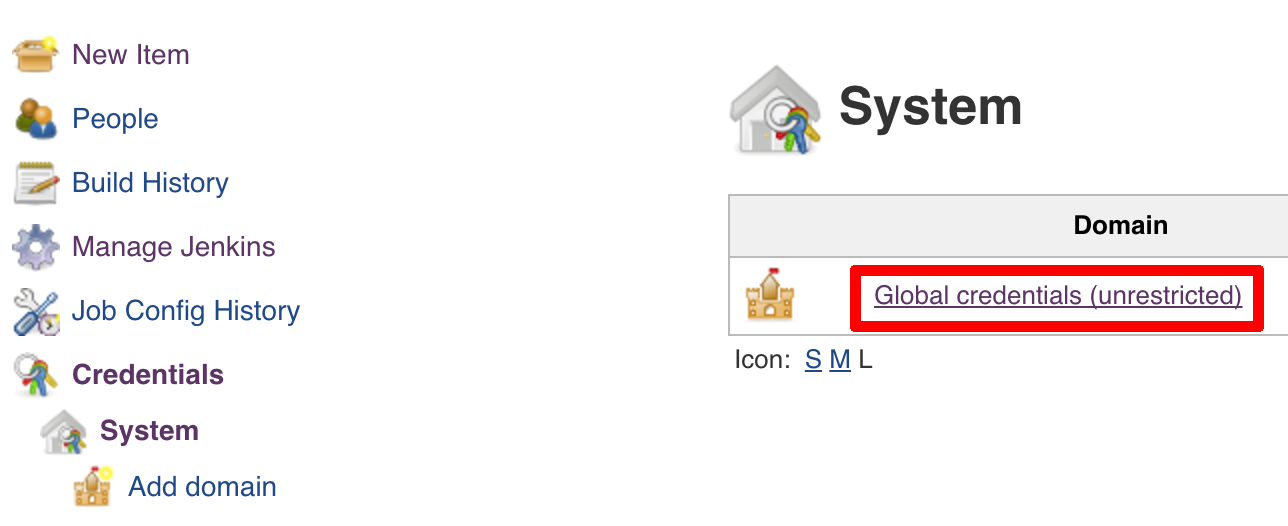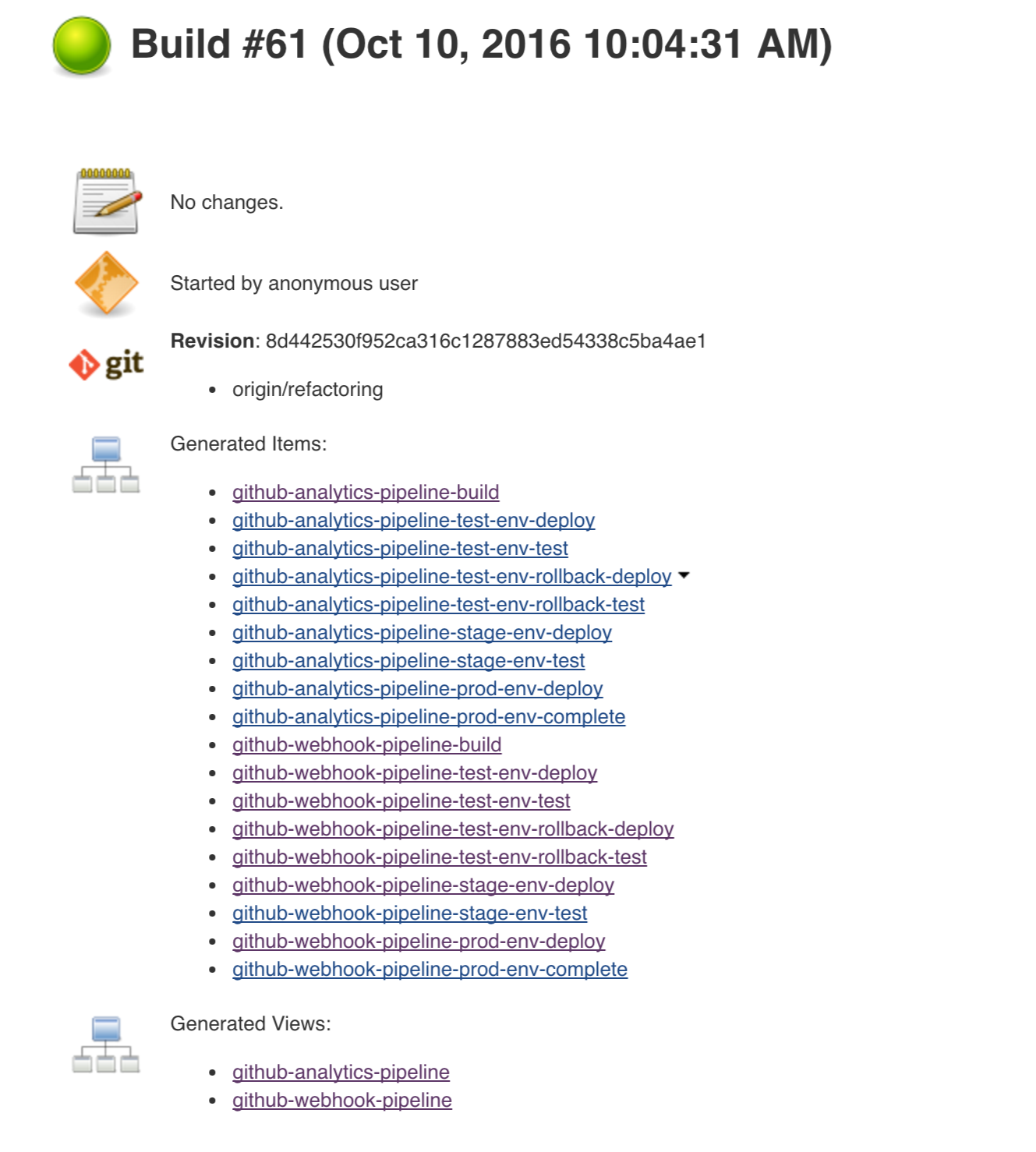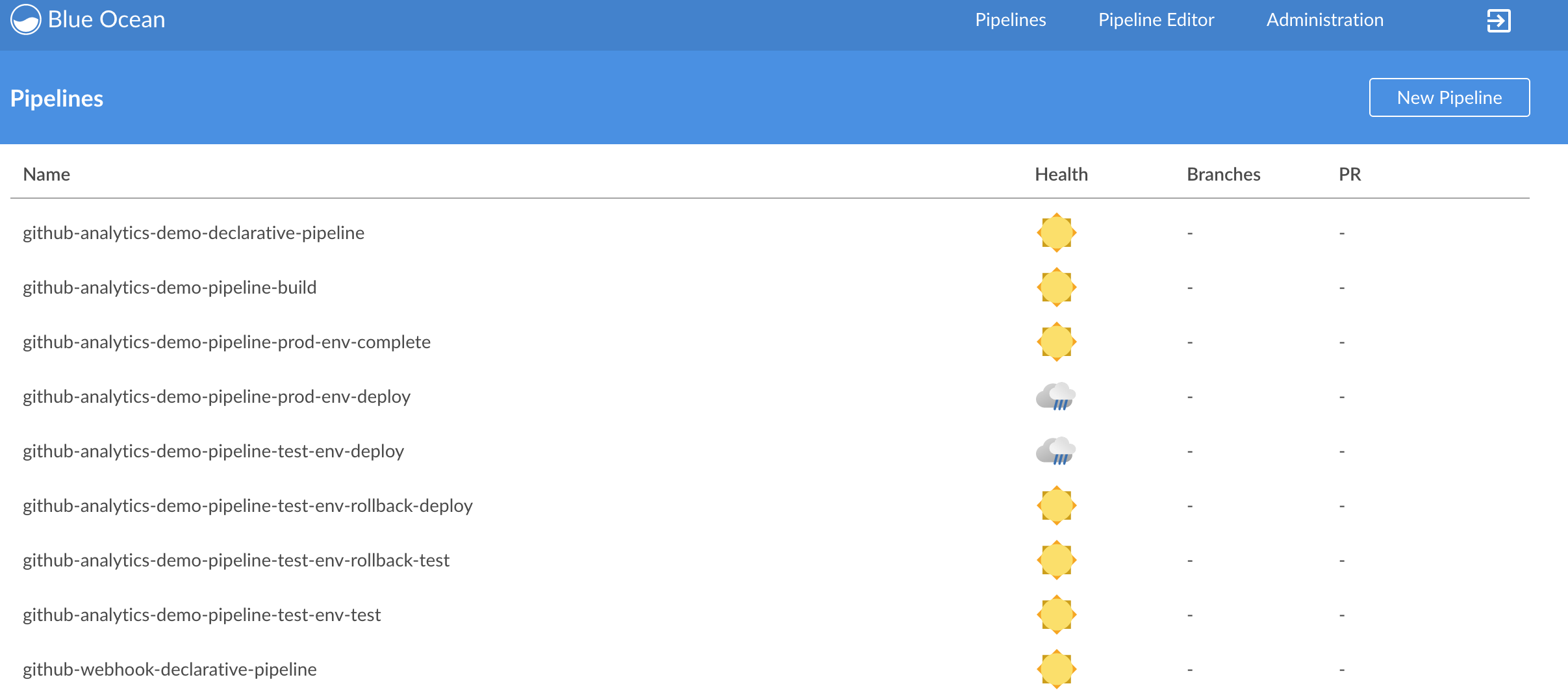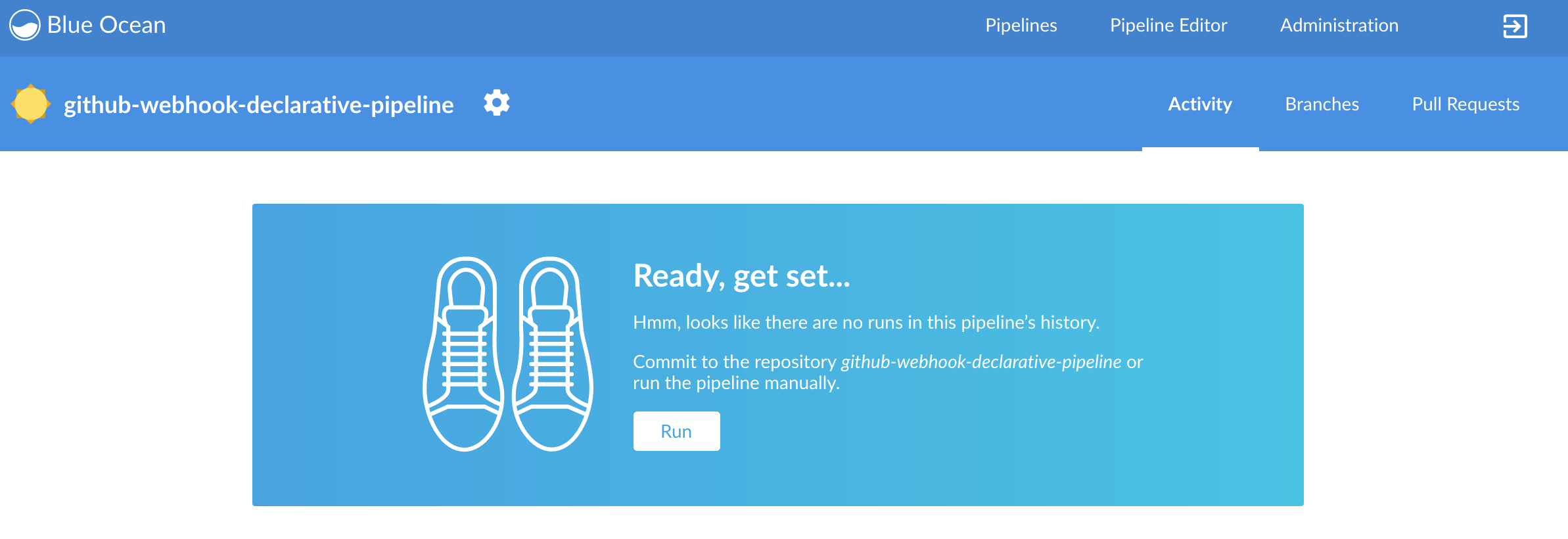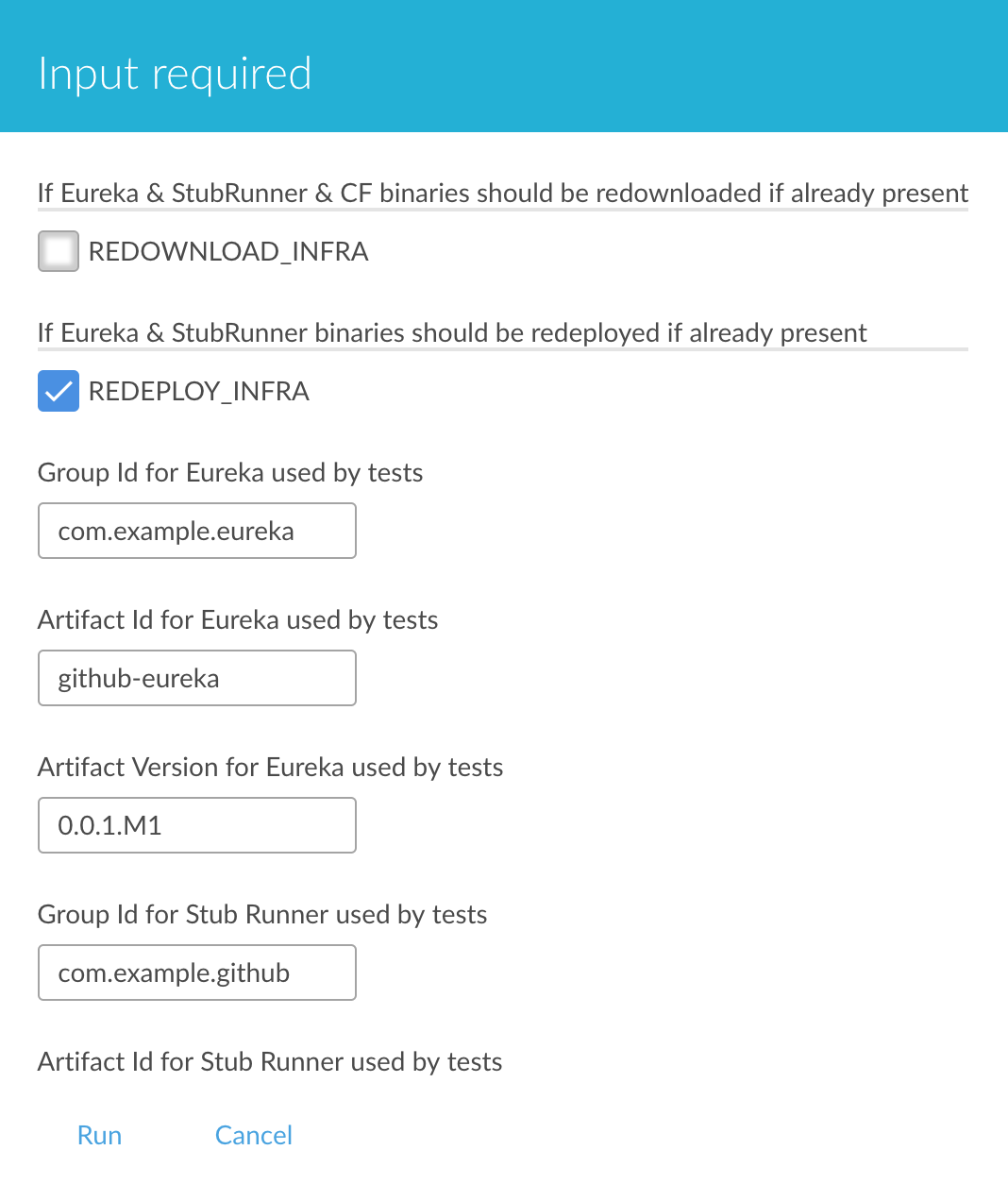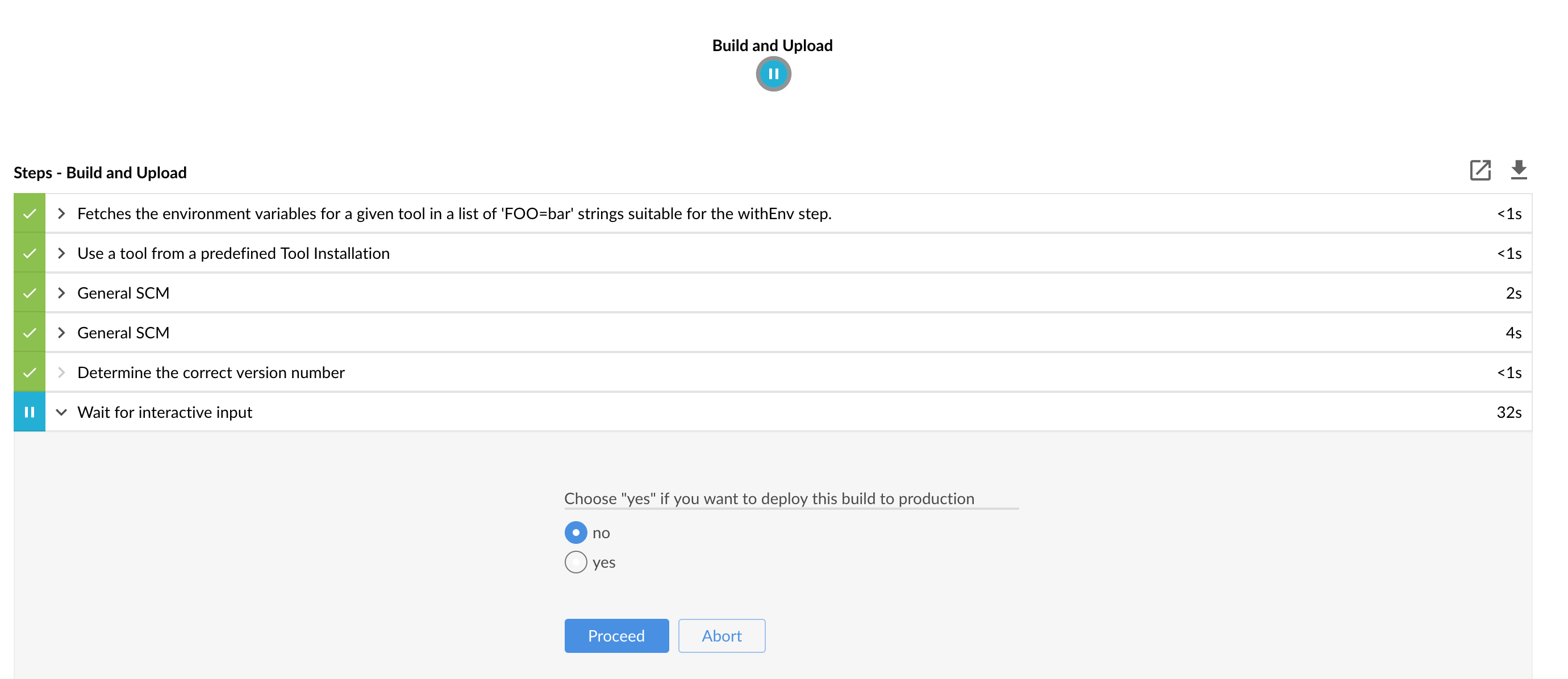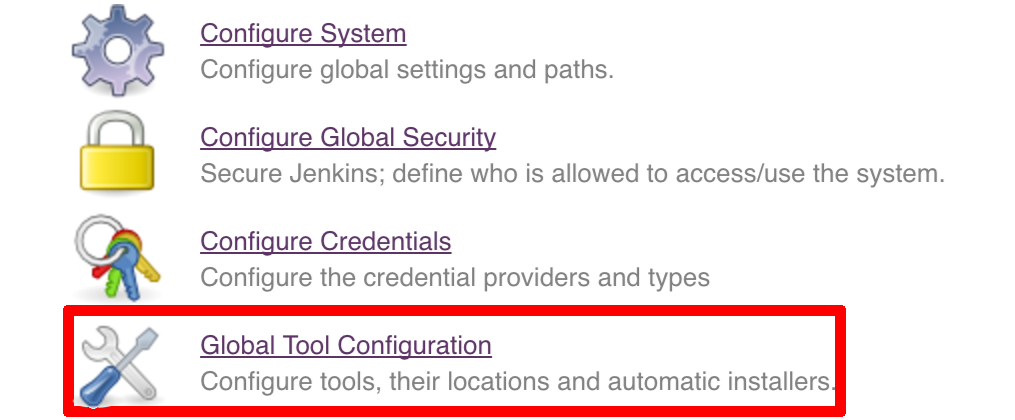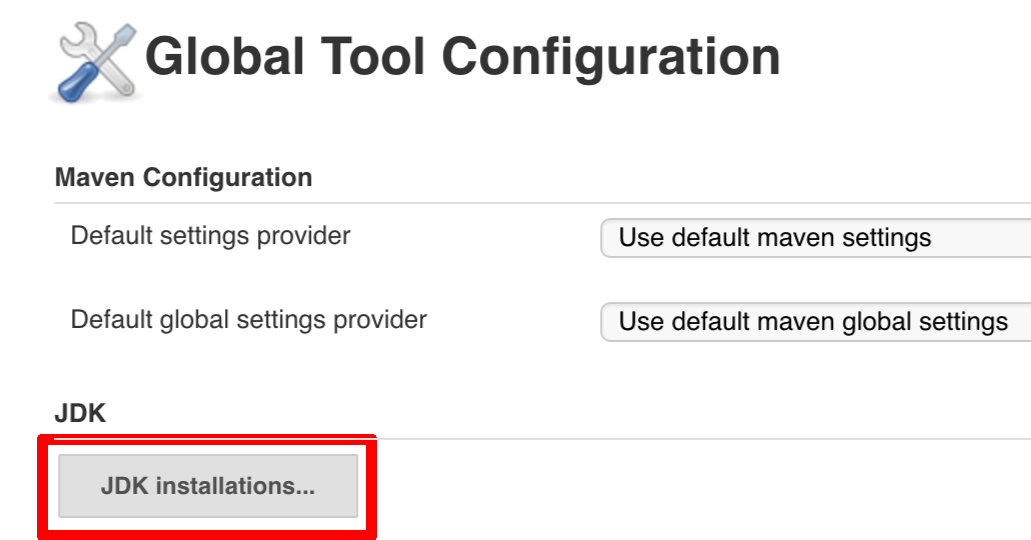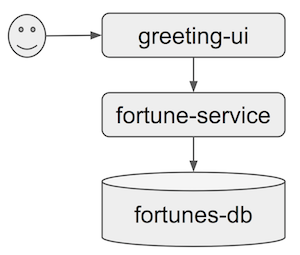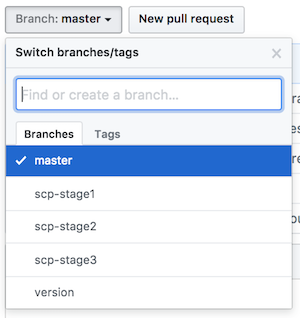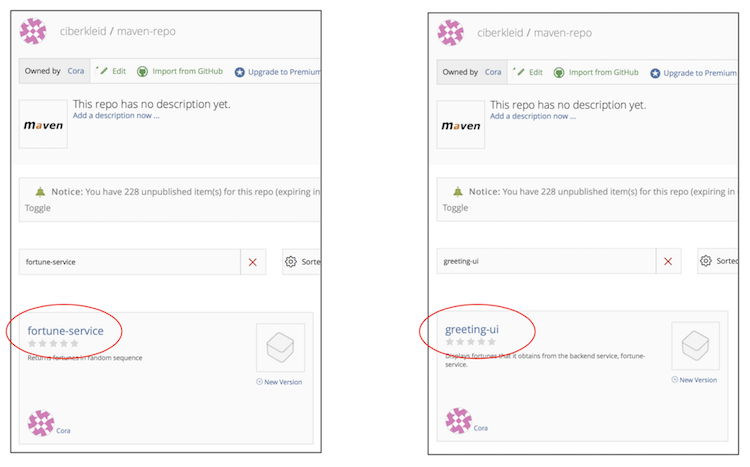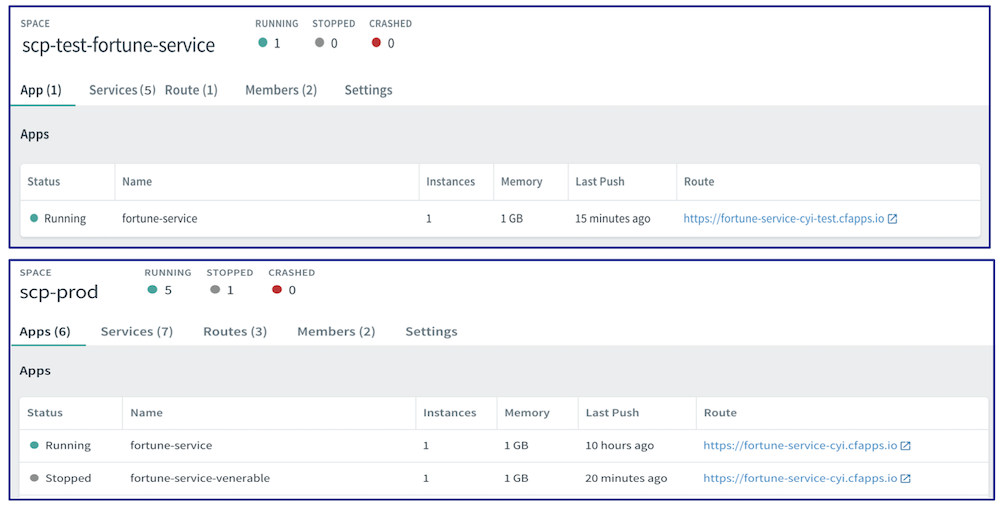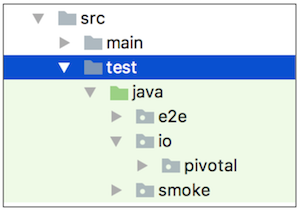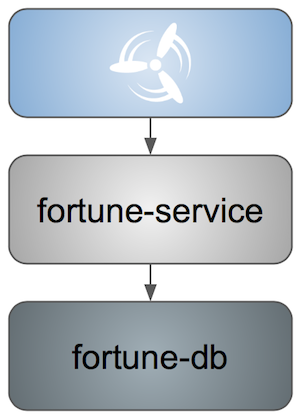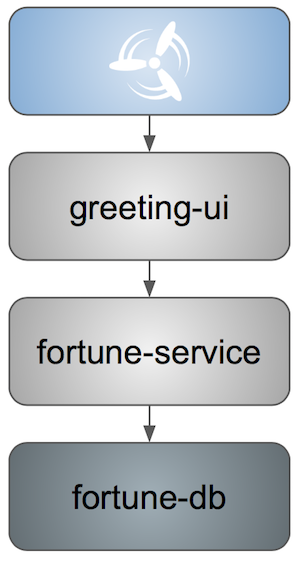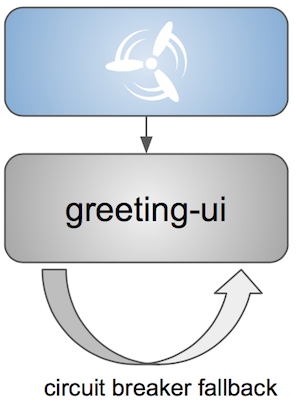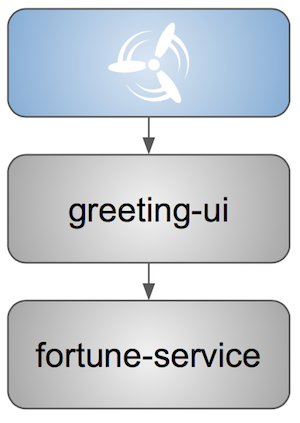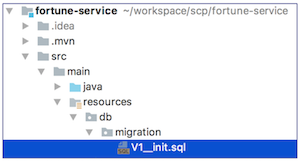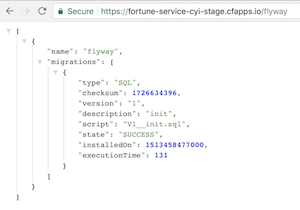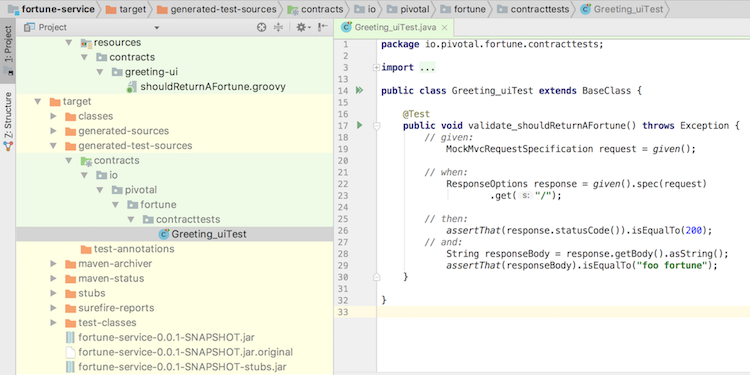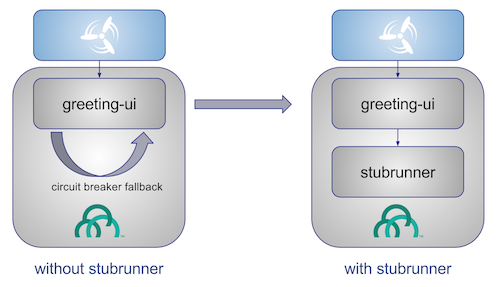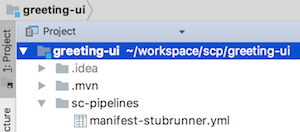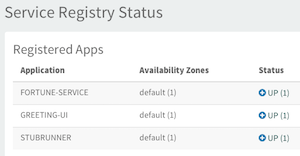Table of Contents
- 1. Introduction
- 2. Opinionated implementation
- 3. Project opinions
- 4. Concourse Pipeline (Cloud Foundry)
- 5. Concourse Pipeline (Kubernetes)
- 6. Concourse FAQ
- 6.1. Can I use the pipeline for some other repos?
- 6.2. Will this work for ANY project out of the box?
- 6.3. Can I modify this to reuse in my project?
- 6.4. I ran out of resources!! (PCF Dev)
- 6.5. The rollback step fails due to missing JAR ?!
- 6.6. Can I see the output of a job from the terminal?
- 6.7. I clicked the job and it’s constantly pending…
- 6.8. The route is already in use (CF)
- 6.9. I’m unauthorized to deploy infrastructure jars
- 6.10.
versionresource is broken
- 7. Jenkins Pipeline (Common)
- 8. Jenkins Pipeline (Cloud Foundry)
- 9. Jenkins Pipeline (Kubernetes)
- 10. Jenkins FAQ
- 10.1. Pipeline version contains ${PIPELINE_VERSION}
- 10.2. Pipeline version is not passed to the build
- 10.3. The build times out with
pipeline.shinfo - 10.4. Can I use the pipeline for some other repos?
- 10.5. Will this work for ANY project out of the box?
- 10.6. Can I modify this to reuse in my project?
- 10.7. The rollback step fails due to missing JAR ?!
- 10.8. I want to provide a different JDK version
- 10.9. Enable Groovy Token Macro Processing
- 10.10. I want deployment to stage and prod be automatic
- 10.11. I don’t want to test API compativility
- 10.12. I can’t tag the repo!
- 10.13. I’m unauthorized to deploy infrastructure jars
- 10.14. Signing Artifacts
- 10.15. Using SSH keys for git
- 10.16. Deploy to stage fails and doesn’t redeploy a service (Kubernetes)
- 10.17. I ran out of resources!! (Cloud Foundry)
- 10.18. Deploying to test / stage / prod fails - error finding space (Cloud Foundry)
- 10.19. The route is already in use (Cloud Foundry)
- 10.20. How to execute helper scripts against a real CF instance I’m logged into (Cloud Foundry)
- 11. Kubernetes setup
- 12. The demo setup (Cloud Foundry)
- 13. The demo setup (Kubernetes)
- 14. Step-by-step Cloud Foundry migration
- 14.1. Preview
- 14.2. Introduction
- 14.3. Sample application - initial state
- 14.4. Sample application - end state
- 14.5. Tutorial - toolset
- 14.6. Tutorial - overview
- 14.7. Tutorial - step-by-step
- 14.7.1. Prep: Before you begin
- 14.7.2. Stage 1: Scaffolding
- 1.1 Create GitHub branches
- 1.2 Add Maven wrapper
- 1.3 Create Bintray maven repo package
- 1.4 Configure distribution management using Bintray maven repo
- 1.5 Push changes to GitHub
- 1.6 Add Spring Cloud Pipelines credentials file
- 1.7 Set Concourse pipeline
- 1.8 Add Cloud Foundry manifest
- 1.9 Add Spring Cloud Pipelines manifest
- 1.10 Push changes to GitHub
- 1.11 Create Cloud Foundry Orgs/Spaces
- 1.12 Create Cloud Foundry stage and prod service instances
- 1.13 Update Spring Cloud Pipelines credentials file
- 1.14 Update Concourse pipeline with updated credentials files
- Stage 1 Recap & next steps
- 14.7.3. Stage 2: Tests
- 14.7.4. Stage 3: Contracts
- 3.1 Create a contract
- 3.2 Create a base class for contract tests
- 3.3 Enable automated contract-based testing
- 3.4 Enable backward compatibility API check
- 3.5 Push changes to GitHub
- 3.6 Re-run the fortune-service pipeline
- 3.7 Enable stubs for integration tests
- 3.8 Enable stubs for smoke tests
- 3.9 Push changes to GitHub
- Stage 3 Recap
- 14.8. Conclusion
- 15. Building the project
- 16. Customizing the project
- 17. Releasing the project
Documentation Authors: Marcin Grzejszczak, Cora Iberkleid
Spring, Spring Boot and Spring Cloud are tools that allow developers speed up the time of creating new business features. It’s common knowledge however that the feature is only valuable if it’s in production. That’s why companies spend a lot of time and resources on building their own deployment pipelines.
This project tries to solve the following problems:
- Creation of a common deployment pipeline
- Propagation of good testing & deployment practices
- Speed up the time required to deploy a feature to production
A common way of running, configuring and deploying applications lowers support costs and time needed by new developers to blend in when they change projects.
In the following section we will describe in more depth the rationale behind the presented opinionated pipeline. We will go through each deployment step and describe it in details.
![[Important]](images/important.png) | Important |
|---|---|
You don’t need to use all pieces of Spring Cloud Pipelines. You can (and should) gradually migrate your applications to use those pieces of Spring Cloud Pipelines that you think best suit your needs. |
. ├── common ├── concourse ├── dist ├── docs ├── docs-sources └── jenkins
In the common folder you can find all the Bash scripts containing the pipeline logic. These
scripts are reused by both Concourse and Jenkins pipelines.
In the concourse folder you can find all the necessary scripts and setup to run Concourse demo.
In the dist folder you can find the packaged sources of the project. Since the package
contains no tests or documentation it’s extremely small and can be used in the pipelines.
In the docs folder you have the whole generated documentation of the project.
In the docs-source folder you have the sources required to generate the documentation.
In the jenkins folder you can find all the necessary scripts and setup to run Jenkins demo.
This repository can be treated as a template for your pipeline. We provide some opinionated implementation that you can alter to suit your needs. The best approach to use it to build your production projects would be to download the Spring Cloud Pipelines repository as ZIP, then init a Git project there and modify it as you wish.
$ # pass the branch (e.g. master) or a particular tag (e.g. v1.0.0.RELEASE) $ SC_PIPELINES_RELEASE=... $ curl -LOk https://github.com/spring-cloud/spring-cloud-pipelines/archive/${SC_PIPELINES_RELEASE}.zip $ unzip ${SC_PIPELINES_RELEASE}.zip $ cd spring-cloud-pipelines-${SC_PIPELINES_RELEASE} $ git init $ # modify the pipelines to suit your needs $ git add . $ git commit -m "Initial commit" $ git remote add origin ${YOUR_REPOSITORY_URL} $ git push origin master
You can also clone the repository in case you would like to keep aligned
with the changes in the upstream repository. In order not to have many merge
conflicts it’s encouraged to use the custom folder hooks to override functions.
You can use Spring Cloud Pipelines to generate pipelines for all projects in your system. You can scan all your repositories (e.g. call the Stash / Github API and retrieve the list of repos) and then…
- For Jenkins, call the seed job and pass the
REPOSparameter that would contain the list of repositories - For Concourse, you’d have to call
flyand set pipeline for every single repo
You can use Spring Cloud Pipelines in such a way that each project contains its own pipeline definition in its code. Spring Cloud Pipelines clones the code with the pipeline definitions (the bash scripts) so the only piece of logic that could be there in your application’s repository would be how the pipeline should look like.
- For Jenkins, you’d have to either set up the
Jenkinsfileor the jobs using Jenkins Job DSL plugin in your repo. Then in Jenkins whenever you set up a new pipeline for a repo then you reference the pipeline definition in that repo. - For Concourse, each project contains its own pipeline steps and it’s up to the project to set up the pipeline.
Let’s take a look at the flow of the opinionated pipeline
We’ll first describe the overall concept behind the flow and then we’ll split it into pieces and describe every piece independently.
So we’re on the same page let’s define some common vocabulary. We discern 4 typical environments in terms of running the pipeline.
- build environment is a machine where the building of the application takes place. It’s a CI / CD tool worker.
- test is an environment where you can deploy an application to test it. It doesn’t resemble production, we can’t be sure of it’s state (which application is deployed there and in which version). It can be used by multiple teams at the same time.
- stage is an environment that does resemble production. Most likely applications are deployed there in versions that correspond to those deployed to production. Typically databases there are filled up with (obfuscated) production data. Most often this environment is a single, shared one between many teams. In other words in order to run some performance, user acceptance tests you have to block and wait until the environment is free.
- prod is a production environment where we want our tested applications to be deployed for our customers.
Unit tests - tests that are executed on the application during the build phase. No integrations with databases / HTTP server stubs etc. take place. Generally speaking your application should have plenty of these to have fast feedback if your features are working fine.
Integration tests - tests that are executed on the built application during the build phase. Integrations with in memory databases / HTTP server stubs take place. According to the test pyramid, in most cases you should have not too many of these kind of tests.
Smoke tests - tests that are executed on a deployed application. The concept of these tests is to check the crucial parts of your application are working properly. If you have 100 features in your application but you gain most money from e.g. 5 features then you could write smoke tests for those 5 features. As you can see we’re talking about smoke tests of an application, not of the whole system. In our understanding inside the opinionated pipeline, these tests are executed against an application that is surrounded with stubs.
End to end tests - tests that are executed on a system composing of multiple applications. The idea of these tests is to check if the tested feature works when the whole system is set up. Due to the fact that it takes a lot of time, effort, resources to maintain such an environment and that often those tests are unreliable (due to many different moving pieces like network database etc.) you should have a handful of those tests. Only for critical parts of your business. Since only production is the key verifier of whether your feature works, some companies don’t even want to do those and move directly to deployment to production. When your system contains KPI monitoring and alerting you can quickly react when your deployed application is not behaving properly.
Performance testing - tests executed on an application or set of applications to check if your system can handle big load of input. In case of our opinionated pipeline these tests could be executed either on test (against stubbed environment) or stage (against the whole system)
Before we go into details of the flow let’s take a look at the following example.
When having only a handful of applications, performing end to end testing is beneficial. From the operations perspective it’s maintainable for a finite number of deployed instances. From the developers perspective it’s nice to verify the whole flow in the system for a feature.
In case of microservices the scale starts to be a problem:
The questions arise:
Should I queue deployments of microservices on one testing environment or should I have an environment per microservice?
- If I queue deployments people will have to wait for hours to have their tests ran - that can be a problem
To remove that issue I can have an environment per microservice
- Who will pay the bills (imagine 100 microservices - each having each own environment).
- Who will support each of those environments?
- Should we spawn a new environment each time we execute a new pipeline and then wrap it up or should we have them up and running for the whole day?
In which versions should I deploy the dependent microservices - development or production versions?
- If I have development versions then I can test my application against a feature that is not yet on production. That can lead to exceptions on production
- If I test against production versions then I’ll never be able to test against a feature under development anytime before deployment to production.
One of the possibilities of tackling these problems is to… not do end to end tests.
If we stub out all the dependencies of our application then most of the problems presented above disappear. There is no need to start and setup infrastructure required by the dependant microservices. That way the testing setup looks like this:
Such an approach to testing and deployment gives the following benefits (thanks to the usage of Spring Cloud Contract):
- No need to deploy dependant services
- The stubs used for the tests ran on a deployed microservice are the same as those used during integration tests
- Those stubs have been tested against the application that produces them (check Spring Cloud Contract for more information)
- We don’t have many slow tests running on a deployed application - thus the pipeline gets executed much faster
- We don’t have to queue deployments - we’re testing in isolation thus pipelines don’t interfere with each other
- We don’t have to spawn virtual machines each time for deployment purposes
It brings however the following challenges:
- No end to end tests before production - you don’t have the full certainty that a feature is working
- First time the applications will talk in a real way will be on production
Like every solution it has its benefits and drawbacks. The opinionated pipeline allows you to configure whether you want to follow this flow or not.
The general view behind this deployment pipeline is to:
- test the application in isolation
- test the backwards compatibility of the application in order to roll it back if necessary
- allow testing of the packaged app in a deployed environment
- allow user acceptance tests / performance tests in a deployed environment
- allow deployment to production
Obviously the pipeline could have been split to more steps but it seems that all of the aforementioned actions comprise nicely in our opinionated proposal.
Spring Cloud Pipelines uses Bash scripts extensively. Below you can find the list of software that needs to be installed on a CI server worker for the build to pass.
![[Tip]](images/tip.png) | Tip |
|---|---|
In the demo setup all of these libraries are already installed. |
apt-get -y install \
bash \
git \
tar \
zip \
curl \
ruby \
wget \
unzip \
python \
jq![[Important]](images/important.png) | Important |
|---|---|
In the Jenkins case you will also need |
Each application can contain a file called sc-pipelines.yml with the following structure:
build: main_module: foo/bar lowercaseEnvironmentName1: services: - type: service1Type name: service1Name coordinates: value - type: service2Type name: service2Name key: value lowercaseEnvironmentName2: services: - type: service3Type name: service3Name coordinates: value - type: service4Type name: service4Name key: value
If you have a multi-module project, you should point to the folder, where your
module that produces the fat jar lays. In the aforementioned example that module
would be present under the foo/bar folder. If you have a single module project,
then you don’t have to create this section.
For a given environment we declare a list of infrastructure services that we want to have deployed. Services have
type(example:eureka,mysql,rabbitmq,stubrunner) - this value gets then applied to thedeployServiceBash function- [KUBERNETES] for
mysqlyou can pass the database name via thedatabaseproperty name- name of the service to get deployedcoordinates- coordinate that allows you to fetch the binary of the service. Examples: It can be a maven coordinategroupid:artifactid:version, docker imageorganization/nameOfImage, etc.- arbitrary key value pairs - you can customize the services as you wish
When deploying to Cloud Foundry you can provide services of the following types:
type: brokerbroker- name of the CF brokerplan- name of the planparams- additional parameters that will be converted to JSONuseExisting- should use existing one or create a new one (defaults tofalse)
type: appcoordinates- maven coordinates of the stub runner jarmanifestPath- path to the manifest for the stub runner jar
type: cupsparams- additional parameters that will be converted to JSON
type: cupsSyslogurl- URL to the syslog drain
type: cupsRouteurl- URL to the route service
type: stubrunnercoordinates- maven coordinates of the stub runner jarmanifestPath- path to the manifest for the stub runner jar
# This file describes which services are required by this application # in order for the smoke tests on the TEST environment and end to end tests # on the STAGE environment to pass # lowercase name of the environment test: # list of required services services: - name: config-server type: broker broker: p-config-server plan: standard params: git: uri: https://github.com/ciberkleid/app-config useExisting: true - name: cloud-bus type: broker broker: cloudamqp plan: lemur useExisting: true - name: service-registry type: broker broker: p-service-registry plan: standard useExisting: true - name: circuit-breaker-dashboard type: broker broker: p-circuit-breaker-dashboard plan: standard useExisting: true - name: stubrunner type: stubrunner coordinates: io.pivotal:cloudfoundry-stub-runner-boot:0.0.1.M1 manifestPath: sc-pipelines/manifest-stubrunner.yml stage: services: - name: config-server type: broker broker: p-config-server plan: standard params: git: uri: https://github.com/ciberkleid/app-config - name: cloud-bus type: broker broker: cloudamqp plan: lemur - name: service-registry type: broker broker: p-service-registry plan: standard - name: circuit-breaker-dashboard type: broker broker: p-circuit-breaker-dashboard plan: standard
Spring Cloud Pipelines supports three main types of project setup
- Single Project
- Multi Module
- Multi Project (aka mono repo)
A Single Project is a project that contains a single module that gets
built and package into a single, executable artifact.
A Multi Module project is a project that contains a multiple modules.
After building all modules, one gets packaged into a single, executable artifact.
You have to point to that module in your pipeline descriptor.
A Multi Project is a project that contains multiple projects. Each of those
projects can be in turn a Single Project or a Multi Module project. Spring
Cloud Pipelines will assume that if there’s a PROJECT_NAME environment
variable that corresponds to a folder with the same name in the root of the
repository, that means that this is the project it should build. E.g for
PROJECT_NAME=foo, if there’s a folder foo, then Spring Cloud Pipelines
will treat the foo directory as the root of the foo project.
For the demo purposes we’re providing Docker Compose setup with Artifactory and Concourse / Jenkins tools. Regardless of the picked CD application for the pipeline to pass one needs either
- a Cloud Foundry instance (for example Pivotal Web Services or PCF Dev)
- a Kubernetes cluster (for example Minikube)
- the infrastructure applications deployed to the JAR hosting application (for the demo we’re providing Artifactory).
Eurekafor Service DiscoveryStub Runner Bootfor running Spring Cloud Contract stubs.
![[Tip]](images/tip.png) | Tip |
|---|---|
In the demos we’re showing you how to first build the |
In this step we’re generating a version of the pipeline, next we’re running unit, integration and contract tests. Finally we’re:
- publishing a fat jar of the application
- publishing a Spring Cloud Contract jar containing stubs of the application
- for Kubernetes - uploading a Docker image of the application
During this phase we’re executing a Maven build using Maven Wrapper or a Gradle build using Gradle Wrapper
, with unit and integration tests. We’re also tagging the repository with dev/${version} format. That way in each
subsequent step of the pipeline we’re able to retrieve the tagged version. Also we know
exactly which version of the pipeline corresponds to which Git hash.
Once the artifact got built we’re running API compatibility check.
- we’re searching for the latest production deployment
- we’re retrieving the contracts that were used by that deployment
- from the contracts we’re generating API tests to see if the current implementation is fulfilling the HTTP / messaging contracts that the current production deployment has defined (we’re checking backward compatibility of the API)
Here we’re
- starting a RabbitMQ service in PaaS
- deploying
Eurekainfrastructure application to PaaS - downloading the fat jar from Nexus and we’re uploading it to PaaS. We want the application to run in isolation (be surrounded by stubs).
![[Tip]](images/tip.png) | Tip |
|---|---|
Currently due to port constraints in Cloud Foundry
we cannot run multiple stubbed HTTP services in the cloud so to fix this issue we’re running
the application with |
- if the application is using a database then it gets upgraded at this point via Flyway, Liquibase or any other tool once the application gets started
- from the project’s Maven or Gradle build we’re extracting
stubrunner.idsproperty that contains all thegroupId:artifactId:version:classifiernotation of dependant projects for which the stubs should be downloaded. - then we’re uploading
Stub Runner Bootand pass the extractedstubrunner.idsto it. That way we’ll have a running application in Cloud Foundry that will download all the necessary stubs of our application - from the checked out code we’re running the tests available under the
smokeprofile. In the case ofGitHub Analyticsapplication we’re triggering a message from theGitHub Webhookapplication’s stub, that is sent via RabbitMQ to GitHub Analytics. Then we’re checking if message count has increased. - once the tests pass we’re searching for the last production release. Once the application
is deployed to production we’re tagging it with
prod/${version}tag. If there is no such tag (there was no production release) there will be no rollback tests executed. If there was a production release the tests will get executed. - assuming that there was a production release we’re checking out the code corresponding to that release (we’re checking out the tag), we’re downloading the appropriate artifact (either JAR for Cloud Foundry or Docker image for Kubernetes) and we’re uploading it to PaaS. IMPORTANT the old artifact is running against the NEW version of the database.
- we’re running the old
smoketests against the freshly deployed application surrounded by stubs. If those tests pass then we have a high probability that the application is backwards compatible - the default behaviour is that after all of those steps the user can manually click to deploy the application to a stage environment
Here we’re
- starting a RabbitMQ service in PaaS
- deploying
Eurekainfrastructure application to PaaS - downloading the artifact (either JAR for Cloud Foundry or Docker image for Kubernetes) from and we’re uploading it to PaaS.
Next we have a manual step in which:
- from the checked out code we’re running the tests available under the
e2eprofile. In the case ofGitHub Analyticsapplication we’re sending a HTTP message to GitHub Analytic’s endpoint. Then we’re checking if the received message count has increased.
The step is manual by default due to the fact that stage environment is often shared between teams and some preparations on databases / infrastructure have to take place before running the tests. Ideally these step should be fully automatic.
The step to deploy to production is manual but ideally it should be automatic.
![[Important]](images/important.png) | Important |
|---|---|
This step does deployment to production. On production you would assume
that you have the infrastructure running. That’s why before you run this step you
must execute a script that will provision the services on the production environment.
For |
Here we’re
- tagging the Git repo with
prod/${version}tag - downloading the application artifact (either JAR for Cloud Foundry or Docker image for Kubernetes)
- we’re doing Blue Green deployment:
for Cloud Foundry
- we’re renaming the current instance of the app e.g.
fooServicetofooService-venerable - we’re deploying the new instance of the app under the
fooServicename - now two instances of the same application are running on production
- we’re renaming the current instance of the app e.g.
for Kubernetes
- we’re deploying a service with the name of the app e.g.
fooService - we’re doing a deployment with the name of the app with version suffix (with the name escaped
to fulfill the DNS name requirements) e.g.
fooService-1-0-0-M1-123-456-VERSION - all deployments of the same application have the same label
nameequal to app name e.g.fooService - the service is routing the traffic basing on the
namelabel selector - now two instances of the same application are running on production
- we’re deploying a service with the name of the app e.g.
in the
Complete switch overwhich is a manual step- we’re stopping the old instance
- remember to run this step only after you have confirmed that both instances are working fine!
in the
Rollbackwhich is a manual stepwe’re routing all the traffic to the old instance
- in CF we do that by ensuring that blue is running and removing green
- in K8S we do that by scaling the number of instances of green to 0
- we’re removing the latest prod git tag
In this section we will go through the assumptions we’ve made in the project structure and project properties.
We’ve taken the following opinionated decisions for a Cloud Foundry based project:
- application built using Maven or Gradle wrappers
- application deployment to Cloud Foundry
- you application needs a
manifest.ymlCloud Foundry descriptor For Maven (example project):
- usage of Maven Wrapper
settings.xmlis parametrized to pass the credentials to push code to ArtifactoryM2_SETTINGS_REPO_ID- server id for Artifactory / Nexus deploymentM2_SETTINGS_REPO_USERNAME- username for Artifactory / Nexus deploymentM2_SETTINGS_REPO_PASSWORD- password for Artifactory / Nexus deployment
- artifacts deployment by
./mvnw clean deploy stubrunner.idsproperty to retrieve list of collaborators for which stubs should be downloadedrepo.with.binariesproperty - (Injected by the pipeline) will contain the URL to the repo containing binaries (e.g. Artifactory)distribution.management.release.idproperty - (Injected by the pipeline) ID of the distribution management. Corresponds to server id insettings.xmldistribution.management.release.urlproperty - (Injected by the pipeline) Will contain the URL to the repo containing binaries (e.g. Artifactory)- running API compatibility tests via the
apicompatibilityMaven profile latest.production.versionproperty - (Injected by the pipeline) will contain the latest production version for the repo (retrieved from Git tags)- running smoke tests on a deployed app via the
smokeMaven profile - running end to end tests on a deployed app via the
e2eMaven profile
For Gradle (example project check the
gradle/pipeline.gradlefile):- usage of Gradlew Wrapper
deploytask for artifacts deploymentREPO_WITH_BINARIES_FOR_UPLOADenv var - (Injected by the pipeline) will contain the URL to the repo containing binaries (e.g. Artifactory)M2_SETTINGS_REPO_USERNAMEenv var - Username used to send the binary to the repo containing binaries (e.g. Artifactory)M2_SETTINGS_REPO_PASSWORDenv var - Password used to send the binary to the repo containing binaries (e.g. Artifactory)- running API compatibility tests via the
apiCompatibilitytask latestProductionVersionproperty - (Injected by the pipeline) will contain the latest production version for the repo (retrieved from Git tags)- running smoke tests on a deployed app via the
smoketask - running end to end tests on a deployed app via the
e2etask groupIdtask to retrieve group idartifactIdtask to retrieve artifact idcurrentVersiontask to retrieve the current versionstubIdstask to retrieve list of collaborators for which stubs should be downloaded
We’ve taken the following opinionated decisions for a Cloud Foundry based project:
- application built using Maven or Gradle wrappers
- application deployment to Kubernetes
- The produced Java Docker image needs to allow passing of system properties via
SYSTEM_PROPSenv variable For Maven (example project):
- usage of Maven Wrapper
settings.xmlis parametrized to pass the credentials to push code to Artifactory and Docker repositoryM2_SETTINGS_REPO_ID- server id for Artifactory / Nexus deploymentM2_SETTINGS_REPO_USERNAME- username for Artifactory / Nexus deploymentM2_SETTINGS_REPO_PASSWORD- password for Artifactory / Nexus deploymentDOCKER_SERVER_ID- server id for Docker image pushingDOCKER_USERNAME- username for Docker image pushingDOCKER_PASSWORD- password for Docker image pushingDOCKER_EMAIL- email for Artifactory / Nexus deployment
DOCKER_REGISTRY_URLenv var - (Overridable - defaults to DockerHub) URL of the Docker registryDOCKER_REGISTRY_ORGANIZATION- env var containing the organization where your Docker repo lays- artifacts and Docker image deployment by
./mvnw clean deploy stubrunner.idsproperty to retrieve list of collaborators for which stubs should be downloadedrepo.with.binariesproperty - (Injected by the pipeline) will contain the URL to the repo containing binaries (e.g. Artifactory)distribution.management.release.idproperty - (Injected by the pipeline) ID of the distribution management. Corresponds to server id insettings.xmldistribution.management.release.urlproperty - (Injected by the pipeline) Will contain the URL to the repo containing binaries (e.g. Artifactory)deployment.ymlcontains the Kubernetes deployment descriptorservice.ymlcontains the Kubernetes service descriptor- running API compatibility tests via the
apicompatibilityMaven profile latest.production.versionproperty - (Injected by the pipeline) will contain the latest production version for the repo (retrieved from Git tags)- running smoke tests on a deployed app via the
smokeMaven profile - running end to end tests on a deployed app via the
e2eMaven profile
For Gradle (example project check the
gradle/pipeline.gradlefile):- usage of Gradlew Wrapper
deploytask for artifacts deploymentREPO_WITH_BINARIES_FOR_UPLOADenv var - (Injected by the pipeline) will contain the URL to the repo containing binaries (e.g. Artifactory)M2_SETTINGS_REPO_USERNAMEenv var - Username used to send the binary to the repo containing binaries (e.g. Artifactory)M2_SETTINGS_REPO_PASSWORDenv var - Password used to send the binary to the repo containing binaries (e.g. Artifactory)DOCKER_REGISTRY_URLenv var - (Overridable - defaults to DockerHub) URL of the Docker registryDOCKER_USERNAMEenv var - Username used to send the the Docker imageDOCKER_PASSWORDenv var - Password used to send the the Docker imageDOCKER_EMAILenv var - Email used to send the the Docker imageDOCKER_REGISTRY_ORGANIZATION- env var containing the organization where your Docker repo laysdeployment.ymlcontains the Kubernetes deployment descriptorservice.ymlcontains the Kubernetes service descriptor- running API compatibility tests via the
apiCompatibilitytask latestProductionVersionproperty - (Injected by the pipeline) will contain the latest production version for the repo (retrieved from Git tags)- running smoke tests on a deployed app via the
smoketask - running end to end tests on a deployed app via the
e2etask groupIdtask to retrieve group idartifactIdtask to retrieve artifact idcurrentVersiontask to retrieve the current versionstubIdstask to retrieve list of collaborators for which stubs should be downloaded
![[Important]](images/important.png) | Important |
|---|---|
In this chapter we assume that you perform deployment of your application to Cloud Foundry PaaS |
The Spring Cloud Pipelines repository contains opinionated Concourse pipeline definition. Those jobs will form an empty pipeline and a sample, opinionated one that you can use in your company.
All in all there are the following projects taking part in the whole microservice setup for this demo.
- Github Analytics - the app that has a REST endpoint and uses messaging. Our business application.
- Github Webhook - project that emits messages that are used by Github Analytics. Our business application.
- Eureka - simple Eureka Server. This is an infrastructure application.
- Github Analytics Stub Runner Boot - Stub Runner Boot server to be used for tests with Github Analytics. Uses Eureka and Messaging. This is an infrastructure application.
If you want to just run the demo as far as possible using PCF Dev and Docker Compose
There are 4 apps that are composing the pipeline
You need to fork only these. That’s because only then will your user be able to tag and push the tag to repo.
Concourse + Artifactory can be run locally. To do that just execute the
start.sh script from this repo.
git clone https://github.com/spring-cloud/spring-cloud-pipelines cd spring-cloud-pipelines/concourse ./setup_docker_compose.sh ./start.sh 192.168.99.100
The setup_docker_compose.sh script should be executed once only to allow
generation of keys.
The 192.168.99.100 param is an example of an external URL of Concourse
(equal to Docker-Machine ip in this example).
Then Concourse will be running on port 8080 and Artifactory 8081.
When Artifactory is running, just execute the tools/deploy-infra.sh script from this repo.
git clone https://github.com/spring-cloud/spring-cloud-pipelines
cd spring-cloud-pipelines/
./tools/deploy-infra.shAs a result both eureka and stub runner repos will be cloned, built
and uploaded to Artifactory.
![[Tip]](images/tip.png) | Tip |
|---|---|
You can skip this step if you have CF installed and don’t want to use PCF Dev The only thing you have to do is to set up spaces. |
![[Warning]](images/warning.png) | Warning |
|---|---|
It’s more than likely that you’ll run out of resources when you reach stage step. Don’t worry! Keep calm and clear some apps from PCF Dev and continue. |
You have to download and start PCF Dev. A link how to do it is available here.
The default credentials when using PCF Dev are:
username: user password: pass email: user org: pcfdev-org space: pcfdev-space api: api.local.pcfdev.io
You can start the PCF Dev like this:
cf dev start
You’ll have to create 3 separate spaces (email admin, pass admin)
cf login -a https://api.local.pcfdev.io --skip-ssl-validation -u admin -p admin -o pcfdev-org cf create-space pcfdev-test cf set-space-role user pcfdev-org pcfdev-test SpaceDeveloper cf create-space pcfdev-stage cf set-space-role user pcfdev-org pcfdev-stage SpaceDeveloper cf create-space pcfdev-prod cf set-space-role user pcfdev-org pcfdev-prod SpaceDeveloper
You can also execute the ./tools/cf-helper.sh setup-spaces to do this.
If you go to Concourse website you should see sth like this:
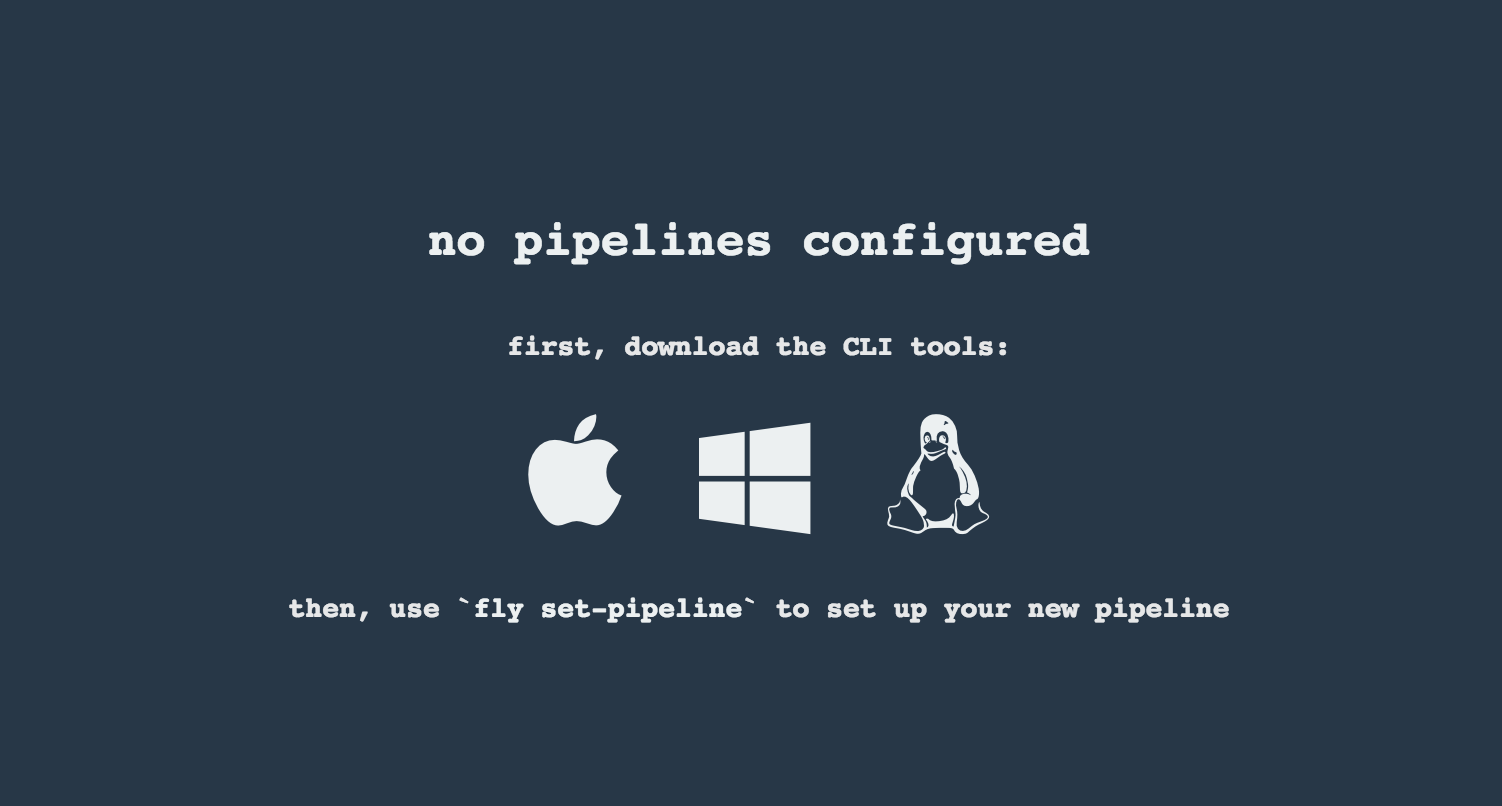
You can click one of the icons (depending on your OS) to download fly, which is the Concourse CLI. Once you’ve downloaded that (and maybe added to your PATH) you can run:
fly --version
If fly is properly installed then it should print out the version.
The repo comes with credentials-sample-cf.yml which is set up with sample data (most credentials) are set to be applicable for PCF Dev. Copy this file to a new file credentials.yml (the file is added to .gitignore so don’t worry that you’ll push it with your passwords) and edit it as you wish. For our demo just setup:
app-url- url pointing to your forkedgithub-webhookrepogithub-private-key- your private key to clone / tag GitHub reposrepo-with-binaries- the IP is set to the defaults for Docker Machine. You should update it to point to your setup
If you don’t have a Docker Machine just execute ./whats_my_ip.sh script to
get an external IP that you can pass to your repo-with-binaries instead of the default
Docker Machine IP.
Below you can see what environment variables are required by the scripts. To the right hand side you can see the default values for PCF Dev that we set in the credentials-sample-cf.yml.
| Property Name | Property Description | Default value |
|---|---|---|
BUILD_OPTIONS | Additional options you would like to pass to the Maven / Gradle build | |
PAAS_TEST_API_URL | The URL to the CF Api for TEST env | api.local.pcfdev.io |
PAAS_STAGE_API_URL | The URL to the CF Api for STAGE env | api.local.pcfdev.io |
PAAS_PROD_API_URL | The URL to the CF Api for PROD env | api.local.pcfdev.io |
PAAS_TEST_ORG | Name of the org for the test env | pcfdev-org |
PAAS_TEST_SPACE_PREFIX | Prefix of the name of the CF space for the test env to which the app name will be appended | sc-pipelines-test |
PAAS_STAGE_ORG | Name of the org for the stage env | pcfdev-org |
PAAS_STAGE_SPACE | Name of the space for the stage env | sc-pipelines-stage |
PAAS_PROD_ORG | Name of the org for the prod env | pcfdev-org |
PAAS_PROD_SPACE | Name of the space for the prod env | sc-pipelines-prod |
REPO_WITH_BINARIES_FOR_UPLOAD | URL to repo with the deployed jars | |
M2_SETTINGS_REPO_ID | The id of server from Maven settings.xml | artifactory-local |
PAAS_HOSTNAME_UUID | Additional suffix for the route. In a shared environment the default routes can be already taken | |
JAVA_BUILDPACK_URL | The URL to the Java buildpack to be used by CF |
Log in (e.g. for Concourse running at 192.168.99.100 - if you don’t provide any value then localhost is assumed). If you execute this script (it assumes that either fly is on your PATH or it’s in the same folder as the script is):
./login.sh 192.168.99.100
Next run the command to create the pipeline.
./set_pipeline.sh
Then you’ll create a github-webhook pipeline under the docker alias, using the provided credentials.yml file.
You can override these values in exactly that order (e.g. ./set-pipeline.sh some-project another-target some-other-credentials.yml)
![[Important]](images/important.png) | Important |
|---|---|
In this chapter we assume that you perform deployment of your application to Kubernetes PaaS |
The Spring Cloud Pipelines repository contains opinionated Concourse pipeline definition. Those jobs will form an empty pipeline and a sample, opinionated one that you can use in your company.
All in all there are the following projects taking part in the whole microservice setup for this demo.
- Github Analytics - the app that has a REST endpoint and uses messaging. Our business application.
- Github Webhook - project that emits messages that are used by Github Analytics. Our business application.
- Eureka - simple Eureka Server. This is an infrastructure application.
- Github Analytics Stub Runner Boot - Stub Runner Boot server to be used for tests with Github Analytics. Uses Eureka and Messaging. This is an infrastructure application.
This is a guide for Concourse pipeline.
If you want to just run the demo as far as possible using PCF Dev and Docker Compose
The simplest way to deploy Concourse to K8S is to use Helm.
Once you have Helm installed and your kubectl is pointing to the
cluster, just type this command to install the Concourse cluster in your K8S cluster.
$ helm install stable/concourse --name concourse
Once it’s done you’ll see the following output
1. Concourse can be accessed: * Within your cluster, at the following DNS name at port 8080: concourse-web.default.svc.cluster.local * From outside the cluster, run these commands in the same shell: export POD_NAME=$(kubectl get pods --namespace default -l "app=concourse-web" -o jsonpath="{.items[0].metadata.name}") echo "Visit http://127.0.0.1:8080 to use Concourse" kubectl port-forward --namespace default $POD_NAME 8080:8080 2. Login with the following credentials Username: concourse Password: concourse
Just follow these steps and log in to Concourse under http://127.0.0.1:8080.
We can use Helm also to deploy Artifactory to K8S
$ helm install --name artifactory --set artifactory.image.repository=docker.bintray.io/jfrog/artifactory-oss stable/artifactoryAfter executing this you’ll see the following output
NOTES: Congratulations. You have just deployed JFrog Artifactory Pro! 1. Get the Artifactory URL by running these commands: NOTE: It may take a few minutes for the LoadBalancer IP to be available. You can watch the status of the service by running 'kubectl get svc -w nginx' export SERVICE_IP=$(kubectl get svc --namespace default nginx -o jsonpath='{.status.loadBalancer.ingress[0].ip}') echo http://$SERVICE_IP/ 2. Open Artifactory in your browser Default credential for Artifactory: user: admin password: password
Next, we need to set up the repositories.
First, access the Artifactory URL and log in with
user, admin and password password.
Then, click on the Maven setup and click Create.
If you go to Concourse website you should see sth like this:

You can click one of the icons (depending on your OS) to download fly, which is the Concourse CLI. Once you’ve downloaded that (and maybe added to your PATH) you can run:
fly --version
If fly is properly installed then it should print out the version.
There is a sample credentials file called credentials-sample-k8s.yml
prepared for k8s. You can use it as a base for your credentials.yml.
To allow the Concourse worker’s spawned container to connect to Kubernetes cluster you will need to pass the CA contents and the auth token.
To get the contents of CA for GCE just execute
$ kubectl get secret $(kubectl get secret | grep default-token | awk '{print $1}') -o jsonpath='{.data.ca\.crt}' | base64 --decode
To get the token just type:
$ kubectl get secret $(kubectl get secret | grep default-token | awk '{print $1}') -o jsonpath='{.data.token}' | base64 --decode
Set that value under paas-test-client-token, paas-stage-client-token and paas-prod-client-token
After running Concourse you should get the following output in your terminal
$ export POD_NAME=$(kubectl get pods --namespace default -l "app=concourse-web" -o jsonpath="{.items[0].metadata.name}") $ echo "Visit http://127.0.0.1:8080 to use Concourse" $ kubectl port-forward --namespace default $POD_NAME 8080:8080 Visit http://127.0.0.1:8080 to use Concourse
Log in (e.g. for Concourse running at 127.0.0.1 - if you don’t provide any value then localhost is assumed). If you execute this script (it assumes that either fly is on your PATH or it’s in the same folder as the script is):
$ fly -t k8s login -c http://localhost:8080 -u concourse -p concourseNext run the command to create the pipeline.
$ ./set_pipeline.sh github-webhook k8s credentials-k8s.yml
Not really. This is an opinionated pipeline that’s why we took some
opinionated decisions. Check out the documentation to see
what those decisions are.
Sure! It’s open-source! The important thing is that the core part of the logic is written in Bash scripts. That way, in the majority of cases, you could change only the bash scripts without changing the whole pipeline. You can check out the scripts here.
Furthermore, if you only want to customize a particular function under common/src/main/bash, you can provide your own
function under common/src/main/bash/<some custom identifier> where <some custom identifier> is equal to the value of
the CUSTOM_SCRIPT_IDENTIFIER environment variable. It defaults to custom.
When deploying the app to stage or prod you can get an exception Insufficient resources. The way to
solve it is to kill some apps from test / stage env. To achieve that just call
cf target -o pcfdev-org -s pcfdev-test
cf stop github-webhook
cf stop github-eureka
cf stop stubrunnerYou can also execute ./tools/cf-helper.sh kill-all-apps that will remove
all demo-related apps deployed to PCF Dev.
You must have pushed some tags and have removed the Artifactory volume that contained them. To fix this, just remove the tags
git tag -l | xargs -n 1 git push --delete originYes! Assuming that pipeline name is github-webhook and job name is build-and-upload you can running
fly watch --job github-webhook/build-and-upload -t docker
Don’t worry… most likely you’ve just forgotten to click the play button to
unpause the pipeline. Click to the top left, expand the list of pipelines and click
the play button next to github-webhook.
Another problem that might occur is that you need to have the version branch.
Concourse will wait for the version branch to appear in your repo. So in order for
the pipeline to start ensure that when doing some git operations you haven’t
forgotten to create / copy the version branch too.
If you play around with Jenkins / Concourse you might end up with the routes occupied
Using route github-webhook-test.local.pcfdev.io Binding github-webhook-test.local.pcfdev.io to github-webhook... FAILED The route github-webhook-test.local.pcfdev.io is already in use.
Just delete the routes
yes | cf delete-route local.pcfdev.io -n github-webhook-test yes | cf delete-route local.pcfdev.io -n github-eureka-test yes | cf delete-route local.pcfdev.io -n stubrunner-test yes | cf delete-route local.pcfdev.io -n github-webhook-stage yes | cf delete-route local.pcfdev.io -n github-eureka-stage yes | cf delete-route local.pcfdev.io -n github-webhook-prod yes | cf delete-route local.pcfdev.io -n github-eureka-prod
You can also execute the ./tools/cf-helper.sh delete-routes
Most likely you’ve forgotten to update your local settings.xml with the Artifactory’s
setup. Check out this section of the docs and update your settings.xml.
When I click on it it looks like this:
resource script '/opt/resource/check []' failed: exit status 128 stderr: Identity added: /tmp/git-resource-private-key (/tmp/git-resource-private-key) Cloning into '/tmp/git-resource-repo-cache'... warning: Could not find remote branch version to clone. fatal: Remote branch version not found in upstream origin
That means that your repo doesn’t have the version branch. Please
set it up.
In this section we will present the common setup of Jenkins for any platform. We will also provide answers to most frequently asked questions.
.
├── declarative-pipeline
│ └── Jenkinsfile-sample.groovy
├── jobs
│ ├── jenkins_pipeline_empty.groovy
│ ├── jenkins_pipeline_jenkinsfile_empty.groovy
│ ├── jenkins_pipeline_sample.groovy
│ └── jenkins_pipeline_sample_view.groovy
├── seed
│ ├── init.groovy
│ ├── jenkins_pipeline.groovy
│ ├── k8s
│ └── settings.xml
└── src
├── main
└── testIn the declarative-pipeline you can find a definition of a Jenkinsfile-sample.groovy declarative
pipeline. It’s used together with the Blueocean UI.
In the jobs folder you have all the seed jobs that will generate pipelines.
jenkins_pipeline_empty.groovy- is a template of a pipeline with empty steps using the Jenkins Job DSL pluginjenkins_pipeline_jenkinsfile_empty.groovy- is a template of a pipeline with empty steps using the Pipeline pluginjenkins_pipeline_sample.groovy- is an opinionated implementation using the Jenkins Job DSL pluginjenkins_pipeline_sample_view.groovy- builds the views for the pipelines
In the seed folder you have the init.groovy file which is executed when Jenkins starts.
That way we can configure most of Jenkins options for you (adding credentials, JDK etc.).
jenkins_pipeline.groovy contains logic to build a seed job (that way you don’t have to even click that
job - we generate it for you). Under the k8s folder there are all the configuration
files required for deployment to a Kubernetes cluster.
In the src folder you have production and test classes needed for you to build your own pipeline.
Currently we have tests only cause the whole logic resides in the jenkins_pipeline_sample file.
All the steps below are not necessary to run the demo. They are needed only when you want to do some custom changes.
It’s enough to set the ARTIFACTORY_URL environmental variable before
executing tools/deploy-infra.sh. Example for deploying to Artifactory at IP 192.168.99.100
git clone https://github.com/spring-cloud/spring-cloud-pipelines cd spring-cloud-pipelines/ ARTIFACTORY_URL="http://192.168.99.100:8081/artifactory/libs-release-local" ./tools/deploy-infra.sh
![[Tip]](images/tip.png) | Tip |
|---|---|
If you want to use the default connection to the Docker version of Artifactory you can skip this step |
So that ./mvnw deploy works with Artifactory from Docker we’re
already copying the missing settings.xml file for you. It looks more or less like this:
<?xml version="1.0" encoding="UTF-8"?> <settings> <servers> <server> <id>${M2_SETTINGS_REPO_ID}</id> <username>${M2_SETTINGS_REPO_USERNAME}</username> <password>${M2_SETTINGS_REPO_PASSWORD}</password> </server> <server> <id>${DOCKER_SERVER_ID}</id> <username>${DOCKER_USERNAME}</username> <password>${DOCKER_PASSWORD}</password> <configuration> <email>${DOCKER_EMAIL}</email> </configuration> </server> </servers> </settings>
As you can see the file is parameterized. In Maven it’s enough to pass
to ./mvnw command the proper system property to override that value. For example to pass
a different docker email you’d have to call ./mvnw -DDOCKER_EMAIL=[email protected] and the value
gets updated.
If you want to use your own version of Artifactory / Nexus you have to update
the file (it’s in seed/settings.xml).
If you want to only play around with the demo that we’ve prepared you have to set ONE variable which is the REPOS variable.
That variable needs to consists of comma separated list of URLs to repositories containing business apps. So you should pass your forked repos URLs.
You can do it in the following ways:
- globally via Jenkins global env vars (then when you run the seed that variable will be taken into consideration and proper pipelines will get built)
- modify the seed job parameters (you’ll have to modify the seed job configuration and change the
REPOSproperty) - provide the repos parameter when running the seed job
For the sake of simplicity let’s go with the last option.
![[Important]](images/important.png) | Important |
|---|---|
If you’re choosing the global envs, you HAVE to remove the other approach
(e.g. if you set the global env for |
Click on the seed job and pick Build with parameters. Then as presented in the screen below (you’ll have far more properties to set) just modify the REPOS property by providing the comma separated list of URLs to your forks. Whatever you set will be parsed by the seed job and passed to the generated Jenkins jobs.
![[Tip]](images/tip.png) | Tip |
|---|---|
This is very useful when the repos you want to build differ. E.g. use
different JDK. Then some seeds can set the |
Example screen:

In the screenshot we could parametrize the REPOS and REPO_WITH_BINARIES params.
Since our pipeline is setting the git user / name explicitly for the build step
you’d have to go to Configure of the build step and modify the Git name / email.
If you want to set it globally you’ll have to remove the section from the build
step and follow these steps to set it globally.
You can set Git email / user globally like this:
The scripts will need to access the credential in order to tag the repo.
You have to set credentials with id: git.
Below you can find instructions on how to set a credential (e.g. for Cloud Foundry cf-test credential but
remember to provide the one with id git).
Figure 7.7. Fill out the user / password and provide the git credential ID (in this example cf-test)

./gradlew clean build
![[Warning]](images/warning.png) | Warning |
|---|---|
The ran test only checks if your scripts compile. |
Check out the tutorial. Provide the link to this repository in your Jenkins installation.
![[Warning]](images/warning.png) | Warning |
|---|---|
Remember that views can be overridden that’s why the suggestion is to contain in one script all the logic needed to build a view
for a single project (check out that |
If you would like to run the pre-configured Jenkins image somewhere other than your local machine, we
have an image you can pull and use on DockerHub.
The latest tag corresponds to the latest snapshot build. You can also find tags
corresponding to stable releases that you can use as well.
![[Important]](images/important.png) | Important |
|---|---|
In this chapter we assume that you perform deployment of your application to Cloud Foundry PaaS |
The Spring Cloud Pipelines repository contains job definitions and the opinionated setup pipeline using Jenkins Job DSL plugin. Those jobs will form an empty pipeline and a sample, opinionated one that you can use in your company.
All in all there are the following projects taking part in the whole microservice setup for this demo.
- Github Analytics - the app that has a REST endpoint and uses messaging. Our business application.
- Github Webhook - project that emits messages that are used by Github Analytics. Our business application.
- Eureka - simple Eureka Server. This is an infrastructure application.
- Github Analytics Stub Runner Boot - Stub Runner Boot server to be used for tests with Github Analytics. Uses Eureka and Messaging. This is an infrastructure application.
This is a guide for Jenkins Job DSL based pipeline.
If you want to just run the demo as far as possible using PCF Dev and Docker Compose
There are 4 apps that are composing the pipeline
You need to fork only these. That’s because only then will your user be able to tag and push the tag to repo.
Jenkins + Artifactory can be ran locally. To do that just execute the
start.sh script from this repo.
git clone https://github.com/spring-cloud/spring-cloud-pipelines
cd spring-cloud-pipelines/jenkins
./start.sh yourGitUsername yourGitPassword yourForkedGithubOrgThen Jenkins will be running on port 8080 and Artifactory 8081.
The provided parameters will be passed as env variables to Jenkins VM
and credentials will be set in your set. That way you don’t have to do
any manual work on the Jenkins side. In the above parameters, the third parameter
could be yourForkedGithubOrg or yourGithubUsername. Also the REPOS env variable will
contain your GitHub org in which you have the forked repos.
Instead of the Git username and password parameters you could pass -key <path_to_private_key>
if you prefer to use the key-based authentication with your Git repositories.
When Artifactory is running, just execute the tools/deploy-infra.sh script from this repo.
git clone https://github.com/spring-cloud/spring-cloud-pipelines
cd spring-cloud-pipelines/
./tools/deploy-infra.shAs a result both eureka and stub runner repos will be cloned, built
and uploaded to Artifactory.
![[Tip]](images/tip.png) | Tip |
|---|---|
You can skip this step if you have CF installed and don’t want to use PCF Dev The only thing you have to do is to set up spaces. |
![[Warning]](images/warning.png) | Warning |
|---|---|
It’s more than likely that you’ll run out of resources when you reach stage step. Don’t worry! Keep calm and clear some apps from PCF Dev and continue. |
You have to download and start PCF Dev. A link how to do it is available here.
The default credentials when using PCF Dev are:
username: user password: pass email: user org: pcfdev-org space: pcfdev-space api: api.local.pcfdev.io
You can start the PCF Dev like this:
cf dev start
You’ll have to create 3 separate spaces (email admin, pass admin)
cf login -a https://api.local.pcfdev.io --skip-ssl-validation -u admin -p admin -o pcfdev-org cf create-space pcfdev-test cf set-space-role user pcfdev-org pcfdev-test SpaceDeveloper cf create-space pcfdev-stage cf set-space-role user pcfdev-org pcfdev-stage SpaceDeveloper cf create-space pcfdev-prod cf set-space-role user pcfdev-org pcfdev-prod SpaceDeveloper
You can also execute the ./tools/cf-helper.sh setup-spaces to do this.
We already create the seed job for you but you’ll have to run it. When you do run it you have to provide some properties. By default we create a seed that has all the properties options, but you can delete most of it. If you set the properties as global env variables you have to remove them from the seed.
Anyways, to run the demo just provide in the REPOS var the comma separated
list of URLs of the 2 aforementioned forks of github-webhook and `github-analytics'.
Figure 8.1. Click the 'jenkins-pipeline-seed-cf' job for Cloud Foundry and jenkins-pipeline-seed-k8s for Kubernetes

Figure 8.3. The REPOS parameter should already contain your forked repos (you’ll have more properties than the ones in the screenshot)

We already create the seed job for you but you’ll have to run it. When you do run it you have to provide some properties. By default we create a seed that has all the properties options, but you can delete most of it. If you set the properties as global env variables you have to remove them from the seed.
Anyways, to run the demo just provide in the REPOS var the comma separated
list of URLs of the 2 aforementioned forks of github-webhook and github-analytics.
![[Important]](images/important.png) | Important |
|---|---|
If your build fails on the deploy previous version to stage due to missing jar, that means that you’ve forgotten to clear the tags in your repo. Typically that’s due to the fact that you’ve removed the Artifactory volume with deployed JAR whereas a tag in the repo is still pointing there. Check out this section on how to remove the tag. |
Figure 8.7. Click the manual step to go to stage (remember about killing the apps on test env). To do this click the ARROW next to the job name
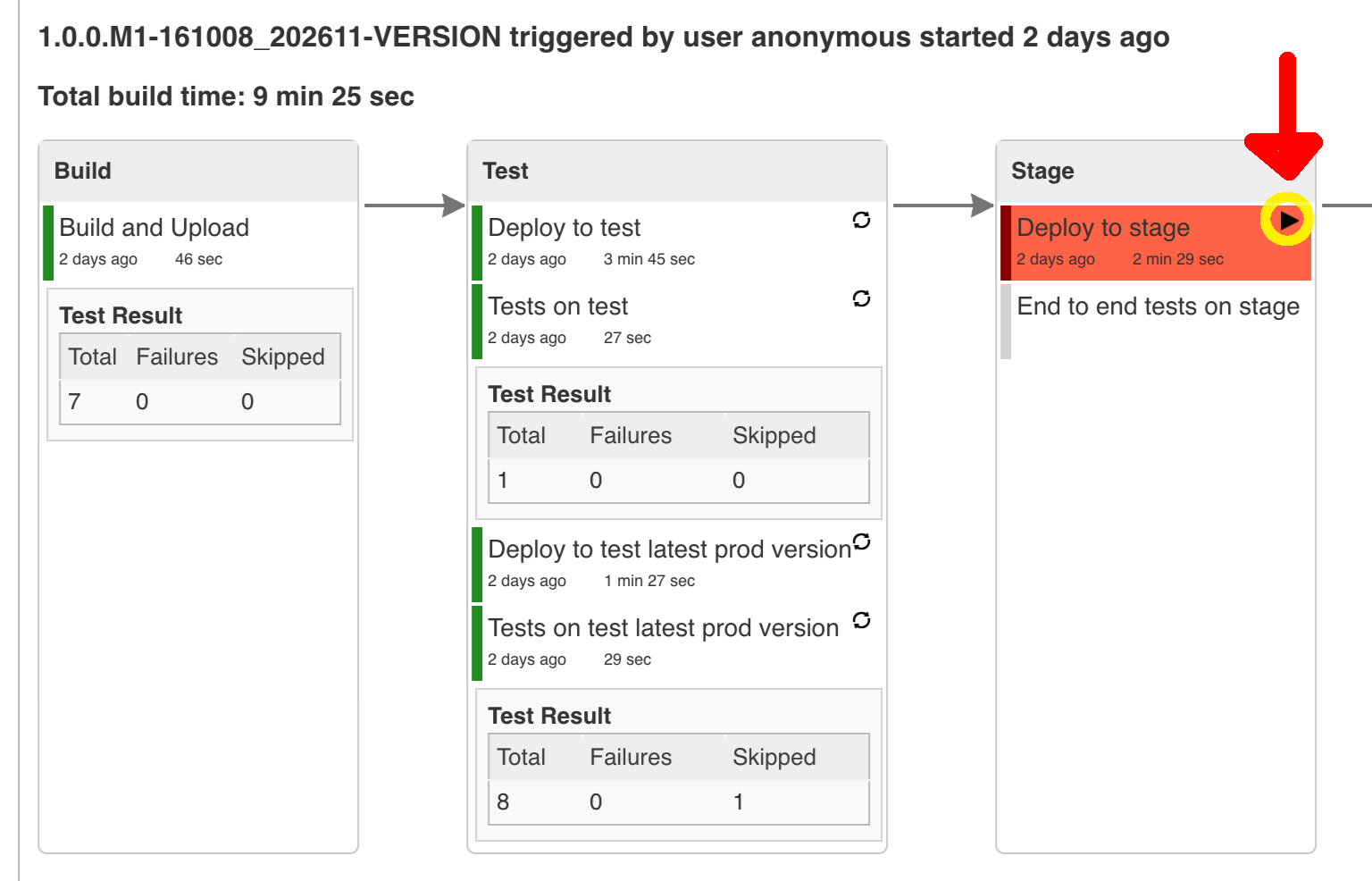
![[Important]](images/important.png) | Important |
|---|---|
Most likely you will run out of memory so when reaching the stage environment it’s good to kill all apps on test. Check out the FAQ section for more details! |
You can also use the declarative pipeline approach with the Blue Ocean UI. Here is a step by step guide to run a pipeline via this approach.
The Blue Ocean UI is available under the blue/ URL. E.g. for Docker Machine based setup http://192.168.99.100:8080/blue.
![[Important]](images/important.png) | Important |
|---|---|
There is no possibility of restarting pipeline from specific stage, after failure. Please check out this issue for more information |
![[Warning]](images/warning.png) | Warning |
|---|---|
Currently there is no way to introduce manual steps in a performant way. Jenkins is blocking an executor when manual step is required. That means that you’ll run out of executors pretty fast. You can check out this issue for and this StackOverflow question for more information. |
All the steps below are not necessary to run the demo. They are needed only when you want to do some custom changes.
The env vars that are used in all of the jobs are as follows:
| Property Name | Property Description | Default value |
|---|---|---|
BINARY_EXTENSION | Extension of the binary uploaded to Artifactory / Nexus. Example: change this to | jar |
PAAS_TEST_API_URL | The URL to the CF Api for TEST env | api.local.pcfdev.io |
PAAS_STAGE_API_URL | The URL to the CF Api for STAGE env | api.local.pcfdev.io |
PAAS_PROD_API_URL | The URL to the CF Api for PROD env | api.local.pcfdev.io |
PAAS_TEST_ORG | Name of the org for the test env | pcfdev-org |
PAAS_TEST_SPACE_PREFIX | Prefix of the name of the CF space for the test env to which the app name will be appended | sc-pipelines-test |
PAAS_STAGE_ORG | Name of the org for the stage env | pcfdev-org |
PAAS_STAGE_SPACE | Name of the space for the stage env | sc-pipelines-stage |
PAAS_PROD_ORG | Name of the org for the prod env | pcfdev-org |
PAAS_PROD_SPACE | Name of the space for the prod env | sc-pipelines-prod |
REPO_WITH_BINARIES_FOR_UPLOAD | URL to repo with the deployed jars | |
M2_SETTINGS_REPO_ID | The id of server from Maven settings.xml | artifactory-local |
JDK_VERSION | The name of the JDK installation | jdk8 |
PIPELINE_VERSION | What should be the version of the pipeline (ultimately also version of the jar) | 1.0.0.M1-${GROOVY,script ="new Date().format('yyMMdd_HHmmss')"}-VERSION |
GIT_EMAIL | The email used by Git to tag repo | |
GIT_NAME | The name used by Git to tag repo | Pivo Tal |
PAAS_HOSTNAME_UUID | Additional suffix for the route. In a shared environment the default routes can be already taken | |
AUTO_DEPLOY_TO_STAGE | Should deployment to stage be automatic | false |
AUTO_DEPLOY_TO_PROD | Should deployment to prod be automatic | false |
API_COMPATIBILITY_STEP_REQUIRED | Should api compatibility step be required | true |
DB_ROLLBACK_STEP_REQUIRED | Should DB rollback step be present | true |
DEPLOY_TO_STAGE_STEP_REQUIRED | Should deploy to stage step be present | true |
JAVA_BUILDPACK_URL | The URL to the Java buildpack to be used by CF | |
BUILD_OPTIONS | Additional options you would like to pass to the Maven / Gradle build |
In your scripts we reference the credentials via IDs. These are the defaults for credentials
| Property Name | Property Description | Default value |
|---|---|---|
PAAS_PROD_CREDENTIAL_ID | Credential ID for CF Prod env access | cf-prod |
GIT_CREDENTIAL_ID | Credential ID used to tag a git repo | git |
GIT_SSH_CREDENTIAL_ID | SSH credential ID used to tag a git repo | gitSsh |
GIT_USE_SSH_KEY | if | false |
REPO_WITH_BINARIES_CREDENTIAL_ID | Credential ID used for the repo with jars | repo-with-binaries |
PAAS_TEST_CREDENTIAL_ID | Credential ID for CF Test env access | cf-test |
PAAS_STAGE_CREDENTIAL_ID | Credential ID for CF Stage env access | cf-stage |
If you already have in your system a credential to for example tag a repo
you can use it by passing the value of the property GIT_CREDENTIAL_ID
![[Tip]](images/tip.png) | Tip |
|---|---|
Check out the |
![[Important]](images/important.png) | Important |
|---|---|
In this chapter we assume that you perform deployment of your application to Kubernetes PaaS |
The Spring Cloud Pipelines repository contains job definitions and the opinionated setup pipeline using Jenkins Job DSL plugin. Those jobs will form an empty pipeline and a sample, opinionated one that you can use in your company.
All in all there are the following projects taking part in the whole microservice setup for this demo.
- Github Analytics - the app that has a REST endpoint and uses messaging. Our business application.
- Github Webhook - project that emits messages that are used by Github Analytics. Our business application.
- Eureka - simple Eureka Server. This is an infrastructure application.
- Github Analytics Stub Runner Boot - Stub Runner Boot server to be used for tests with Github Analytics. Uses Eureka and Messaging. This is an infrastructure application.
This is a guide for Jenkins Job DSL based pipeline.
If you want to just run the demo as far as possible using PCF Dev and Docker Compose
There are 4 apps that are composing the pipeline
You need to fork only these. That’s because only then will your user be able to tag and push the tag to repo.
Jenkins + Artifactory can be ran locally. To do that just execute the
start.sh script from this repo.
git clone https://github.com/spring-cloud/spring-cloud-pipelines
cd spring-cloud-pipelines/jenkins
./start.sh yourGitUsername yourGitPassword yourForkedGithubOrg yourDockerRegistryOrganization yourDockerRegistryUsername yourDockerRegistryPassword yourDockerRegistryEmailThen Jenkins will be running on port 8080 and Artifactory 8081.
The provided parameters will be passed as env variables to Jenkins VM
and credentials will be set in your set. That way you don’t have to do
any manual work on the Jenkins side. In the above parameters, the third parameter
could be yourForkedGithubOrg or yourGithubUsername. Also the REPOS env variable will
contain your GitHub org in which you have the forked repos.
Instead of the Git username and password parameters you could pass -key <path_to_private_key>
if you prefer to use the key-based authentication with your Git repositories.
You need to pass the credentials for the Docker organization (by default we will search for the Docker images at Docker Hub) so that the pipeline will be able to push images to your org.
When Artifactory is running, just execute the tools/deploy-infra.sh script from this repo.
git clone https://github.com/spring-cloud/spring-cloud-pipelines
cd spring-cloud-pipelines/
./tools/deploy-infra-k8s.shAs a result both eureka and stub runner repos will be cloned, built,
uploaded to Artifactory and their docker images will be built.
![[Important]](images/important.png) | Important |
|---|---|
Your local Docker process will be reused by the Jenkins instance running in Docker. That’s why you don’t have to push these images to Docker Hub. On the other hand if you run this sample in a remote Kubernetes cluster the driver will not be shared by the Jenkins workers so you can consider pushing these Docker images to Docker Hub too. |
We already create the seed job for you but you’ll have to run it. When you do run it you have to provide some properties. By default we create a seed that has all the properties options, but you can delete most of it. If you set the properties as global env variables you have to remove them from the seed.
Anyways, to run the demo just provide in the REPOS var the comma separated
list of URLs of the 2 aforementioned forks of github-webhook and `github-analytics'.
Figure 9.1. Click the 'jenkins-pipeline-seed-cf' job for Cloud Foundry and jenkins-pipeline-seed-k8s for Kubernetes

Figure 9.3. The REPOS parameter should already contain your forked repos (you’ll have more properties than the ones in the screenshot)

We already create the seed job for you but you’ll have to run it. When you do run it you have to provide some properties. By default we create a seed that has all the properties options, but you can delete most of it. If you set the properties as global env variables you have to remove them from the seed.
Anyways, to run the demo just provide in the REPOS var the comma separated
list of URLs of the 2 aforementioned forks of github-webhook and github-analytics.
![[Important]](images/important.png) | Important |
|---|---|
If your build fails on the deploy previous version to stage due to missing jar, that means that you’ve forgotten to clear the tags in your repo. Typically that’s due to the fact that you’ve removed the Artifactory volume with deployed JAR whereas a tag in the repo is still pointing there. Check out this section on how to remove the tag. |
Figure 9.7. Click the manual step to go to stage (remember about killing the apps on test env). To do this click the ARROW next to the job name

![[Important]](images/important.png) | Important |
|---|---|
Most likely you will run out of memory so when reaching the stage environment it’s good to kill all apps on test. Check out the FAQ section for more details! |
You can also use the declarative pipeline approach with the Blue Ocean UI. Here is a step by step guide to run a pipeline via this approach.
The Blue Ocean UI is available under the blue/ URL. E.g. for Docker Machine based setup http://192.168.99.100:8080/blue.
![[Important]](images/important.png) | Important |
|---|---|
There is no possibility of restarting pipeline from specific stage, after failure. Please check out this issue for more information |
![[Warning]](images/warning.png) | Warning |
|---|---|
Currently there is no way to introduce manual steps in a performant way. Jenkins is blocking an executor when manual step is required. That means that you’ll run out of executors pretty fast. You can check out this issue for and this StackOverflow question for more information. |
![[Important]](images/important.png) | Important |
|---|---|
All the steps below are not necessary to run the demo. They are needed only when you want to do some custom changes. |
The env vars that are used in all of the jobs are as follows:
| Property Name | Property Description | Default value |
|---|---|---|
BUILD_OPTIONS | Additional options you would like to pass to the Maven / Gradle build | |
DOCKER_REGISTRY_ORGANIZATION | Name of the docker organization to which Docker images should be deployed | scpipelines |
DOCKER_REGISTRY_CREDENTIAL_ID | Credential ID used to push Docker images | docker-registry |
DOCKER_SERVER_ID | Server ID in | docker-repo |
DOCKER_EMAIL | Email used to connect to Docker registry` and Maven builds | |
DOCKER_REGISTRY_ORGANIZATION | URL to Kubernetes cluster for test env | scpipelines |
DOCKER_REGISTRY_URL | URL to the docker registry | |
PAAS_TEST_API_URL | URL of the API of the Kubernetes cluster for test environment | 192.168.99.100:8443 |
PAAS_STAGE_API_URL | URL of the API of the Kubernetes cluster for stage environment | 192.168.99.100:8443 |
PAAS_PROD_API_URL | URL of the API of the Kubernetes cluster for prod environment | 192.168.99.100:8443 |
PAAS_TEST_CA_PATH | Path to the certificate authority for test environment | /usr/share/jenkins/cert/ca.crt |
PAAS_STAGE_CA_PATH | Path to the certificate authority for stage environment | /usr/share/jenkins/cert/ca.crt |
PAAS_PROD_CA_PATH | Path to the certificate authority for prod environment | /usr/share/jenkins/cert/ca.crt |
PAAS_TEST_CLIENT_CERT_PATH | Path to the client certificate for test environment | /usr/share/jenkins/cert/apiserver.crt |
PAAS_STAGE_CLIENT_CERT_PATH | Path to the client certificate for stage environment | /usr/share/jenkins/cert/apiserver.crt |
PAAS_PROD_CLIENT_CERT_PATH | Path to the client certificate for prod environment | /usr/share/jenkins/cert/apiserver.crt |
PAAS_TEST_CLIENT_KEY_PATH | Path to the client key for test environment | /usr/share/jenkins/cert/apiserver.key |
PAAS_STAGE_CLIENT_KEY_PATH | Path to the client key for stage environment | /usr/share/jenkins/cert/apiserver.key |
PAAS_PROD_CLIENT_KEY_PATH | Path to the client key for test environment | /usr/share/jenkins/cert/apiserver.key |
PAAS_TEST_CLIENT_TOKEN_PATH | Path to the file containing the token for test env | |
PAAS_STAGE_CLIENT_TOKEN_PATH | Path to the file containing the token for stage env | |
PAAS_PROD_CLIENT_TOKEN_PATH | Path to the file containing the token for prod env | |
PAAS_TEST_CLIENT_TOKEN_ID | ID of the credential containing access token for test environment | |
PAAS_STAGE_CLIENT_TOKEN_ID | ID of the credential containing access token for stage environment | |
PAAS_PROD_CLIENT_TOKEN_ID | ID of the credential containing access token for prod environment | |
PAAS_TEST_CLUSTER_NAME | Name of the cluster for test environment | minikube |
PAAS_STAGE_CLUSTER_NAME | Name of the cluster for stage environment | minikube |
PAAS_PROD_CLUSTER_NAME | Name of the cluster for prod environment | minikube |
PAAS_TEST_CLUSTER_USERNAME | Name of the user for test environment | minikube |
PAAS_STAGE_CLUSTER_USERNAME | Name of the user for stage environment | minikube |
PAAS_PROD_CLUSTER_USERNAME | Name of the user for prod environment | minikube |
PAAS_TEST_SYSTEM_NAME | Name of the system for test environment | minikube |
PAAS_STAGE_SYSTEM_NAME | Name of the system for stage environment | minikube |
PAAS_PROD_SYSTEM_NAME | Name of the system for prod environment | minikube |
PAAS_TEST_NAMESPACE | Namespace for test environment | sc-pipelines-test |
PAAS_STAGE_NAMESPACE | Namespace for stage environment | sc-pipelines-stage |
PAAS_PROD_NAMESPACE | Namespace for prod environment | sc-pipelines-prod |
KUBERNETES_MINIKUBE | Will you connect to Minikube? | true |
REPO_WITH_BINARIES_FOR_UPLOAD | URL to repo with the deployed jars | |
REPO_WITH_BINARIES_CREDENTIAL_ID | Credential ID used for the repo with jars | repo-with-binaries |
M2_SETTINGS_REPO_ID | The id of server from Maven settings.xml | artifactory-local |
JDK_VERSION | The name of the JDK installation | jdk8 |
PIPELINE_VERSION | What should be the version of the pipeline (ultimately also version of the jar) | 1.0.0.M1-${GROOVY,script ="new Date().format('yyMMdd_HHmmss')"}-VERSION |
GIT_EMAIL | The email used by Git to tag repo | |
GIT_NAME | The name used by Git to tag repo | Pivo Tal |
AUTO_DEPLOY_TO_STAGE | Should deployment to stage be automatic | false |
AUTO_DEPLOY_TO_PROD | Should deployment to prod be automatic | false |
API_COMPATIBILITY_STEP_REQUIRED | Should api compatibility step be required | true |
DB_ROLLBACK_STEP_REQUIRED | Should DB rollback step be present | true |
DEPLOY_TO_STAGE_STEP_REQUIRED | Should deploy to stage step be present | true |
![[Important]](images/important.png) | Important |
|---|---|
Skip this step if you’re not using GCE |
In order to use GCE we need to have gcloud running. If you already have the
CLI installed, skip this step. If not just execute to have the CLI
downloaded and an installer started
$ ./tools/k8s-helper.sh download-gcloud
Next, configure gcloud. Execute gcloud init and log in
to your cluster. You will get redirected to a login page, pick the
proper Google account and log in.
Pick an existing project or create a new one.
Go to your platform page (click on Container Engine) in GCP and connect to your cluster
$ CLUSTER_NAME=...
$ ZONE=us-east1-b
$ PROJECT_NAME=...
$ gcloud container clusters get-credentials ${CLUSTER_NAME} --zone ${ZONE} --project ${PROJECT_NAME}
$ kubectl proxyThe Kubernetes dashboard will be running at http://localhost:8001/ui/.
We’ll need a Persistent Disk for our Jenkins installation. Let’s create it
$ ZONE=us-east1-b
$ gcloud compute disks create --size=200GB --zone=${ZONE} sc-pipelines-jenkins-diskSince the disk got created now we need to format it. You can check out the instructions on how to do it here - https://cloud.google.com/compute/docs/disks/add-persistent-disk#formatting
![[Important]](images/important.png) | Important |
|---|---|
Skip this step if you’re not using Kubo or GCE |
In this section a description of steps required to deploy Jenkins and Artifactory to a Kubernetes cluster deployed via Kubo.
![[Tip]](images/tip.png) | Tip |
|---|---|
To see the dashboard just do |
- Log in to the cluster
Deploy Jenkins and Artifactory to the cluster
./tools/k8s-helper.sh setup-tools-infra-vspherefor a cluster deployed on VSphere./tools/k8s-helper.sh setup-tools-infra-gcefor a cluster deployed to GCE
- Forward the ports so that you can access the Jenkins UI from your local machine
$ NAMESPACE=default $ JENKINS_POD=jenkins-1430785859-nfhx4 $ LOCAL_PORT=32044 $ CONTAINER_PORT=8080 $ kubectl port-forward --namespace=${NAMESPACE} ${JENKINS_POD} ${LOCAL_PORT}:${CONTAINER_PORT}
- Go to
Credentials, clickSystemandGlobal credentials
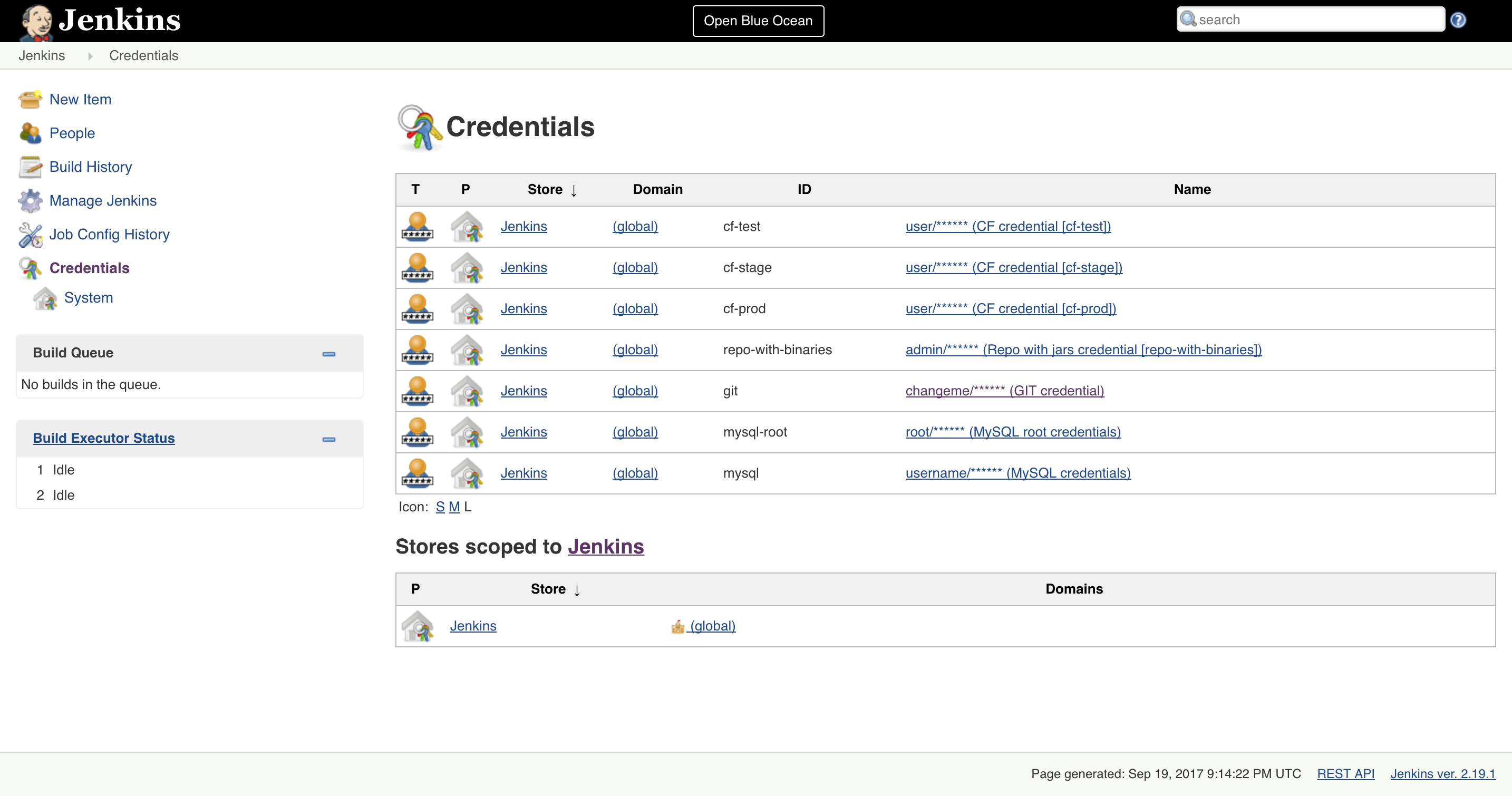
- Update
git,repo-with-binariesanddocker-registrycredentials Run the
jenkins-pipeline-k8s-seedseed job and fill it out with the following dataPut
kubernetes.default:443here (orKUBERNETES_API:KUBERNETES_PORT)PAAS_TEST_API_URLPAAS_STAGE_API_URLPAAS_PROD_API_URL
Put
/var/run/secrets/kubernetes.io/serviceaccount/ca.crtdata herePAAS_TEST_CA_PATHPAAS_STAGE_CA_PATHPAAS_PROD_CA_PATH
- Uncheck the
Kubernetes Minikubevalue Clear the following vars
PAAS_TEST_CLIENT_CERT_PATHPAAS_STAGE_CLIENT_CERT_PATHPAAS_PROD_CLIENT_CERT_PATHPAAS_TEST_CLIENT_KEY_PATHPAAS_STAGE_CLIENT_KEY_PATHPAAS_PROD_CLIENT_KEY_PATH
Set
/var/run/secrets/kubernetes.io/serviceaccount/tokenvalue to these varsPAAS_TEST_CLIENT_TOKEN_PATHPAAS_STAGE_CLIENT_TOKEN_PATHPAAS_STAGE_CLIENT_TOKEN_PATH
Set the cluster name to these vars (you can get it by calling
kubectl config current-context)PAAS_TEST_CLUSTER_NAMEPAAS_STAGE_CLUSTER_NAMEPAAS_PROD_CLUSTER_NAME
Set the system name to these vars (you can get it by calling
kubectl config current-context)PAAS_TEST_SYSTEM_NAMEPAAS_STAGE_SYSTEM_NAMEPAAS_PROD_SYSTEM_NAME
- Update the
DOCKER_EMAILproperty with your email - Update the
DOCKER_REGISTRY_ORGANIZATIONwith your Docker organization name - If you don’t want to upload the images to DockerHub update
DOCKER_REGISTRY_URL
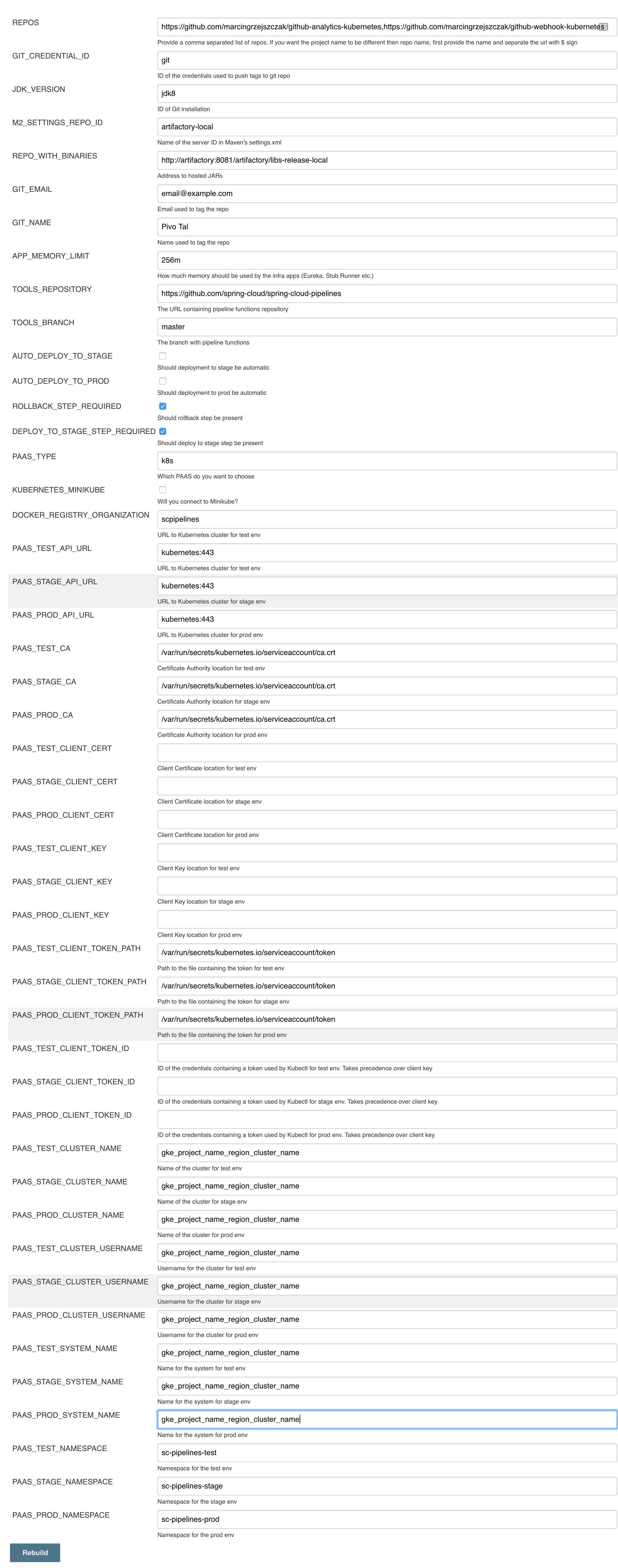
- Run the pipeline
Below you can find the answers to most frequently asked questions.
You can check the Jenkins logs and you’ll see
WARNING: Skipped parameter `PIPELINE_VERSION` as it is undefined on `jenkins-pipeline-sample-build`. Set `-Dhudson.model.ParametersAction.keepUndefinedParameters`=true to allow undefined parameters to be injected as environment variables or `-Dhudson.model.ParametersAction.safeParameters=[comma-separated list]` to whitelist specific parameter names, even though it represents a security breach
To fix it you have to do exactly what the warning suggests… Also ensure that the Groovy token macro processing
checkbox is set.
You can see that the Jenkins version is properly set but in the build version is still snapshot and
the echo "${PIPELINE_VERSION}" doesn’t print anything.
You can check the Jenkins logs and you’ll see
WARNING: Skipped parameter `PIPELINE_VERSION` as it is undefined on `jenkins-pipeline-sample-build`. Set `-Dhudson.model.ParametersAction.keepUndefinedParameters`=true to allow undefined parameters to be injected as environment variables or `-Dhudson.model.ParametersAction.safeParameters=[comma-separated list]` to whitelist specific parameter names, even though it represents a security breach
To fix it you have to do exactly what the warning suggests…
Docker compose, docker compose, docker compose… The problem is that for some reason, only in Docker, the execution of Java hangs. But it hangs randomly and only the first time you try to execute the pipeline.
The solution to this is to run the pipeline again. If once it suddenly, magically passes then it will pass for any subsequent build.
Another thing that you can try is to run it with plain Docker. Maybe that will help.
Sure! you can pass REPOS variable with comma separated list of
project_name$project_url format. If you don’t provide the PROJECT_NAME the
repo name will be extracted and used as the name of the project.
E.g. for REPOS equal to:
will result in the creation of pipelines with root names github-analytics and github-webhook.
E.g. for REPOS equal to:
foo$https://github.com/spring-cloud-samples/github-analytics,bar$https://github.com/spring-cloud-samples/atom-feed
will result in the creation of pipelines with root names foo for github-analytics
and bar for github-webhook.
Not really. This is an opinionated pipeline that’s why we took some
opinionated decisions like:
- usage of Spring Cloud, Spring Cloud Contract Stub Runner and Spring Cloud Eureka
- application deployment to Cloud Foundry
For Maven:
- usage of Maven Wrapper
- artifacts deployment by
./mvnw clean deploy stubrunner.idsproperty to retrieve list of collaborators for which stubs should be downloaded- running smoke tests on a deployed app via the
smokeMaven profile - running end to end tests on a deployed app via the
e2eMaven profile
For Gradle (in the
github-analyticsapplication check thegradle/pipeline.gradlefile):- usage of Gradlew Wrapper
deploytask for artifacts deployment- running smoke tests on a deployed app via the
smoketask - running end to end tests on a deployed app via the
e2etask groupIdtask to retrieve group idartifactIdtask to retrieve artifact idcurrentVersiontask to retrieve the current versionstubIdstask to retrieve list of collaborators for which stubs should be downloaded
This is the initial approach that can be easily changed in the future.
Sure! It’s open-source! The important thing is that the core part of the logic is written in Bash scripts. That way, in the majority of cases, you could change only the bash scripts without changing the whole pipeline.
You must have pushed some tags and have removed the Artifactory volume that contained them. To fix this, just remove the tags
git tag -l | xargs -n 1 git push --delete origin- by default we assume that you have jdk with id
jdk8configured - if you want a different one just override
JDK_VERSIONenv var and point to the proper one
![[Tip]](images/tip.png) | Tip |
|---|---|
The docker image comes in with Java installed at |
To change the default one just follow these steps:
And that’s it!
With scripted that but if you needed to this manually then this is how to do it:
No problem, just set the property / env var to true
AUTO_DEPLOY_TO_STAGEto automatically deploy to stageAUTO_DEPLOY_TO_PRODto automatically deploy to prod
No problem, just set the API_COMPATIBILITY_STEP_REQUIRED env variable
to false and rerun the seed (you can pick it from the seed
job’s properties too).
When you get sth like this:
19:01:44 stderr: remote: Invalid username or password. 19:01:44 fatal: Authentication failed for 'https://github.com/marcingrzejszczak/github-webhook/' 19:01:44 19:01:44 at org.jenkinsci.plugins.gitclient.CliGitAPIImpl.launchCommandIn(CliGitAPIImpl.java:1740) 19:01:44 at org.jenkinsci.plugins.gitclient.CliGitAPIImpl.launchCommandWithCredentials(CliGitAPIImpl.java:1476) 19:01:44 at org.jenkinsci.plugins.gitclient.CliGitAPIImpl.access$300(CliGitAPIImpl.java:63) 19:01:44 at org.jenkinsci.plugins.gitclient.CliGitAPIImpl$8.execute(CliGitAPIImpl.java:1816) 19:01:44 at hudson.plugins.git.GitPublisher.perform(GitPublisher.java:295) 19:01:44 at hudson.tasks.BuildStepMonitor$3.perform(BuildStepMonitor.java:45) 19:01:44 at hudson.model.AbstractBuild$AbstractBuildExecution.perform(AbstractBuild.java:779) 19:01:44 at hudson.model.AbstractBuild$AbstractBuildExecution.performAllBuildSteps(AbstractBuild.java:720) 19:01:44 at hudson.model.Build$BuildExecution.post2(Build.java:185) 19:01:44 at hudson.model.AbstractBuild$AbstractBuildExecution.post(AbstractBuild.java:665) 19:01:44 at hudson.model.Run.execute(Run.java:1745) 19:01:44 at hudson.model.FreeStyleBuild.run(FreeStyleBuild.java:43) 19:01:44 at hudson.model.ResourceController.execute(ResourceController.java:98) 19:01:44 at hudson.model.Executor.run(Executor.java:404)
most likely you’ve passed a wrong password. Check the credentials section on how to update your credentials.
Most likely you’ve forgotten to update your local settings.xml with the Artifactory’s
setup. Check out this section of the docs and update your settings.xml.
In some cases it may be required that when performing a release that the artifacts be signed
before pushing them to the repository.
To do this you will need to import your GPG keys into the Docker image running Jenkins.
This can be done by placing a file called public.key containing your public key
and a file called private.key containing your private key in the seed directory.
These keys will be imported by the init.groovy script that is run when Jenkins starts.
The seed job checks if an env variable GIT_USE_SSH_KEY is set to true. If that’s the case
then env variable GIT_SSH_CREDENTIAL_ID will be chosen as the one that contains the
id of the credential that contains SSH private key. By default GIT_CREDENTIAL_ID will be picked
as the one that contains username and password to connect to git.
You can set these values in the seed job by filling out the form / toggling a checkbox.
There can be a number of reason but remember that for stage we assume that a sequence of manual steps need to be performed. We don’t redeploy any existing services cause most likely you deliberately have set it up in that way or the other. If in the logs of your application you can see that you can’t connect to a service, first ensure that the service is forwarding traffic to a pod. Next if that’s not the case please delete the service and re-run the step in the pipeline. That way Spring Cloud Pipelines will redeploy the service and the underlying pods.
[jenkins-cf-resources]] When deploying the app to stage or prod you can get an exception Insufficient resources. The way to
solve it is to kill some apps from test / stage env. To achieve that just call
cf target -o pcfdev-org -s pcfdev-test
cf stop github-webhook
cf stop github-eureka
cf stop stubrunnerYou can also execute ./tools/cf-helper.sh kill-all-apps that will remove all demo-related apps
deployed to PCF Dev.
If you receive a similar exception:
20:26:18 API endpoint: https://api.local.pcfdev.io (API version: 2.58.0) 20:26:18 User: user 20:26:18 Org: pcfdev-org 20:26:18 Space: No space targeted, use 'cf target -s SPACE' 20:26:18 FAILED 20:26:18 Error finding space pcfdev-test 20:26:18 Space pcfdev-test not found
It means that you’ve forgotten to create the spaces in your PCF Dev installation.
If you play around with Jenkins / Concourse you might end up with the routes occupied
Using route github-webhook-test.local.pcfdev.io Binding github-webhook-test.local.pcfdev.io to github-webhook... FAILED The route github-webhook-test.local.pcfdev.io is already in use.
Just delete the routes
yes | cf delete-route local.pcfdev.io -n github-webhook-test yes | cf delete-route local.pcfdev.io -n github-eureka-test yes | cf delete-route local.pcfdev.io -n stubrunner-test yes | cf delete-route local.pcfdev.io -n github-webhook-stage yes | cf delete-route local.pcfdev.io -n github-eureka-stage yes | cf delete-route local.pcfdev.io -n github-webhook-prod yes | cf delete-route local.pcfdev.io -n github-eureka-prod
You can also execute the ./tools/cf-helper.sh delete-routes
Assuming that you’re already logged into the cluster it’s enough to run the
helper script with the REUSE_CF_LOGIN=true env variable. Example:
REUSE_CF_LOGIN=true ./tools/cf-helper.sh setup-prod-infra
This script will create the mysql db, rabbit mq service, download and deploy Eureka to the space and organization you’re logged into.
First you’ll need to install the kubectl CLI.
You can use the tools/k8s-helper.sh script to install kubectl. Just call
$ ./tools/minikube-helper download-kubectl
and then the kubectl will get downloaded
Example for OSX
$ curl -LO https://storage.googleapis.com/kubernetes-release/release/$(curl -s https://storage.googleapis.com/kubernetes-release/release/stable.txt)/bin/darwin/amd64/kubectl $ chmod +x ./kubectl $ sudo mv ./kubectl /usr/local/bin/kubectl
Example for Linux
$ curl -LO https://storage.googleapis.com/kubernetes-release/release/$(curl -s https://storage.googleapis.com/kubernetes-release/release/stable.txt)/bin/linux/amd64/kubectl $ chmod +x ./kubectl $ sudo mv ./kubectl /usr/local/bin/kubectl
Check out this page for more information.
We need a cluster of Kubernetes. The best choice will be Minikube.
![[Tip]](images/tip.png) | Tip |
|---|---|
You can skip this step if you have Kubernetes cluster installed and don’t want to use Minikube The only thing you have to do is to set up spaces. |
![[Warning]](images/warning.png) | Warning |
|---|---|
It’s more than likely that you’ll run out of resources when you reach stage step. Don’t worry! Keep calm and clear some apps from Minikube and continue. |
You can use the tools/k8s-helper.sh script to install Minikube. Just call
$ ./tools/minikube-helper download-minikube
and then the Minikube cluster will get downloaded
Example for OSX
$ curl -Lo minikube https://storage.googleapis.com/minikube/releases/v0.20.0/minikube-darwin-amd64 && chmod +x minikube && sudo mv minikube /usr/local/bin/Feel free to leave off the sudo mv minikube /usr/local/bin if you would like to add minikube to your path manually.
Example for Linux
$ curl -Lo minikube https://storage.googleapis.com/minikube/releases/v0.20.0/minikube-linux-amd64 && chmod +x minikube && sudo mv minikube /usr/local/bin/Feel free to leave off the sudo mv minikube /usr/local/bin if you would like to add minikube to your path manually.
Check out this page for more info on the installation.
Just type in minikube start to start Kubernetes on your local box.
To add the dashboard just execute minikube dashboard
By default if you install Minikube all the certificates get installed in your
~/.minikube folder. Your kubectl configuration under ~/.kube/config will also
get updated to use Minikube.
![[Important]](images/important.png) | Important |
|---|---|
If you just want to run the default, demo setup you can skip this section |
To target a given Kubernetes instance one needs to pass around Certificate Authority key and also user keys.
You can read more about the instructions on how to generate those keys here.
Generally speaking if you have a Kubernetes installation (e.g. minikube) this step
has already been done for you. Time to reuse those keys on the workers.
Extracted from the official docs.
Configure kubectl to connect to the target cluster using the following commands, replacing several values as indicated:
- Replace
${MASTER_HOST}with the master node address or name used in previous steps - Replace
${CA_CERT}with the absolute path to theca.pemcreated in previous steps - Replace
${ADMIN_KEY}with the absolute path to theadmin-key.pemcreated in previous steps - Replace
${ADMIN_CERT}with the absolute path to theadmin.pemcreated in previous steps
$ kubectl config set-cluster default-cluster --server=https://${MASTER_HOST} --certificate-authority=${CA_CERT}
$ kubectl config set-credentials default-admin --certificate-authority=${CA_CERT} --client-key=${ADMIN_KEY} --client-certificate=${ADMIN_CERT}
$ kubectl config set-context default-system --cluster=default-cluster --user=default-admin
$ kubectl config use-context default-systemThe demo uses 2 applications. Github Webhook and Github analytics code. Below you can see an image of how these application communicate with each other.
For the demo scenario we have two applications. Github Analytics and Github Webhook.
Let’s imagine a case where Github is emitting events via HTTP. Github Webhook has
an API that could register to such hooks and receive those messages. Once this happens
Github Webhook sends a message by RabbitMQ to a channel. Github Analytics is
listening to those messages and stores them in a MySQL database.
Github Analytics has its KPIs (Key Performance Indicators) monitored. In the case
of that application the KPI is number of issues.
Let’s assume that if we go below the threshold of X issues then an alert should be sent to Slack.
In the real world scenario we wouldn’t want to automatically provision services like
RabbitMQ, MySQL or Eureka each time we deploy a new application to production. Typically
production is provisioned manually (using automated solutions). In our case, before
you deploy to production you can provision the pcfdev-prod space using the
cf-helper.sh. Just call
$ ./cf-helper.sh setup-prod-infra
What will happen is that the CF CLI will login to PCF Dev, target pcfdev-prod space,
setup RabbitMQ (under rabbitmq-github name), MySQL (under mysql-github-analytics name)
and Eureka (under github-eureka name).
You can check out Toshiaki Maki’s code on how to automate Prometheus installation on CF.
Go to https://prometheus.io/download/ and download linux binary. Then call:
cf push sc-pipelines-prometheus -b binary_buildpack -c './prometheus -web.listen-address=:8080' -m 64m
Also localhost:9090 in prometheus.yml should be localhost:8080.
The file should look like this to work with the demo setup (change github-analytics-sc-pipelines.cfapps.io
to your github-analytics installation).
# my global config
global:
scrape_interval: 15s # Set the scrape interval to every 15 seconds. Default is every 1 minute.
evaluation_interval: 15s # Evaluate rules every 15 seconds. The default is every 1 minute.
# scrape_timeout is set to the global default (10s).
# Attach these labels to any time series or alerts when communicating with
# external systems (federation, remote storage, Alertmanager).
external_labels:
monitor: 'codelab-monitor'
# Load rules once and periodically evaluate them according to the global 'evaluation_interval'.
rule_files:
# - "first.rules"
# - "second.rules"
# A scrape configuration containing exactly one endpoint to scrape:
# Here it's Prometheus itself.
scrape_configs:
# The job name is added as a label `job=<job_name>` to any timeseries scraped from this config.
- job_name: 'prometheus'
# metrics_path defaults to '/metrics'
# scheme defaults to 'http'.
static_configs:
- targets: ['localhost:8080']
- job_name: 'demo-app'
# Override the global default and scrape targets from this job every 5 seconds.
scrape_interval: 5s
metrics_path: '/prometheus'
# scheme defaults to 'http'.
static_configs:
- targets: ['github-analytics-sc-pipelines.cfapps.io']A deployed version for the Spring Cloud Pipelines demo is available here
You can check out Toshiaki Maki’s code on how to automate Prometheus installation on CF.
Download tarball from https://grafana.com/grafana/download?platform=linux
Next set http_port = 8080 in conf/default.ini. Then call
cf push sc-pipelines-grafana -b binary_buildpack -c './bin/grafana-server web' -m 64m
The demo is using Grafana Dashboard with ID 2471.
A deployed version for the Spring Cloud Pipelines demo is available here
The demo uses 2 applications. Github Webhook and Github analytics code. Below you can see an image of how these application communicate with each other.
For the demo scenario we have two applications. Github Analytics and Github Webhook.
Let’s imagine a case where Github is emitting events via HTTP. Github Webhook has
an API that could register to such hooks and receive those messages. Once this happens
Github Webhook sends a message by RabbitMQ to a channel. Github Analytics is
listening to those messages and stores them in a MySQL database.
Github Analytics has its KPIs (Key Performance Indicators) monitored. In the case
of that application the KPI is number of issues.
Let’s assume that if we go below the threshold of X issues then an alert should be sent to Slack.
In the real world scenario we wouldn’t want to automatically provision services like
RabbitMQ, MySQL or Eureka each time we deploy a new application to production. Typically
production is provisioned manually (using automated solutions). In our case, before
you deploy to production you can provision the sc-pipelines-prod namespace using the
k8s-helper.sh. Just call
$ ./k8s-helper.sh setup-prod-infra
Use Helm to install Prometheus. We will point it to the services deployed to our cluster.
Create a file called values.yaml.
values.yaml.
rbac:
create: false
alertmanager:
## If false, alertmanager will not be installed
##
enabled: true
# Defines the serviceAccountName to use when `rbac.create=false`
serviceAccountName: default
## alertmanager container name
##
name: alertmanager
## alertmanager container image
##
image:
repository: prom/alertmanager
tag: v0.9.1
pullPolicy: IfNotPresent
## Additional alertmanager container arguments
##
extraArgs: {}
## The URL prefix at which the container can be accessed. Useful in the case the '-web.external-url' includes a slug
## so that the various internal URLs are still able to access as they are in the default case.
## (Optional)
baseURL: ""
## Additional alertmanager container environment variable
## For instance to add a http_proxy
##
extraEnv: {}
## ConfigMap override where fullname is {{.Release.Name}}-{{.Values.alertmanager.configMapOverrideName}}
## Defining configMapOverrideName will cause templates/alertmanager-configmap.yaml
## to NOT generate a ConfigMap resource
##
configMapOverrideName: ""
ingress:
## If true, alertmanager Ingress will be created
##
enabled: false
## alertmanager Ingress annotations
##
annotations: {}
# kubernetes.io/ingress.class: nginx
# kubernetes.io/tls-acme: 'true'
## alertmanager Ingress hostnames
## Must be provided if Ingress is enabled
##
hosts: []
# - alertmanager.domain.com
## alertmanager Ingress TLS configuration
## Secrets must be manually created in the namespace
##
tls: []
# - secretName: prometheus-alerts-tls
# hosts:
# - alertmanager.domain.com
## Alertmanager Deployment Strategy type
# strategy:
# type: Recreate
## Node labels for alertmanager pod assignment
## Ref: https://kubernetes.io/docs/user-guide/node-selection/
##
nodeSelector: {}
persistentVolume:
## If true, alertmanager will create/use a Persistent Volume Claim
## If false, use emptyDir
##
enabled: true
## alertmanager data Persistent Volume access modes
## Must match those of existing PV or dynamic provisioner
## Ref: http://kubernetes.io/docs/user-guide/persistent-volumes/
##
accessModes:
- ReadWriteOnce
## alertmanager data Persistent Volume Claim annotations
##
annotations: {}
## alertmanager data Persistent Volume existing claim name
## Requires alertmanager.persistentVolume.enabled: true
## If defined, PVC must be created manually before volume will be bound
existingClaim: ""
## alertmanager data Persistent Volume mount root path
##
mountPath: /data
## alertmanager data Persistent Volume size
##
size: 2Gi
## alertmanager data Persistent Volume Storage Class
## If defined, storageClassName: <storageClass>
## If set to "-", storageClassName: "", which disables dynamic provisioning
## If undefined (the default) or set to null, no storageClassName spec is
## set, choosing the default provisioner. (gp2 on AWS, standard on
## GKE, AWS & OpenStack)
##
# storageClass: "-"
## Subdirectory of alertmanager data Persistent Volume to mount
## Useful if the volume's root directory is not empty
##
subPath: ""
## Annotations to be added to alertmanager pods
##
podAnnotations: {}
replicaCount: 1
## alertmanager resource requests and limits
## Ref: http://kubernetes.io/docs/user-guide/compute-resources/
##
resources: {}
# limits:
# cpu: 10m
# memory: 32Mi
# requests:
# cpu: 10m
# memory: 32Mi
service:
annotations: {}
labels: {}
clusterIP: ""
## List of IP addresses at which the alertmanager service is available
## Ref: https://kubernetes.io/docs/user-guide/services/#external-ips
##
externalIPs: []
loadBalancerIP: ""
loadBalancerSourceRanges: []
servicePort: 80
# nodePort: 30000
type: ClusterIP
## Monitors ConfigMap changes and POSTs to a URL
## Ref: https://github.com/jimmidyson/configmap-reload
##
configmapReload:
## configmap-reload container name
##
name: configmap-reload
## configmap-reload container image
##
image:
repository: jimmidyson/configmap-reload
tag: v0.1
pullPolicy: IfNotPresent
## configmap-reload resource requests and limits
## Ref: http://kubernetes.io/docs/user-guide/compute-resources/
##
resources: {}
kubeStateMetrics:
## If false, kube-state-metrics will not be installed
##
enabled: true
# Defines the serviceAccountName to use when `rbac.create=false`
serviceAccountName: default
## kube-state-metrics container name
##
name: kube-state-metrics
## kube-state-metrics container image
##
image:
repository: gcr.io/google_containers/kube-state-metrics
tag: v1.1.0-rc.0
pullPolicy: IfNotPresent
## Node labels for kube-state-metrics pod assignment
## Ref: https://kubernetes.io/docs/user-guide/node-selection/
##
nodeSelector: {}
## Annotations to be added to kube-state-metrics pods
##
podAnnotations: {}
replicaCount: 1
## kube-state-metrics resource requests and limits
## Ref: http://kubernetes.io/docs/user-guide/compute-resources/
##
resources: {}
# limits:
# cpu: 10m
# memory: 16Mi
# requests:
# cpu: 10m
# memory: 16Mi
service:
annotations:
prometheus.io/scrape: "true"
labels: {}
clusterIP: None
## List of IP addresses at which the kube-state-metrics service is available
## Ref: https://kubernetes.io/docs/user-guide/services/#external-ips
##
externalIPs: []
loadBalancerIP: ""
loadBalancerSourceRanges: []
servicePort: 80
type: ClusterIP
nodeExporter:
## If false, node-exporter will not be installed
##
enabled: true
# Defines the serviceAccountName to use when `rbac.create=false`
serviceAccountName: default
## node-exporter container name
##
name: node-exporter
## node-exporter container image
##
image:
repository: prom/node-exporter
tag: v0.15.0
pullPolicy: IfNotPresent
## Additional node-exporter container arguments
##
extraArgs: {}
## Additional node-exporter hostPath mounts
##
extraHostPathMounts: []
# - name: textfile-dir
# mountPath: /srv/txt_collector
# hostPath: /var/lib/node-exporter
# readOnly: true
## Node tolerations for node-exporter scheduling to nodes with taints
## Ref: https://kubernetes.io/docs/concepts/configuration/assign-pod-node/
##
tolerations: []
# - key: "key"
# operator: "Equal|Exists"
# value: "value"
# effect: "NoSchedule|PreferNoSchedule|NoExecute(1.6 only)"
## Node labels for node-exporter pod assignment
## Ref: https://kubernetes.io/docs/user-guide/node-selection/
##
nodeSelector: {}
## Annotations to be added to node-exporter pods
##
podAnnotations: {}
## node-exporter resource limits & requests
## Ref: https://kubernetes.io/docs/user-guide/compute-resources/
##
resources: {}
# limits:
# cpu: 200m
# memory: 50Mi
# requests:
# cpu: 100m
# memory: 30Mi
service:
annotations:
prometheus.io/scrape: "true"
labels: {}
clusterIP: None
## List of IP addresses at which the node-exporter service is available
## Ref: https://kubernetes.io/docs/user-guide/services/#external-ips
##
externalIPs: []
hostPort: 9100
loadBalancerIP: ""
loadBalancerSourceRanges: []
servicePort: 9100
type: ClusterIP
server:
## Prometheus server container name
##
name: server
# Defines the serviceAccountName to use when `rbac.create=false`
serviceAccountName: default
## Prometheus server container image
##
image:
repository: prom/prometheus
tag: v1.8.0
pullPolicy: IfNotPresent
## (optional) alertmanager URL
## only used if alertmanager.enabled = false
alertmanagerURL: ""
## The URL prefix at which the container can be accessed. Useful in the case the '-web.external-url' includes a slug
## so that the various internal URLs are still able to access as they are in the default case.
## (Optional)
baseURL: ""
## Additional Prometheus server container arguments
##
extraArgs: {}
## Additional Prometheus server hostPath mounts
##
extraHostPathMounts: []
# - name: certs-dir
# mountPath: /etc/kubernetes/certs
# hostPath: /etc/kubernetes/certs
# readOnly: true
## ConfigMap override where fullname is {{.Release.Name}}-{{.Values.server.configMapOverrideName}}
## Defining configMapOverrideName will cause templates/server-configmap.yaml
## to NOT generate a ConfigMap resource
##
configMapOverrideName: ""
ingress:
## If true, Prometheus server Ingress will be created
##
enabled: false
## Prometheus server Ingress annotations
##
annotations: {}
# kubernetes.io/ingress.class: nginx
# kubernetes.io/tls-acme: 'true'
## Prometheus server Ingress hostnames
## Must be provided if Ingress is enabled
##
hosts: []
# - prometheus.domain.com
## Prometheus server Ingress TLS configuration
## Secrets must be manually created in the namespace
##
tls: []
# - secretName: prometheus-server-tls
# hosts:
# - prometheus.domain.com
## Server Deployment Strategy type
# strategy:
# type: Recreate
## Node tolerations for server scheduling to nodes with taints
## Ref: https://kubernetes.io/docs/concepts/configuration/assign-pod-node/
##
tolerations: []
# - key: "key"
# operator: "Equal|Exists"
# value: "value"
# effect: "NoSchedule|PreferNoSchedule|NoExecute(1.6 only)"
## Node labels for Prometheus server pod assignment
## Ref: https://kubernetes.io/docs/user-guide/node-selection/
nodeSelector: {}
persistentVolume:
## If true, Prometheus server will create/use a Persistent Volume Claim
## If false, use emptyDir
##
enabled: true
## Prometheus server data Persistent Volume access modes
## Must match those of existing PV or dynamic provisioner
## Ref: http://kubernetes.io/docs/user-guide/persistent-volumes/
##
accessModes:
- ReadWriteOnce
## Prometheus server data Persistent Volume annotations
##
annotations: {}
## Prometheus server data Persistent Volume existing claim name
## Requires server.persistentVolume.enabled: true
## If defined, PVC must be created manually before volume will be bound
existingClaim: ""
## Prometheus server data Persistent Volume mount root path
##
mountPath: /data
## Prometheus server data Persistent Volume size
##
size: 8Gi
## Prometheus server data Persistent Volume Storage Class
## If defined, storageClassName: <storageClass>
## If set to "-", storageClassName: "", which disables dynamic provisioning
## If undefined (the default) or set to null, no storageClassName spec is
## set, choosing the default provisioner. (gp2 on AWS, standard on
## GKE, AWS & OpenStack)
##
# storageClass: "-"
## Subdirectory of Prometheus server data Persistent Volume to mount
## Useful if the volume's root directory is not empty
##
subPath: ""
## Annotations to be added to Prometheus server pods
##
podAnnotations: {}
# iam.amazonaws.com/role: prometheus
replicaCount: 1
## Prometheus server resource requests and limits
## Ref: http://kubernetes.io/docs/user-guide/compute-resources/
##
resources: {}
# limits:
# cpu: 500m
# memory: 512Mi
# requests:
# cpu: 500m
# memory: 512Mi
service:
annotations: {}
labels: {}
clusterIP: ""
## List of IP addresses at which the Prometheus server service is available
## Ref: https://kubernetes.io/docs/user-guide/services/#external-ips
##
externalIPs: []
loadBalancerIP: ""
loadBalancerSourceRanges: []
servicePort: 80
type: ClusterIP
## Prometheus server pod termination grace period
##
terminationGracePeriodSeconds: 300
## Prometheus data retention period (i.e 360h)
##
retention: ""
pushgateway:
## If false, pushgateway will not be installed
##
enabled: true
## pushgateway container name
##
name: pushgateway
## pushgateway container image
##
image:
repository: prom/pushgateway
tag: v0.4.0
pullPolicy: IfNotPresent
## Additional pushgateway container arguments
##
extraArgs: {}
ingress:
## If true, pushgateway Ingress will be created
##
enabled: false
## pushgateway Ingress annotations
##
annotations:
# kubernetes.io/ingress.class: nginx
# kubernetes.io/tls-acme: 'true'
## pushgateway Ingress hostnames
## Must be provided if Ingress is enabled
##
hosts: []
# - pushgateway.domain.com
## pushgateway Ingress TLS configuration
## Secrets must be manually created in the namespace
##
tls: []
# - secretName: prometheus-alerts-tls
# hosts:
# - pushgateway.domain.com
## Node labels for pushgateway pod assignment
## Ref: https://kubernetes.io/docs/user-guide/node-selection/
##
nodeSelector: {}
## Annotations to be added to pushgateway pods
##
podAnnotations: {}
replicaCount: 1
## pushgateway resource requests and limits
## Ref: http://kubernetes.io/docs/user-guide/compute-resources/
##
resources: {}
# limits:
# cpu: 10m
# memory: 32Mi
# requests:
# cpu: 10m
# memory: 32Mi
service:
annotations:
prometheus.io/probe: pushgateway
labels: {}
clusterIP: ""
## List of IP addresses at which the pushgateway service is available
## Ref: https://kubernetes.io/docs/user-guide/services/#external-ips
##
externalIPs: []
loadBalancerIP: ""
loadBalancerSourceRanges: []
servicePort: 9091
type: ClusterIP
## alertmanager ConfigMap entries
##
alertmanagerFiles:
alertmanager.yml: |-
global:
# slack_api_url: ''
receivers:
- name: default-receiver
# slack_configs:
# - channel: '@you'
# send_resolved: true
route:
group_wait: 10s
group_interval: 5m
receiver: default-receiver
repeat_interval: 3h
## Prometheus server ConfigMap entries
##
serverFiles:
alerts: ""
rules: ""
prometheus.yml: |-
rule_files:
- /etc/config/rules
- /etc/config/alerts
scrape_configs:
- job_name: 'demo-app'
scrape_interval: 5s
metrics_path: '/prometheus'
static_configs:
- targets:
- github-analytics.sc-pipelines-prod.svc.cluster.local:8080
- job_name: prometheus
static_configs:
- targets:
- localhost:9090
# A scrape configuration for running Prometheus on a Kubernetes cluster.
# This uses separate scrape configs for cluster components (i.e. API server, node)
# and services to allow each to use different authentication configs.
#
# Kubernetes labels will be added as Prometheus labels on metrics via the
# `labelmap` relabeling action.
# Scrape config for API servers.
#
# Kubernetes exposes API servers as endpoints to the default/kubernetes
# service so this uses `endpoints` role and uses relabelling to only keep
# the endpoints associated with the default/kubernetes service using the
# default named port `https`. This works for single API server deployments as
# well as HA API server deployments.
- job_name: 'kubernetes-apiservers'
kubernetes_sd_configs:
- role: endpoints
# Default to scraping over https. If required, just disable this or change to
# `http`.
scheme: https
# This TLS & bearer token file config is used to connect to the actual scrape
# endpoints for cluster components. This is separate to discovery auth
# configuration because discovery & scraping are two separate concerns in
# Prometheus. The discovery auth config is automatic if Prometheus runs inside
# the cluster. Otherwise, more config options have to be provided within the
# <kubernetes_sd_config>.
tls_config:
ca_file: /var/run/secrets/kubernetes.io/serviceaccount/ca.crt
# If your node certificates are self-signed or use a different CA to the
# master CA, then disable certificate verification below. Note that
# certificate verification is an integral part of a secure infrastructure
# so this should only be disabled in a controlled environment. You can
# disable certificate verification by uncommenting the line below.
#
insecure_skip_verify: true
bearer_token_file: /var/run/secrets/kubernetes.io/serviceaccount/token
# Keep only the default/kubernetes service endpoints for the https port. This
# will add targets for each API server which Kubernetes adds an endpoint to
# the default/kubernetes service.
relabel_configs:
- source_labels: [__meta_kubernetes_namespace, __meta_kubernetes_service_name, __meta_kubernetes_endpoint_port_name]
action: keep
regex: default;kubernetes;https
- job_name: 'kubernetes-nodes'
# Default to scraping over https. If required, just disable this or change to
# `http`.
scheme: https
# This TLS & bearer token file config is used to connect to the actual scrape
# endpoints for cluster components. This is separate to discovery auth
# configuration because discovery & scraping are two separate concerns in
# Prometheus. The discovery auth config is automatic if Prometheus runs inside
# the cluster. Otherwise, more config options have to be provided within the
# <kubernetes_sd_config>.
tls_config:
ca_file: /var/run/secrets/kubernetes.io/serviceaccount/ca.crt
# If your node certificates are self-signed or use a different CA to the
# master CA, then disable certificate verification below. Note that
# certificate verification is an integral part of a secure infrastructure
# so this should only be disabled in a controlled environment. You can
# disable certificate verification by uncommenting the line below.
#
insecure_skip_verify: true
bearer_token_file: /var/run/secrets/kubernetes.io/serviceaccount/token
kubernetes_sd_configs:
- role: node
relabel_configs:
- action: labelmap
regex: __meta_kubernetes_node_label_(.+)
- target_label: __address__
replacement: kubernetes.default.svc:443
- source_labels: [__meta_kubernetes_node_name]
regex: (.+)
target_label: __metrics_path__
replacement: /api/v1/nodes/${1}/proxy/metrics
# Scrape config for service endpoints.
#
# The relabeling allows the actual service scrape endpoint to be configured
# via the following annotations:
#
# * `prometheus.io/scrape`: Only scrape services that have a value of `true`
# * `prometheus.io/scheme`: If the metrics endpoint is secured then you will need
# to set this to `https` & most likely set the `tls_config` of the scrape config.
# * `prometheus.io/path`: If the metrics path is not `/metrics` override this.
# * `prometheus.io/port`: If the metrics are exposed on a different port to the
# service then set this appropriately.
- job_name: 'kubernetes-service-endpoints'
kubernetes_sd_configs:
- role: endpoints
relabel_configs:
- source_labels: [__meta_kubernetes_service_annotation_prometheus_io_scrape]
action: keep
regex: true
- source_labels: [__meta_kubernetes_service_annotation_prometheus_io_scheme]
action: replace
target_label: __scheme__
regex: (https?)
- source_labels: [__meta_kubernetes_service_annotation_prometheus_io_path]
action: replace
target_label: __metrics_path__
regex: (.+)
- source_labels: [__address__, __meta_kubernetes_service_annotation_prometheus_io_port]
action: replace
target_label: __address__
regex: (.+)(?::\d+);(\d+)
replacement: $1:$2
- action: labelmap
regex: __meta_kubernetes_service_label_(.+)
- source_labels: [__meta_kubernetes_namespace]
action: replace
target_label: kubernetes_namespace
- source_labels: [__meta_kubernetes_service_name]
action: replace
target_label: kubernetes_name
- job_name: 'prometheus-pushgateway'
honor_labels: true
kubernetes_sd_configs:
- role: service
relabel_configs:
- source_labels: [__meta_kubernetes_service_annotation_prometheus_io_probe]
action: keep
regex: pushgateway
# Example scrape config for probing services via the Blackbox Exporter.
#
# The relabeling allows the actual service scrape endpoint to be configured
# via the following annotations:
#
# * `prometheus.io/probe`: Only probe services that have a value of `true`
- job_name: 'kubernetes-services'
metrics_path: /probe
params:
module: [http_2xx]
kubernetes_sd_configs:
- role: service
relabel_configs:
- source_labels: [__meta_kubernetes_service_annotation_prometheus_io_probe]
action: keep
regex: true
- source_labels: [__address__]
target_label: __param_target
- target_label: __address__
replacement: blackbox
- source_labels: [__param_target]
target_label: instance
- action: labelmap
regex: __meta_kubernetes_service_label_(.+)
- source_labels: [__meta_kubernetes_namespace]
target_label: kubernetes_namespace
- source_labels: [__meta_kubernetes_service_name]
target_label: kubernetes_name
# Example scrape config for pods
#
# The relabeling allows the actual pod scrape endpoint to be configured via the
# following annotations:
#
# * `prometheus.io/scrape`: Only scrape pods that have a value of `true`
# * `prometheus.io/path`: If the metrics path is not `/metrics` override this.
# * `prometheus.io/port`: Scrape the pod on the indicated port instead of the default of `9102`.
- job_name: 'kubernetes-pods'
kubernetes_sd_configs:
- role: pod
relabel_configs:
- source_labels: [__meta_kubernetes_pod_annotation_prometheus_io_scrape]
action: keep
regex: true
- source_labels: [__meta_kubernetes_pod_annotation_prometheus_io_path]
action: replace
target_label: __metrics_path__
regex: (.+)
- source_labels: [__address__, __meta_kubernetes_pod_annotation_prometheus_io_port]
action: replace
regex: (.+):(?:\d+);(\d+)
replacement: ${1}:${2}
target_label: __address__
- action: labelmap
regex: __meta_kubernetes_pod_label_(.+)
- source_labels: [__meta_kubernetes_namespace]
action: replace
target_label: kubernetes_namespace
- source_labels: [__meta_kubernetes_pod_name]
action: replace
target_label: kubernetes_pod_name
networkPolicy:
## Enable creation of NetworkPolicy resources.
##
enabled: false
Next, let’s create the prometheus installation with the predefined values.
$ helm install --name sc-pipelines-prometheus stable/prometheus -f values.yaml
Then you should see the following output
NOTES: The Prometheus server can be accessed via port 80 on the following DNS name from within your cluster: sc-pipelines-prometheus-prometheus-server.default.svc.cluster.local Get the Prometheus server URL by running these commands in the same shell: export POD_NAME=$(kubectl get pods --namespace default -l "app=prometheus,component=server" -o jsonpath="{.items[0].metadata.name}") kubectl --namespace default port-forward $POD_NAME 9090 The Prometheus alertmanager can be accessed via port 80 on the following DNS name from within your cluster: sc-pipelines-prometheus-prometheus-alertmanager.default.svc.cluster.local Get the Alertmanager URL by running these commands in the same shell: export POD_NAME=$(kubectl get pods --namespace default -l "app=prometheus,component=alertmanager" -o jsonpath="{.items[0].metadata.name}") kubectl --namespace default port-forward $POD_NAME 9093 The Prometheus PushGateway can be accessed via port 9091 on the following DNS name from within your cluster: sc-pipelines-prometheus-prometheus-pushgateway.default.svc.cluster.local Get the PushGateway URL by running these commands in the same shell: export POD_NAME=$(kubectl get pods --namespace default -l "app=prometheus,component=pushgateway" -o jsonpath="{.items[0].metadata.name}") kubectl --namespace default port-forward $POD_NAME 9093 For more information on running Prometheus, visit: https://prometheus.io/
Use Helm to install Grafana
$ helm install --name sc-pipelines-grafana stable/grafana
NOTES: 1. Get your 'admin' user password by running: kubectl get secret --namespace default sc-pipelines-grafana-grafana -o jsonpath="{.data.grafana-admin-password}" | base64 --decode ; echo 2. The Grafana server can be accessed via port 80 on the following DNS name from within your cluster: sc-pipelines-grafana-grafana.default.svc.cluster.local Get the Grafana URL to visit by running these commands in the same shell: export POD_NAME=$(kubectl get pods --namespace default -l "app=sc-pipelines-grafana-grafana,component=grafana" -o jsonpath="{.items[0].metadata.name}") kubectl --namespace default port-forward $POD_NAME 3000 3. Login with the password from step 1 and the username: admin
Perform the aforementioned steps and add the Grafana’s datasource
as Prometheus with URL http://sc-pipelines-prometheus-prometheus-server.default.svc.cluster.local
You can pick the dashboard via the Grafana ID (2471). This is the default dashboard for the Spring Cloud Pipelines demo apps.
If you have both apps (github-webhook and github-analytics) running on production
we can now trigger the messages. Download the JSON with a sample request
from the github-webhook repository.
Next, pick one of the github-webhook pods and forward its port
locally to a port 9876 like this:
$ kubectl port-forward --namespace=sc-pipelines-prod $( kubectl get pods --namespace=sc-pipelines-prod | grep github-webhook | head -1 | awk '{print $1}' ) 9876:8080
next send a couple of requests (more than 4).
$ curl -X POST http://localhost:9876/ -d @path/to/issue-created.json \ --header "Content-Type: application/json"
Then if you check out Grafana you’ll see that you went above the threshold.
Click here to check out the slides by Cora Iberkleid where she migrates a setup of applications to be compliant with Spring Cloud Pipelines.
This tutorial covers refactoring applications to comply with, and take advantage of, Spring Cloud Pipelines.
We will use a simple 3-tier application as an example:
At the end of this tutorial, it will be possible to instantly create a Concourse pipeline for each app and run successfully through a full lifecycle, from source code commit to production deployment, following the lifecycle stages for testing and deployment recommended by Spring Cloud Pipelines. The app code bases will be improved with organized test coverage, a contract-based API, and a versioned database schema, enabling Spring Cloud Pipelines to carry out stubbed testing and to ensure backward compatibility for API and database schema changes.
The sample application is implemented using Spring Boot apps for the UI and service tiers, and MySQL for the database.
The apps are built using Maven and pushed manually to Cloud Foundry. They leverage the three Pivotal Spring Cloud Services: Config Server, Service Discovery, and Circuit Breaker Dashboard. Rabbit is used to propagate Config Server refresh triggers.
The source code for the two Spring Boot apps is stored on GitHub, as is the backing repo for Config Server.
Through this tutorial, we will be adding Concourse and JFrog Bintray to manage the application lifecycle.
We will also be refactoring the application to comply with Spring Cloud Pipelines requirements and recommendations, including adding/organizing tests and introducing database versioning using Flyway and API contracts using Spring Cloud Contract.
GitHub - sample app source code and config repositories, a sample stubrunner app repository, and the Spring Cloud Pipelines code base
- Pivotal Web Services - public hosted Cloud Foundry offering free trial accounts and including MySQL, Rabbit, and Pivotal Spring Cloud Services in the Marketplace
- Concourse
- JFrog Bintray - public hosted Maven repository offering free OSS accounts
- Client Tools - on your local machine, you will need an IDE as well as the mvn, git, cf, and fly (Concourse) CLIs
The migration steps are broken down into three stages:
Scaffolding
- Minimal refactoring to comply with basic Spring Cloud Pipelines requirements.
- At the end of this stage, each app will have a corresponding pipeline on Concourse. The pipelines will successfully build the apps, store the artifacts in Bintray, tag the GitHub repositories, and deploy the apps to Test, Stage, and Prod spaces in Cloud Foundry.
Tests
- Add/organize tests to comply with Spring Cloud Pipelines recommendations. Incorporate flyway for database schema versioning and initial data loading.
- At the end of this stage, the pipelines will trigger unit and integration tests during the Build stage, smoke tests in the Test environment, and end-to-end tests in the Stage environment. The pipelines will also ensure backward compatibility for the database, such that you can safely roll back the backend service app, even after the database schema has been updated.
Contracts
- Incorporate Spring Cloud Contract to define the API between the UI and service apps and auto-generate tests and stubs.
- At the end of this stage, the pipelines will catch breaking API changes during the Build stage and ensure backward compatibility for the API, such that you can safely roll back the backend service (producer) app, even after an API change.
If you want to simply review the migration steps explained below, you can look at the various branches in the greeting-ui and fortune-service repositories - there is a branch representing the end-state of each stage:
If you want to use this tutorial as a hands-on lab, fork each of the following repositories:
Then, create a new directory on your local machine. You may name it anything you like; we will refer to it as $SCP_HOME throughout this tutorial.
In $SCP_HOME, clone your forks of greeting-ui and fortune-service, as well as the following two repositories:
Finally, create a directory called $SCP_HOME/credentials. Leave it empty for now.
In this stage, we make minimal changes to satisfy basic Spring Cloud Pipelines requirements so that the apps can run through the entire pipeline without error. We make "scaffolding" changes only - no code changes.
The steps in this stage must be completed for both greeting-ui and fortune-service.
git branch version git checkout -b sc-pipelines
Branch version is required to exist, though it can be created as an empty branch. It is used by Spring Coud Pipelines to generate a version number for each new pipeline execution.
Branch sc-pipelines is optional and can be named anything you wish. The intention is for you to use it as a working branch for the changes suggested in this tutorial (hence we create it and also check it out).
mvn -N io.takari:maven:wrapper
This commands adds 4 files to a project:
.
├── mvnw
├── mvnw.cmd
└── .mvn
└── wrapper
├── maven-wrapper.jar
└── maven-wrapper.propertiesMake sure all four files are tracked by Git. For example, you can add the following to the .gitignore file:
#Exceptions !/mvnw !/mvnw.cmd !/.mvn/wrapper/maven-wrapper.jar !/.mvn/wrapper/maven-wrapper.properties
We are using Bintray as the maven repository. Bintray requires that a package exist before any app artifacts can be uploaded.
Log into the Bintray UI and create the packages as follows. You can use the Import from GitHub option to create these:
Edit the app pom.xml files as follows. Make sure the Bintray URLs match the URLs of the corresponding packages created in the previous step. The values you use will be different from the example shown below.
<properties> ... <distribution.management.release.id>bintray</distribution.management.release.id> <distribution.management.release.url>https://api.bintray.com/maven/ciberkleid/maven-repo/fortune-service</distribution.management.release.url> </properties> ... <distributionManagement> <repository> <id>${distribution.management.release.id}</id> <url>${distribution.management.release.url}</url> </repository> </distributionManagement>
Though not required by Spring Cloud Pipelines, it makes sense to also configure your local maven settings with the credentials to your Bintray maven repo. To do so, edit your maven settings file, usually ~/.m2/settings.xml. If the file does not exist, create it.
Note that the id must match the id specified in the previous step. Also, make sure to use your username and API token (not account password) instead of the sample values shown below.
<?xml version="1.0" encoding="UTF-8"?> <settings> <servers> <server> <id>bintray</id> <username>ciberkleid</username> <password>my-super-secret-api-token</password> </server> </servers> </settings>
Push the above changes to GitHub. You should be pushing the following to each of the two app repos:
- 4 new maven wrapper files
- a modified .gitignore file
- a modified pom.xml
In $SCP_HOME/credentials, make two copies of the file $SCP_HOME/spring-cloud-pipelines/concourse/credentials-sample-cf.yml. Rename them as credentials-fortune-service.yml and credentials-greeting-ui.yml.
![[Caution]](images/caution.png) | Caution |
|---|---|
These files will contain credentials to your GitHub repo, your Bintray repo, and your Cloud Foundry foundation. Hence, we opt to put them in a separate directory. You may choose to store these files in a private git repo, but do not push them to a public repo. |
Edit the git properties of each credentials file. Make sure to replace the sample values shown below as appropriate. For tools-branch, you may opt to use a fixed release (use v1.0.0.M8 or later for Cloud Foundry). Leave other values as they are, we will update those in later steps.
app-url: [email protected]:ciberkleid/fortune-service.git app-branch: sc-pipelines tools-scripts-url: https://github.com/spring-cloud/spring-cloud-pipelines.git tools-branch: master build-options: "" github-private-key: | -----BEGIN RSA PRIVATE KEY----- MIIJKQIBAAKCAgEAvwkL97vBllOSE39Wa5ppczT1cr5Blmkhadfoa1Va2/IBVyvk NJ9PqoTI+BahF2EgzweyiDSvKsstlTsG7QgiM9So8Voi2PlDOrXL6uOfCuAS/G8X ... -----END RSA PRIVATE KEY----- git-email: [email protected] git-name: Cora Iberkleid
Edit the maven repo properties of each credentials file. Make sure to replace the sample values shown below as appropriate. Bintray requires separate URLs for uploads and downloads. If you are using a different artifact repository, such as Artifactory or Nexus, and the repository URL is the same for uploads and downloads, then you do not need to set repo-with-binaries-for-upload.
m2-settings-repo-id: bintray m2-settings-repo-username: ciberkleid m2-settings-repo-password: my-super-secret-api-token repo-with-binaries: https://ciberkleid:[email protected]/ciberkleid/maven-repo repo-with-binaries-for-upload: https://api.bintray.com/maven/ciberkleid/maven-repo/fortune-service
At this point, all of the build jobs, which run on Concourse workers, will succeed.
To verify this, log in to your Concourse target and set the Concourse pipelines. Update the target name in the example below as appropriate.
# Set greeting-ui pipeline fly -t myTarget set-pipeline -p greeting-ui -c "${SCP_HOME}/spring-cloud-pipelines/concourse/pipeline.yml" -l "${SCP_HOME}/credentials/credentials-greeting-ui.yml" -n # Set fortune-service pipeline fly -t myTarget set-pipeline -p fortune-service -c "${SCP_HOME}/spring-cloud-pipelines/concourse/pipeline.yml" -l "${SCP_HOME}/credentials/credentials-fortune-service.yml" -n
Log into the Concourse UI and unpause the pipelines. Start each. You should see that the build jobs all succeed.
In addition, you will see a new dev/<version_number> tag in each GitHub repo, as well as the app jars uploaded into Bintray.
The test, stage, and prod jobs will fail because we have not yet added scaffolding for deployment to Cloud Foundry. We will do that next.
If you are deploying to Cloud Foundry, you may already be routinely including manifest files with your apps. Our sample apps did not have manifest files, so we add them now.
In the greeting-ui repo, create a manifest.yml file as follows:
---
applications:
- name: greeting-ui
timeout: 120
services:
- config-server
- cloud-bus
- service-registry
- circuit-breaker-dashboard
env:
JAVA_OPTS: -Djava.security.egd=file:///dev/urandom
TRUST_CERTS: api.run.pivotal.ioIn the fortune-service repo, create a manifest.yml file as follows:
---
applications:
- name: fortune-service
timeout: 120
services:
- fortune-db
- config-server
- cloud-bus
- service-registry
- circuit-breaker-dashboard
env:
JAVA_OPTS: -Djava.security.egd=file:///dev/urandom
TRUST_CERTS: api.run.pivotal.ioThe TRUST_CERTS variable is used by the Pivotal Spring Cloud Services (Config Server, Service Registry, and Circuit Breaker Dashboard), which we are using in this example. The value specified above assumes deployment to Pivotal Web Services. Update it accordingly if you are deploying to a different Cloud Foundry foundation, or you can leave it out altogether if you are replacing the Pivotal Spring Cloud Services with alternative implementations (e.g. deploying the services as apps and exposing them as user-provided services).
You may add additional values to the manifest files if you wish, for example if additional values are useful for any manual deployment you may still want to do, or desirable in your Spring Cloud Pipelines deployment. For example, an alternative manifest.yml for fortune-service could be as follows:
---
applications:
- name: fortune-service
timeout: 120
instances: 3
memory: 1024M
buildpack: https://github.com/cloudfoundry/java-buildpack.git
random-route: true
path: ./target/fortune-service-0.0.1-SNAPSHOT.jar
services:
- fortune-db
- config-server
- cloud-bus
- service-registry
- circuit-breaker-dashboard
env:
SPRING_PROFILES_ACTIVE: someProfile
JAVA_OPTS: -Djava.security.egd=file:///dev/urandom
TRUST_CERTS: api.run.pivotal.ioNote that random-route and path are ignored by Spring Cloud Pipelines. instances is honored in stage and prod, but overridden with a value of 1 for test.
The Cloud Foundry manifest created in the previous step includes the logical names of the services to which the apps should be bound, but it does describe how the services can be provisioned. Hence, we add a second manifest file so that Spring Cloud Pipelines can provision the services.
Add a file called sc-pipelines.yml to each app, and include the same list of services as in the corresponding manifest.yml. Add the necessary details such that Spring Cloud Pipelines can construct a cf create-service command.
![[Note]](images/note.png) | Note |
|---|---|
The `type: broker' parameter shown below instructs Spring Cloud Pipelines to provision a service using `cf create-service'. Other service types are also supported: cups, syslog, route, app, and stubrunner. |
More specifically, for greeting-ui, create an sc-pipelines.yml file with the following content:
test:
services:
- name: config-server
type: broker
broker: p-config-server
plan: standard
params:
git:
uri: https://github.com/ciberkleid/app-config
useExisting: true
- name: cloud-bus
type: broker
broker: cloudamqp
plan: lemur
useExisting: true
- name: service-registry
type: broker
broker: p-service-registry
plan: standard
useExisting: true
- name: circuit-breaker-dashboard
type: broker
broker: p-circuit-breaker-dashboard
plan: standard
useExisting: trueThe sc-pipelines.yml file for fortune-service is similar, with the addition of the fortune-db service:
test:
# list of required services
services:
- name: fortune-db
type: broker
broker: cleardb
plan: spark
useExisting: true
- name: config-server
type: broker
broker: p-config-server
plan: standard
params:
git:
uri: https://github.com/ciberkleid/app-config
useExisting: true
- name: cloud-bus
type: broker
broker: cloudamqp
plan: lemur
useExisting: true
- name: service-registry
type: broker
broker: p-service-registry
plan: standard
useExisting: true
- name: circuit-breaker-dashboard
type: broker
broker: p-circuit-breaker-dashboard
plan: standard
useExisting: trueThe values above assume deployment to Pivotal Web Services. If you are deploying to a different Cloud Foundry foundation, please update the values accordingly. Also, make sure to replace the config-server uri with the address of your fork of the app-config repo.
![[Tip]](images/tip.png) | Tip |
|---|---|
Notice the |
Push the above changes to GitHub. You should be pushing the following to each of the two app repos:
- new app manifest file
- new sc-pipelines manifest file
Spring Cloud Pipelines requires that the Cloud Foundry test, stage, and prod spaces exist before a pipeline is run. If you wish, you can use different foundations, orgs, and users for each. For simplicity, in this example, we use a single foundation (PWS), a single org, and a single user.
You can name the org(s) and spaces anything you like. Each app requires its own test space. The stage and prod spaces are shared.
For this example, create the following spaces:
cf create-space scp-test-greeting-ui cf create-space scp-test-fortune-service cf create-space scp-stage cf create-space scp-prod
Spring Cloud Pipelines will dynamically create the services in the test spaces as per the sc-pipelines.yml file we created previously. Optionally, a second section can be added to the sc-pipelines.yml file for the stage environment, and these will be created dynamically as well. Prod services, however, must always be created manually.
For this example, we will create the stage and prod services manually.
Create the services listed in the app manifest files in both scp-stage and scp-prod.
Update the greeting-ui and fortune-service credentials files with Cloud Foundry information. Replace values in the example below as appropriate for your Cloud Foundry environment.
Notice that the test space name specified is a prefix, unlike the stage and prod space names, which are literals. Spring Cloud Pipelines will append the app name to the test space name, thereby matching the test space names we created manually. The stage and prod space names are not prefixes and will not be altered by Spring Cloud Pipelines.
Note also the paas-hostname-uuid. The value will be included in each route created. This value is optional, but it is useful in shared/multi-tenant environments such as PWS, as it helps ensure routes are unique. Change it to a unique uuid of your choosing.
pipeline-descriptor: sc-pipelines.yml paas-type: cf paas-hostname-uuid: cyi # test values paas-test-api-url: https://api.run.pivotal.io paas-test-username: [email protected] paas-test-password: secret paas-test-org: S1Pdemo12 paas-test-space-prefix: scp-test # stage values paas-stage-api-url: https://api.run.pivotal.io paas-stage-username: [email protected] paas-stage-password: my-super-secret-password paas-stage-org: S1Pdemo12 paas-stage-space: scp-stage # prod values paas-prod-api-url: https://api.run.pivotal.io paas-prod-username: [email protected] paas-prod-password: my-super-secret-password paas-prod-org: S1Pdemo12 paas-prod-space: scp-prod
Set the Concourse pipelines again, as we did previously, to update them with the values added to the credentials files. The test, stage, and prod jobs will all now succeed.
On Cloud Foundry, you will now see the apps deployed in the test, stage, and prod spaces. The image below shows the deployment of fortune-service to its dedicated test space. Notice that the 5 services declared in its manifest files (sc-pipelines.yml for provisioning, and manifest.yml for binding) have also been automatically provisioned. The image also shows the deployment of the same app to the shared prod space. Notice that the instance of the previous version has been renamed as "venerable" and stopped. If a rollback were deemed necessary, the prod-rollback job in the pipeline could be triggered to remove the currently running version, remove the prod/<version_number> tag from GitHub, and re-start the former ("venerable") version.
What have we accomplished?
- By adding the basic scaffolding needed to enable Spring Cloud Pipelines to manage the lifecycle of
greeting-uiandfortune-servicefrom source code commit to production deploy, we have made it possible for the app dev teams to instantly and easily create pipelines for each app using a common, standardized template We can count on the pipelines to:
- automatically provision services in test spaces, and optionally in stage as well
- dynamically clean up the test spaces between pipeline executions
- upload the app artifacts to the maven repo (e.g. Bintray)
- tag the git repositories with
dev/<version_number>andprod/<version_number>
- After each successful pipeline run, we are in a position to roll back to the last deployed version using the
prod-rollbackjob, if necessary
These accomplishments are extremely valuable, but in order to derive confidence and reliability from the pipelines, we need to incorporate testing. We do this in Stage 2 of the app migration.
In this stage, we enable Spring Cloud Pipelines to execute tests so that we can increase confidence in the code being deployed. We do so by adding test profiles to the pom.xml files, and then organizing and/or adding tests in a way that corresponds to the profiles. By doing so, we are establishing standards around testing across development teams in the enterprise.
We will also enable database schema versioning in this stage, thereby providing the foundation for rollback testing during schema changes.
For both greeting-ui and fortune-service, add a profiles section to the pom.xml file, as shown below. Note that we are adding four profiles:
default
- For unit and integration tests. Note that this profile includes all tests except those that will explicitly be called by the smoke and e2e profiles.
- Tests matching this profile will be executed during the build-and-upload job
apicompatibility
- For ensuring backward compatibility in case of API changes. Note that this is not effective until Stage 3, when we will add contracts. However, we add this profile now to ensure the api-compatibility-check job does not execute other tests.
smoke
- For tests to be run against the app deployed in the test space.
e2e
- For tests to be run against the app deployed in the stage space.
<profiles> <profile> <id>default</id> <activation> <activeByDefault>true</activeByDefault> </activation> <build> <plugins> <plugin> <groupId>org.apache.maven.plugins</groupId> <artifactId>maven-surefire-plugin</artifactId> <configuration> <includes> <include>**/*Tests.java</include> <include>**/*Test.java</include> </includes> <excludes> <exclude>**/smoke/**</exclude> <exclude>**/e2e/**</exclude> </excludes> </configuration> </plugin> <plugin> <groupId>org.springframework.boot</groupId> <artifactId>spring-boot-maven-plugin</artifactId> </plugin> </plugins> </build> </profile> <profile> <id>apicompatibility</id> <build> <plugins> <plugin> <groupId>org.apache.maven.plugins</groupId> <artifactId>maven-surefire-plugin</artifactId> <configuration> <includes> <include>**/contracttests/**/*Tests.java</include> <include>**/contracttests/**/*Test.java</include> </includes> </configuration> </plugin> </plugins> </build> </profile> <profile> <id>smoke</id> <build> <plugins> <plugin> <groupId>org.apache.maven.plugins</groupId> <artifactId>maven-surefire-plugin</artifactId> <configuration> <includes> <include>smoke/**/*Tests.java</include> <include>smoke/**/*Test.java</include> </includes> </configuration> </plugin> </plugins> </build> </profile> <profile> <id>e2e</id> <build> <plugins> <plugin> <groupId>org.apache.maven.plugins</groupId> <artifactId>maven-surefire-plugin</artifactId> <configuration> <includes> <include>e2e/**/*Tests.java</include> <include>e2e/**/*Test.java</include> </includes> </configuration> </plugin> </plugins> </build> </profile> </profiles>
Next, we ensure that we have a matching test package structure in our apps:
Note that we are creating matching packages for the default, smoke, and e2e profiles only. We will address the package for the apicompatibility profile in Stage 3.
When working with your own apps, if you have existing tests, you would move the files into one of these packages now, and rename them so that they are included by the filters declared in the profiles (i.e. the file names end in Test.java or Tests.java)
In the case of our sample apps, there are no tests, so we add some now as follows.
fortune-service default tests
Add your unit and integration tests so that they match the default profile as defined in the fortune-service pom.xml file. These will be executed on Concourse against the fortune-service application running on the Concourse worker in the build-and-upload job.
As an example, we will add two tests, one that loads the context, and another that verifies the number of rows expected in the database:
package io.pivotal; import org.junit.Test; import org.junit.runner.RunWith; import org.springframework.beans.factory.annotation.Autowired; import org.springframework.boot.test.context.SpringBootTest; import org.springframework.test.context.junit4.SpringRunner; import org.springframework.jdbc.core.JdbcTemplate; import static org.assertj.core.api.Assertions.assertThat; import static org.junit.Assert.*; @RunWith(SpringRunner.class) @SpringBootTest(classes = FortuneServiceApplication.class) public class FortuneServiceApplicationTests { @Test public void contextLoads() throws Exception { } @Autowired private JdbcTemplate template; @Test public void testDefaultSettings() throws Exception { assertThat(this.template.queryForObject("SELECT COUNT(*) from FORTUNE", Integer.class)).isEqualTo(7); } }
fortune-service smoke tests
Add your smoke tests so that they match the smoke profile as defined in the fortune-service pom.xml file. These will be executed on Concourse against the fortune-service application deployed in the Cloud Foundry scp-test-fortune-service space. Two versions of these tests are executed against the app:
- the current version, in the
test-smokejob - the latest prod version, in the
test-rollback-smokejob
In the test environment, we choose to verify that fortune-service is retrieving a fortune from fortune-db, and not returning its Hystrix fallback response:
package smoke; import org.assertj.core.api.BDDAssertions; import org.junit.Test; import org.junit.runner.RunWith; import org.springframework.beans.factory.annotation.Value; import org.springframework.boot.autoconfigure.EnableAutoConfiguration; import org.springframework.boot.test.context.SpringBootTest; import org.springframework.http.ResponseEntity; import org.springframework.test.context.junit4.SpringRunner; import org.springframework.web.client.RestTemplate; @RunWith(SpringRunner.class) @SpringBootTest(classes = SmokeTests.class, webEnvironment = SpringBootTest.WebEnvironment.NONE) @EnableAutoConfiguration public class SmokeTests { @Value("${application.url}") String applicationUrl; RestTemplate restTemplate = new RestTemplate(); @Test public void should_return_a_fortune() { ResponseEntity<String> response = this.restTemplate .getForEntity("http://" + this.applicationUrl + "/", String.class); BDDAssertions.then(response.getStatusCodeValue()).isEqualTo(200); // Filter out the known Hystrix fallback response BDDAssertions.then(response.getBody()).doesNotContain("The fortuneteller will be back soon."); } }
fortune-service e2e tests
Add your e2e tests so that they match the e2e profile as defined in the fortune-service pom.xml file. These will be executed on Concourse against the fortune-service application deployed in the Cloud Foundry scp-stage space. This space is shared, so we assume greeting-ui is also present.
In the e2e environment, we choose to use a string replacement to obtain the URL for greeting-ui. We also choose to verify that we are hitting fortune-db and not receiving Hystrix fallback responses from either application:
package e2e; import org.assertj.core.api.BDDAssertions; import org.junit.Test; import org.junit.runner.RunWith; import org.springframework.beans.factory.annotation.Value; import org.springframework.boot.autoconfigure.EnableAutoConfiguration; import org.springframework.boot.test.context.SpringBootTest; import org.springframework.http.ResponseEntity; import org.springframework.test.context.junit4.SpringRunner; import org.springframework.web.client.RestTemplate; @RunWith(SpringRunner.class) @SpringBootTest(classes = E2eTests.class, webEnvironment = SpringBootTest.WebEnvironment.NONE) @EnableAutoConfiguration public class E2eTests { // The app is running in CF but the tests are executed from Concourse worker, // so the test will deduce the url to greeting-ui: it will assume the same host // as fortune-service, and simply replace "fortune-service" with "greeting-ui" in the url @Value("${application.url}") String applicationUrl; RestTemplate restTemplate = new RestTemplate(); @Test public void should_return_a_fortune() { ResponseEntity<String> response = this.restTemplate .getForEntity("http://" + this.applicationUrl.replace("fortune-service", "greeting-ui") + "/", String.class); BDDAssertions.then(response.getStatusCodeValue()).isEqualTo(200); // Filter out the known Hystrix fallback responses from both fortune and greeting BDDAssertions.then(response.getBody()).doesNotContain("This fortune is no good. Try another.").doesNotContain("The fortuneteller will be back soon."); } }
greeting-ui default tests
Add your unit and integration tests so that they match the default profile as defined in the greeting-ui pom.xml file. These will be executed on Concourse against the greeting-ui application running on the Concourse worker in the build-and-upload job.
As an example, we will add one test that loads the context:
package io.pivotal; import org.junit.Test; import org.junit.runner.RunWith; import org.springframework.boot.test.context.SpringBootTest; import org.springframework.test.context.junit4.SpringRunner; @RunWith(SpringRunner.class) @SpringBootTest(classes = GreetingUIApplication.class) public class GreetingUIApplicationTests { @Test public void contextLoads() throws Exception { } }
greeting-ui smoke tests
Add your smoke tests so that they match the smoke profile as defined in the greeting-ui pom.xml file. These will be executed on Concourse against the greeting-ui application deployed in the Cloud Foundry scp-test-greeting-ui space. Two versions of these tests are executed against the app:
- the current version, in the
test-smokejob - the latest prod version, in the
test-rollback-smokejob
Since fortune-service is not deployed to the scp-test-greeting-ui space, we expect to receive the Hystrix fallback response defined in greeting-ui. Hence, our smoke test validates that condition:
package smoke; import org.assertj.core.api.BDDAssertions; import org.junit.Test; import org.junit.runner.RunWith; import org.springframework.beans.factory.annotation.Value; import org.springframework.boot.autoconfigure.EnableAutoConfiguration; import org.springframework.boot.test.context.SpringBootTest; import org.springframework.http.ResponseEntity; import org.springframework.test.context.junit4.SpringRunner; import org.springframework.web.client.RestTemplate; @RunWith(SpringRunner.class) @SpringBootTest(classes = SmokeTests.class, webEnvironment = SpringBootTest.WebEnvironment.NONE) @EnableAutoConfiguration public class SmokeTests { @Value("${application.url}") String applicationUrl; RestTemplate restTemplate = new RestTemplate(); @Test public void should_return_a_fallback_fortune() { ResponseEntity<String> response = this.restTemplate .getForEntity("http://" + this.applicationUrl + "/", String.class); BDDAssertions.then(response.getStatusCodeValue()).isEqualTo(200); // Expect the hystrix fallback response BDDAssertions.then(response.getBody()).contains("This fortune is no good. Try another."); } }
greeting-ui e2e tests
Add your e2e tests so that they match the e2e profile as defined in the greeting-ui pom.xml file. These will be executed on Concourse against the greeting-ui application deployed in the Cloud Foundry scp-stage space. This space is shared, so we assume fortune-service is also present.
In the e2e environment, we choose to verify that we are hitting fortune-service and not receiving the Hystrix fallback response from greeting-ui:
package e2e; import org.assertj.core.api.BDDAssertions; import org.junit.Test; import org.junit.runner.RunWith; import org.springframework.beans.factory.annotation.Value; import org.springframework.boot.autoconfigure.EnableAutoConfiguration; import org.springframework.boot.test.context.SpringBootTest; import org.springframework.http.ResponseEntity; import org.springframework.test.context.junit4.SpringRunner; import org.springframework.web.client.RestTemplate; @RunWith(SpringRunner.class) @SpringBootTest(classes = E2eTests.class, webEnvironment = SpringBootTest.WebEnvironment.NONE) @EnableAutoConfiguration public class E2eTests { @Value("${application.url}") String applicationUrl; RestTemplate restTemplate = new RestTemplate(); @Test public void should_return_a_fortune() { ResponseEntity<String> response = this.restTemplate .getForEntity("http://" + this.applicationUrl + "/", String.class); BDDAssertions.then(response.getStatusCodeValue()).isEqualTo(200); // Filter out the known Hystrix fallback response BDDAssertions.then(response.getBody()).doesNotContain("This fortune is no good. Try another."); } }
At this point we will also incorporate Flyway, an OSS database migration tool, to track database schema versions and handle schema changes and data loading.
This change only needs to be made to fortune-service, since fortune-service owns the interaction with fortune-db.
Add Flyway dependency
We first add the Flyway dependency to the fortune-service pom.xml. We need not add a version as Spring Boot will take care of that for us.
<dependency> <groupId>org.flywaydb</groupId> <artifactId>flyway-core</artifactId> </dependency> <dependency>
Create Flyway migration
Next, we create a migration directory and our initial migration file following Flyway’s file naming convention:
Note the filename specifies the version (V1), followed by two underscore characters.
We place our CREATE TABLE and INSERT statements in our src/main/resources/db/migration/V1__init.sql file:
CREATE TABLE fortune ( id BIGINT PRIMARY KEY AUTO_INCREMENT, text varchar(255) not null ); INSERT INTO fortune (text) VALUES ('Do what works.'); INSERT INTO fortune (text) VALUES ('Do the right thing.'); INSERT INTO fortune (text) VALUES ('Always be kind.'); INSERT INTO fortune (text) VALUES ('You learn from your mistakes... You will learn a lot today.'); INSERT INTO fortune (text) VALUES ('You can always find happiness at work on Friday.'); INSERT INTO fortune (text) VALUES ('You will be hungry again in one hour.'); INSERT INTO fortune (text) VALUES ('Today will be an awesome day!');
Disable JPA DDL initialization
Now that we are relying on Flyway to create and populate the schema, we need to disable JPA-based database initialization. We can set ddl-auto to validate, which will validate the schema against the application entities and throw an error in case of a mismatch, but not actually generate the schema:
spring:
jpa:
hibernate:
ddl-auto: validateThere are a few options for where to store the ddl-auto configuration, both in terms of location (in the fortune-service app or on the app-config GitHub repo) and in terms of file name. For this example, update the application.yml in the fortune-service app for local testing. Additionally, save these values in a new file called application-flyway.yml on your fork of app-config.
By convention, fortune-service will pick up the configurations in application-flyway.yml if the string flyway is in the list of active Spring profiles. Thus, we add flyway to the environment variable SPRING_PROFILES_ACTIVE via the fortune-service manifest.yml:
---
applications:
- name: fortune-service
timeout: 120
services:
- fortune-db
- config-server
- cloud-bus
- service-registry
- circuit-breaker-dashboard
env:
SPRING_PROFILES_ACTIVE: flyway
JAVA_OPTS: -Djava.security.egd=file:///dev/urandom
TRUST_CERTS: api.run.pivotal.ioRemove non-Flyway data loading
We can now remove the old code that populated the database. In our sample app, this was found in class io.pivotal.FortuneServiceApplication. The following shows the code we now remove:
@Bean CommandLineRunner loadDatabase(FortuneRepository fortuneRepo) { return args -> { // logger.debug("loading database.."); // fortuneRepo.save(new Fortune(1L, "Do what works.")); // fortuneRepo.save(new Fortune(2L, "Do the right thing.")); // fortuneRepo.save(new Fortune(3L, "Always be kind.")); // fortuneRepo.save(new Fortune(4L, "You learn from your mistakes... You will learn a lot today.")); // fortuneRepo.save(new Fortune(5L, "You can always find happiness at work on Friday.")); // fortuneRepo.save(new Fortune(6L, "You will be hungry again in one hour.")); // fortuneRepo.save(new Fortune(7L, "Today will be an awesome day!")); logger.debug("record count: {}", fortuneRepo.count()); fortuneRepo.findAll().forEach(x -> logger.debug(x.toString())); }; }
We also no longer need the Fortune entity constructors, so we can comment these out in class io.pivotal.fortune.Fortune as shown below:
// public Fortune() { // } // // public Fortune(Long id, String text) { // super(); // this.id = id; // this.text = text; // }
Flyway integration summary
With that, we have completed the setup for Flyway and our database schema is now versioned. From this point onward, Spring Boot will call Flyway.migrate() to perform the database migration. As long as we follow Flyway conventions for future schema changes, Flyway will take care of tracking the schema version and migrating the database for us.
From a rollback perspective, Spring Cloud Pipelines includes two jobs in the test phase - test-rollback-deploy and test-rollback-smoke - wherein it validates that the latest prod jar works against the newly updated database. The purpose is to ensure that we can roll back the application in prod if a problem is discovered after the prod database schema has been updated, and avoid the burden of rolling back the database.
Read more about Spring Boot database initialization with Flyway for further information, including Flyway configuration options.
For greeting-ui, you should be pushing the following new or modified files:
- pom.xml
- src/test/java/e2e/E2eTests.java
- src/test/java/io/pivotal/GreetingUIApplicationTests.java
- src/test/java/smoke/SmokeTests.java
For fortune-service, you should be pushing the following new or modified files:
- pom.xml
- src/test/java/e2e/E2eTests.java
- src/test/java/io/pivotal/FortuneServiceApplicationTests.java
- src/test/java/smoke/SmokeTests.java
- src/main/resources/db/migration/V1__init.sql
- src/main/resources/application.yml
- manifest.yml
- src/main/java/io/pivotal/FortuneServiceApplication.java
- src/main/java/io/pivotal/fortune/Fortune.java
For app-config, you should be pushing the following new or modified files:
- application-flyway.yml
Run through the pipelines again and view the output for the jobs that run the default, smoke, and e2e tests. You will see that the tests we added in this stage were executed.
As you run through the pipelines a second time, you will see the smoke tests from the latest prod version run against the database in the test-rollback-smoke job. In this case there is no schema upgrade, but nonetheless the tests confirm that the latest prod version of the app can be used with the current database schema.
You can see the database version information stored in the database by Flyway either by querying the database itself or by hitting the flyway endpoint on the fortune-service URL. Here is an example from the scp-stage environment:
What have we accomplished?
- By integrating our applications with the testing strategy built into Spring Cloud Pipelines, we have increased the effectiveness of the pipelines, as well as our confidence in them
- Established a standard approach to organizing tests that will bring consistency within and across development teams
- Enabled auto-managed database versioning and backward compatibility testing that will alleviate database schema management throughout the release management lifecycle
We are now positioned to add any unit, integration, smoke, and end-to-end tests to our code base and extract a very high level of reliability and confidence from our pipelines. We are also better positioned to ensure that our dev teams conform to these practices, given the structure established by Spring Cloud Pipelines and the fast feedback and visibility we gain from the pipelines as they execute the tests.
However, we could benefit further by incorporating contracts to define and test the API integration points between applications. We do this in Stage 3 of the app migration.
In this stage, we introduce contract-based programming practices into our sample application. Doing so improves API management capabilities, including defining, communicating, and testing API semantics. It also enables us to catch breaking API changes (i.e. validate API backward compatibility) in the build phase. This will extend the effectiveness of the pipelines, encourage better communication and programming practices across development teams, and provide faster feedback to developers.
We will integrate Spring Cloud Contract and add contracts, stubs, and a stub runner. We will also now complete and make use of the apicompatibility profile defined in Stage 2.
Let’s start by creating the contract for the interaction between greeting-ui and fortune-service. The contract should describe the following expectation:
greeting-uimakes aGETrequest to the root URL offortune-serviceand expects a response with status 200 and a string ("foo fortune") in the body
We codify this using groovy syntax as follows:
import org.springframework.cloud.contract.spec.Contract Contract.make { description(""" should return a fortune string """) request { method GET() url "/" } response { status 200 body "foo fortune" } }
Save this contract in the fortune-service code base in the following location, which is compliant with Spring Cloud Contract convention (src/test/resources/contracts/<service-name>/<contract-file>):
![[Note]](images/note.png) | Note |
|---|---|
You can optionally enable your IDE to assist with contract syntax by adding the Spring Cloud Contract Verifier to your |
<dependency> <groupId>org.springframework.cloud</groupId> <artifactId>spring-cloud-starter-contract-verifier</artifactId> <scope>test</scope> </dependency>
Now that we have a codified contract, we want to enable auto-generation of contract-based tests. The auto-generation, which we will configure in the next steps, requires a base class that stubs out the service that satisfies the API call, so that we can run the test without external dependencies (e.g. the DB). The objective is to focus on testing API semantics.
We create the base class in the fortune-service test package as follows:
package io.pivotal.fortune; import io.restassured.module.mockmvc.RestAssuredMockMvc; import org.junit.Before; import org.mockito.BDDMockito; public class BaseClass { @Before public void setup() { FortuneService service = BDDMockito.mock(FortuneService.class); BDDMockito.given(service.getFortune()).willReturn("foo fortune"); RestAssuredMockMvc.standaloneSetup(new FortuneController(service)); } }
Now that we have a contract and a base class, we can use the Spring Cloud Contract maven plugin to auto-generate contract tests, stubs, and a stub jar.
First we add the Spring Cloud Contract version to the list of properties in the fortune-service pom.xml file, since we will reference it when we enable the Spring Cloud Contract maven plugin:
<properties> ... <spring-cloud-contract.version>1.2.1.RELEASE</spring-cloud-contract.version> ... </properties>
Next, we edit the default profile in the fortune-service pom.xml file as follows:
- Add a plugin block for Spring Cloud Contract maven plugin
- Configure it to use our base class (
io.pivotal.fortune.BaseClass) to generate tests - Configure it to place auto-generated tests in the test package
io.pivotal.fortune.contracttests
Note that the package of the contracttests will be included by the include filter in the default profile, so these tests will be run against the app during the build-and-upload job. For fortune-service, this serves to validate that the app conforms to the contract.
Here is the complete profile:
<profile> <id>default</id> <activation> <activeByDefault>true</activeByDefault> </activation> <build> <plugins> <plugin> <groupId>org.apache.maven.plugins</groupId> <artifactId>maven-surefire-plugin</artifactId> <configuration> <includes> <include>**/*Tests.java</include> <include>**/*Test.java</include> </includes> <excludes> <exclude>**/smoke/**</exclude> <exclude>**/e2e/**</exclude> </excludes> </configuration> </plugin> <plugin> <groupId>org.springframework.boot</groupId> <artifactId>spring-boot-maven-plugin</artifactId> </plugin> <!--Spring Cloud Contract maven plugin --> <plugin> <groupId>org.springframework.cloud</groupId> <artifactId>spring-cloud-contract-maven-plugin</artifactId> <version>${spring-cloud-contract.version}</version> <extensions>true</extensions> <configuration> <baseClassForTests>io.pivotal.fortune.BaseClass</baseClassForTests> <basePackageForTests>io.pivotal.fortune.contracttests</basePackageForTests> </configuration> </plugin> </plugins> </build> </profile>
When the app is built, the Spring Cloud Contract maven plugin will also now produce a stub and a stub jar containing the contract and stub. This stub jar will be uploaded to Bintray, along with the usual app jar. As we will see shortly, this stub jar can be used by the greeting-ui dev team while they wait for fortune-service to be completed. In other words, this gives the greeting-ui dev team a producer to test against that is based on a mutually agreed-upon contract without the lead time of having to wait for fortune-service to implement anything more than a base class, and without having to manually stub out calls to fortune-service based on arbitrary or static responses.
![[Tip]](images/tip.png) | Tip |
|---|---|
Package the project locally (run |
To enable Spring Cloud Pipelines to catch any breaking API changes during the build-api-compatibility-check job, we add the Spring Cloud Contract maven plugin to the apicompatibility profile as well.
In this case, we want the plugin to generate tests based on contracts outside of the project (the ones from the latest prod version), so we configure the plugin to download the latest prod stub jar, which contains the old contract. The plugin will use the old contract and the specified base class, which in our example is the same as the one in the previous step, to generate contract tests. These tests are run against the new code to validate that it is still compatible with consumers complying with the prior contract. This ensures backward compatibility for the API.
In short, we edit the apicompatibility profile in the fortune-service pom.xml file as follows:
- Add a plugin block for Spring Cloud Contract maven plugin
- Configure it to download the latest prod stub jar from Bintray to obtain the old contract
- Configure it to use our base class (
io.pivotal.fortune.BaseClass) to generate tests (we are using the same one as in the prior step) - Configure it to place auto-generated tests in the test package
io.pivotal.fortune.contracttests
Note that the package of the contracttests matches the include filter in the apicompatibility profile, so these tests will be run against the app during the build-api-compatibility-check job. For fortune-service, this serves to validate that the app conforms to the old contract.
Here is the complete profile:
<profile> <id>apicompatibility</id> <build> <plugins> <plugin> <groupId>org.apache.maven.plugins</groupId> <artifactId>maven-surefire-plugin</artifactId> <configuration> <includes> <include>**/contracttests/**/*Tests.java</include> <include>**/contracttests/**/*Test.java</include> </includes> </configuration> </plugin> <!--Spring Cloud Contract maven plugin --> <plugin> <groupId>org.springframework.cloud</groupId> <artifactId>spring-cloud-contract-maven-plugin</artifactId> <version>${spring-cloud-contract.version}</version> <extensions>true</extensions> <configuration> <contractsRepositoryUrl>${repo.with.binaries}</contractsRepositoryUrl> <contractDependency> <groupId>${project.groupId}</groupId> <artifactId>${project.artifactId}</artifactId> <classifier>stubs</classifier> <version>${latest.production.version}</version> </contractDependency> <contractsPath>/</contractsPath> <baseClassForTests>io.pivotal.fortune.BaseClass</baseClassForTests> <basePackageForTests>io.pivotal.fortune.contracttests</basePackageForTests> </configuration> </plugin> </plugins> </build> </profile>
The values for ${repo.with.binaries} and ${latest.production.version} will be injected dynamically by Spring Cloud Pipelines. You can run this locally by providing these values manually as system properties in the maven command.
All changes in Stage 3 thus far are in fortune-service. At this point, you should be pushing the following new or modified files:
- pom.xml
- src/test/resources/contracts/greeting-ui/shouldReturnAFortune.groovy
- src/test/java/io/pivotal/fortune/BaseClass.java
Run through the fortune-service pipeline to generate stubs. The following output from the build-and-upload job shows the auto-generation of tests and stubs:
You will also see output in the build-and-upload job showing the execution of these tests against the code.
Additionally, you will see the stub jar uploaded to Bintray along with the usual app jar.
Finally, as you run through the pipeline a second time, you will see the contract tests from the latest prod version run against the new code in the output of the build-api-compatibility-check job. In this case there is no API change, but nonetheless the tests confirm that the latest prod version of the API can be used with the current code base.
We are in the home stretch! Let’s turn our attention to greeting-ui.
The following image compares the path of a request through greeting-ui in the build phase, both with and without stubs.
Without stubs, we expect the response to be the hystrix fallback response that is hard-coded in greeting-ui. With stubs, however, we can expect the response that was declared in the contract. In this case, the stubs are loaded into the greeting-ui process. This leads us to our next task: load the stubs produced by fortune-service.
Enable in-process stub runner
To load the stubs into the greeting-ui process, we must enable the Spring Cloud Contract Stub Runner dependency. This dependency will start an in-process stub runner that automatically configures Wiremock.
Add the following to the greeting-ui pom.xml file:
<dependency> <groupId>org.springframework.cloud</groupId> <artifactId>spring-cloud-starter-contract-stub-runner</artifactId> <scope>test</scope> </dependency>
Add integration tests aligned with the contract
Next, we add integration tests to greeting-ui that test for the expected response declared in the contract.
Add the following class to the test package in greeting-ui:
package io.pivotal.fortune; import io.pivotal.GreetingUIApplication; import org.assertj.core.api.BDDAssertions; import org.junit.Test; import org.junit.runner.RunWith; import org.springframework.beans.factory.annotation.Autowired; import org.springframework.boot.test.context.SpringBootTest; import org.springframework.cloud.contract.stubrunner.spring.AutoConfigureStubRunner; import org.springframework.test.context.junit4.SpringRunner; @RunWith(SpringRunner.class) @SpringBootTest(classes = GreetingUIApplication.class, webEnvironment = SpringBootTest.WebEnvironment.NONE, properties = {"spring.application.name=greeting-ui", "spring.cloud.circuit.breaker.enabled=false", "hystrix.stream.queue.enabled=false"}) @AutoConfigureStubRunner(ids = {"io.pivotal:fortune-service:1.0.0.M1-20180102_203542-VERSION"}, repositoryRoot = "${REPO_WITH_BINARIES}" //workOffline = true ) public class FortuneServiceTests { @Autowired FortuneService fortuneService; @Test public void shouldSendRequestToFortune() { // when String fortune = fortuneService.getFortune(); // then BDDAssertions.then(fortune).isEqualTo("foo fortune"); } }
At this point, we can get through the build phase for greeting-ui, and the integration tests will be executed against the fortune-service stubs running in the greeting-ui process on the Concourse worker.
![[Tip]](images/tip.png) | Tip |
|---|---|
Notice the configuration of |
![[Tip]](images/tip.png) | Tip |
|---|---|
Setting |
The following image compares the path of a request through greeting-ui in the test phase, both with and without stubs. Note that in the build phase, where the app process is running on the Concourse worker, we ran the stubs in the same process. In the test environment (Cloud Foundry), we will run the stubs in a separate process using a standalone stub runner application.
As in the build phase, without stubs we expect the response to be the hystrix fallback response that is hard-coded in greeting-ui. With stubs, however, we can expect the response that was declared in the contract.
We will rely on Spring Cloud Pipelines to:
- Deploy a stub runner application
- Provide the stub runner application the necessary information to download the stubs
- Open a port on the stub runner application for each stub
We will rely on the stub runner application to:
- Download the stubs from our maven repo (Bintray)
- Expose each stub on a separate port
- Register each stub in the Service Discovery server
The following steps describe how to configure this.
Provide standalone stub runner app jar
In the Prep step for this tutorial, you cloned the cloudfoundry-stub-runner-boot repo to your local machine. The next step is to build this app and upload it to Bintray to make the jar available to Spring Cloud Pipelines.
As mentioned in Stage 1 of this tutorial, Bintray requires that a package exist before any app artifacts can be uploaded. Log into the Bintray UI and create a package for cloudfoundry-stub-runner-boot. If you forked this repo, you can use the Import from GitHub option. Otherwise, create the package manually and choose any license (e.g. Apache 2.0).
Now you are ready to build and upload this app to Bintray. The following script shows cloning, building and uploading. Edit as appropriate to match your Bintray URL, the Bintray ID in your ~/.m2/settings/xml file, and the cloudfoundry-stub-runner-boot repo URL if you chose to fork it.
# Edit to match your Bintray URL and M2 repo ID setting (check your ~/.m2/settings.xml file) MAVEN_REPO_URL=https://api.bintray.com/maven/ciberkleid/maven-repo/cloudfoundry-stub-runner-boot MAVEN_REPO_ID=bintray # Clone cloudfoundry-stub-runner-boot git clone https://github.com/spring-cloud-samples/cloudfoundry-stub-runner-boot.git cd cloudfoundry-stub-runner-boot # Build and upload ./mvnw clean deploy -Ddistribution.management.release.url="${MAVEN_REPO_URL}" -Ddistribution.management.release.id="${MAVEN_REPO_ID}"
You should now see the cloudfoundry-stub-runner-boot artifacts uploaded on Bintray.
Provide standalone stub runner app manifest
Next, we add a manifest file for the stub runner app for deployment to Cloud Foundry.
We will place this file in the greeting-ui repo. The file name and location can be your choice. For this example, we will use sc-pipelines/manifest-stubrunner.yml:
We populate this manifest-stubrunner.yml with the content shown below so that the stub runner binds to service-registry. The stub runner will register the fortune-service stub there so that greeting-ui can discover it in the same way it will discover the actual fortune-service app endpoint in stage and prod. From the greeting-ui perspective, there is no difference in how it interacts with Eureka and the stub runner app in test and the way it will interact with Eureka and the fortune-service app in stage and prod.
---
applications:
- name: stubrunner
timeout: 120
services:
- service-registry
env:
JAVA_OPTS: -Djava.security.egd=file:///dev/urandom
TRUST_CERTS: api.run.pivotal.ioProvide stub runner jar and manifest info to the pipeline
Now that we have a jar file and manifest file for our stub runner app, we need to provide this information to our greeting-ui pipeline so that the pipeline downloads the jar from Bintray and deploys it to Cloud Foundry. We do this through the greeting-ui sc-pipelines.yml file. We add an entry to the list of services in the test section, as follows:
- name: stubrunner
type: stubrunner
coordinates: io.pivotal:cloudfoundry-stub-runner-boot:0.0.1.M1
pathToManifest: sc-pipelines/manifest-stubrunner.ymlNotice that name matches the name of the app in manifest-stubrunner.yml, coordinates corresponds to the jar coordinates on the maven repo, and pathToManifest matches our chosen fie name for the stub runner app manifest.
Note also the type is set to stubrunner, which Spring Cloud Pipelines will recognize as a stanalone stub runner app and treat accordingly.
Provide stub configuration for stub runner app
The final steps in the configuration of the standalone stub runner app are:
- Enable the stub runner app to download the
fortune-servicestub from Bintray - Open a second port on the container to receive requests for this stub
To accomplish this, we put stub and port configuration information into the properties section of the greeting-ui pom.xml file, using a property called stubrunner.ids. This property can accept a list of stubrunner ids, but for this tutorial, we only have one:
<properties> ... <!--Tell stub runner app to start this stub--> <stubrunner.ids>io.pivotal:fortune-service:1.0.0.M1-20180102_203542-VERSION:stubs:10000</stubrunner.ids> </properties>
Spring Cloud Pipelines will use this information in two ways:
It will provide this information to the stub runner app via the app’s environment variables
- Spring Cloud Pipelines will aslo provide the
$REPO_WITH_BINARIESas an env var for the stub runner app - The stub runner app will use this information to download the stub from Bintray and expose it on the specified port
- Spring Cloud Pipelines will aslo provide the
It will open the additional port specified on the stub runner app and map a new route to it
- The format for each route will be
<stub-runner-app-name>-<hostname-uuid>-<env>-<app-name>-<port>.<domain> - In our example, this would be
stubrunner-cyi-test-greeting-ui-10000.cfapps.io
- The format for each route will be
Since we bound our stub runner app to service-registry (Eureka), the stub runner app will register the stub URL under the application name FORTUNE-SERVICE on Eureka:
This completes the process of configuring the standalone stub runner application.
![[Note]](images/note.png) | Note |
|---|---|
The port configuration may be automated by Spring Cloud Pipelines in the future, such that it will not be necessary to include the port in the |
Edit smoke tests to align with the contract
Finally, we edit our smoke tests for greeting-ui to ensure the response does not contain the hystrix fallback, since we are now expecting a response from the stub.
package smoke; import org.assertj.core.api.BDDAssertions; import org.junit.Test; import org.junit.runner.RunWith; import org.springframework.beans.factory.annotation.Value; import org.springframework.boot.autoconfigure.EnableAutoConfiguration; import org.springframework.boot.test.context.SpringBootTest; import org.springframework.http.ResponseEntity; import org.springframework.test.context.junit4.SpringRunner; import org.springframework.web.client.RestTemplate; @RunWith(SpringRunner.class) @SpringBootTest(classes = SmokeTests.class, webEnvironment = SpringBootTest.WebEnvironment.NONE) @EnableAutoConfiguration public class SmokeTests { @Value("${application.url}") String applicationUrl; RestTemplate restTemplate = new RestTemplate(); @Test public void should_return_a_fortune() { ResponseEntity<String> response = this.restTemplate .getForEntity("http://" + this.applicationUrl + "/", String.class); BDDAssertions.then(response.getStatusCodeValue()).isEqualTo(200); // Filter out the known Hystrix fallback response BDDAssertions.then(response.getBody()).doesNotContain("This fortune is no good. Try another."); } }
In this case, in contrast to the integration test we created earlier for greeting-ui, we do not include @AutoConfigureStubRunner since we are using a standalone stub runner application.
Push contract-based changes for greeting-ui. You should be pushing the following new or modified files:
- pom.xml
- sc-pipelines.yml
- sc-pipelines/manifest-stubrunner.yml
- src/test/java/io/pivotal/fortune/FortuneServiceTests.java
- src/test/java/smoke/SmokeTests.java
At this point, we can run through the full pipeline for greeting-ui and leverage the contract-based stub in both the build and test environments.
What have we accomplished?
By implementing a contract-driven approach with auto-generation of tests and stubs, we have introduced a clean, structured, and reliable way to define, communicate, document, manage and test APIs
Inter-team communication will be simpler
- Consumer and producer teams can now communicate requirements through codified contracts
- The inventory of contracts serves as a record and reference of the agreed upon APIs
Developer productivity will increase
- Producers can quickly and easily generate contract-based stubs
- Consumers no longer have to manually stub out APIs and write tests with arbitrary hard-coded responses - instead they can use the auto-generated stubs and test for contract-based responses
- Both producers and consumers can validate they are compliant with the contract
- Producers can verify backward compatibility of API changes
- Troubleshooting will be easier
- Failure and feedback will be faster
This concludes the tutorial on migrating apps for Spring Cloud Pipelines for Cloud Foundry.
Moving forward, the refactoring work needed here can be incorporated into your and/or your team’s standard practices. In short:
Good:
- Use maven or gradle wrappers
- Include a Cloud Foundry manifest file in your app repo
- Include a pipeline descriptor (
sc-manifest.yml) in your app repo - Create an empty
versionbranch in your app repo - Include artifact repository configuration in the pom.xml file
- Align your Cloud Foundry spaces with Spring Cloud Pipelines model (isolated test space, shared stage and prod spaces)
Better
- Include default, apicompatibility, smoke, and e2e profiles in the pom.xml file
- Organize tests accordingly in your app repo
Best
- Use a database migration tool like flyway
- Use contract-based API programming
Implementing all the "good" practices above already positions you to instantly create pipelines for your apps usign Spring Cloud Pipelines. This is a huge win in terms of consistency and productivity, and standardization across development teams. Of course, this is an open source project, so it can be modified to meet your needs.
Implementing the "better" practices will ensure the proper tests get run at the proper time. At that point you can add as much test coverage as you need to have high confidence in your pipelines.
Implementing the "best" practices will give you additional confidence in your pipeline and encourage better programming practices for database version and API management across development teams. It will also give you higher confidence in your pipelines and enable you to avoid the cumbersome business of rolling back a database.
Happy coding!
As prerequisites you need to have shellcheck,
bats, jq
and ruby installed. If you’re on a Linux
machine then bats and shellcheck will be installed for you.
To install the required software on Linux just type the following commands
$ sudo apt-get install -y ruby jq
If you’re on a Mac then just execute these commands to install the missing software
$ brew install jq $ brew install ruby $ brew install bats $ brew install shellcheck
To make bats work properly we needed to attach Git submodules. To have them
initialized either clone with appropriate command
$ git clone --recursive https://github.com/spring-cloud/spring-cloud-pipelines.git
or if you have already cloned the project and are just pulling changes
$ git submodule init $ git submodule update
If you forget about this step, then Gradle will execute these steps for you.
Once you have installed all the prerequisites you can execute
$ ./gradlew clean build
to build and test the project.
Spring Cloud Pipelines has a lot of tests, including Git repositories. Those
and the documentation weigh a lot. That’s why under the dist folder we
publish zip and tar.gz distributions of sources without tests and documentation.
Whenever we release a distribution we attach a VERSION file to it that contains
build and SCM information (e.g. build time, revision). To skip the distribution generation
just pass the skipDist property
$ ./gradlew build -PskipDist
It’s enough to execute the release task that will automatically test the project,
build the distributions, change the versions, build the docs, upload them to Spring Cloud Static,
tag the repo and then revert the changed versions back to default.
$ ./gradlew release -PnewVersion=1.0.0.RELEASE
If you want to pick only pieces (e.g. you’re interested only in Cloud Foundry with
Concourse combination) it’s enough to execute this command:
$ ./gradlew customize
You’ll see a screen looking more or less like this:
:customize ___ _ ___ _ _ ___ _ _ _ / __|_ __ _ _(_)_ _ __ _ / __| |___ _ _ __| | | _ (_)_ __ ___| (_)_ _ ___ ___ \__ \ '_ \ '_| | ' \/ _` | | (__| / _ \ || / _` | | _/ | '_ \/ -_) | | ' \/ -_|_-< |___/ .__/_| |_|_||_\__, | \___|_\___/\_,_\__,_| |_| |_| .__/\___|_|_|_||_\___/__/ |_| |___/ |_| Follow the instructions presented in the console or terminate the process to quit (ctrl + c) === PAAS TYPE === Which PAAS type do you want to use? Options: [CF, K8S, BOTH] <-------------> 0% EXECUTING > :customize
Now you need to answer a couple of questions. That way whole files and its pieces
will get removed / updated accordingly. If you provide CF and Concourse options
thn Kubernetes and Jenkins configuration / folders / pieces of code in
the project will get removed.
When doing a release you also need to push a Docker image to Dockerhub.
From the project root, run the following commands replacing <version> with the
version of the release.
$ docker login $ docker build -t springcloud/spring-cloud-pipeline-jenkins:<version> ./jenkins $ docker push springcloud/spring-cloud-pipeline-jenkins:<version>


